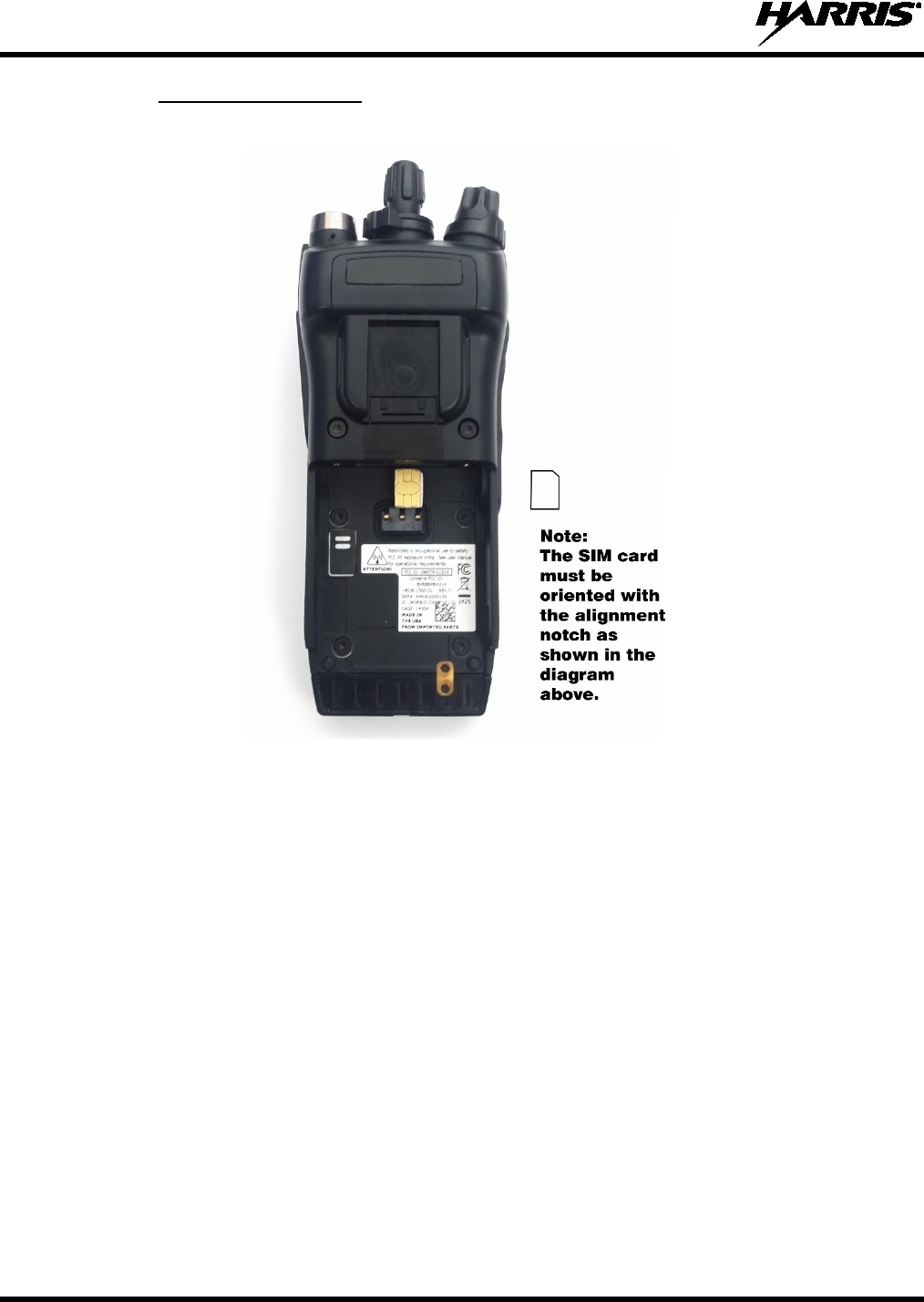HARRIS TR-0151-E XL-185P, 7/800 MHz, PORTABLE LAND MOBILE RADIO, C1D1, Non-Rebanded User Manual 1
HARRIS CORPORATION XL-185P, 7/800 MHz, PORTABLE LAND MOBILE RADIO, C1D1, Non-Rebanded 1
HARRIS >
Contents
- 1. User Manual 1
- 2. User Manual 2
User Manual 1
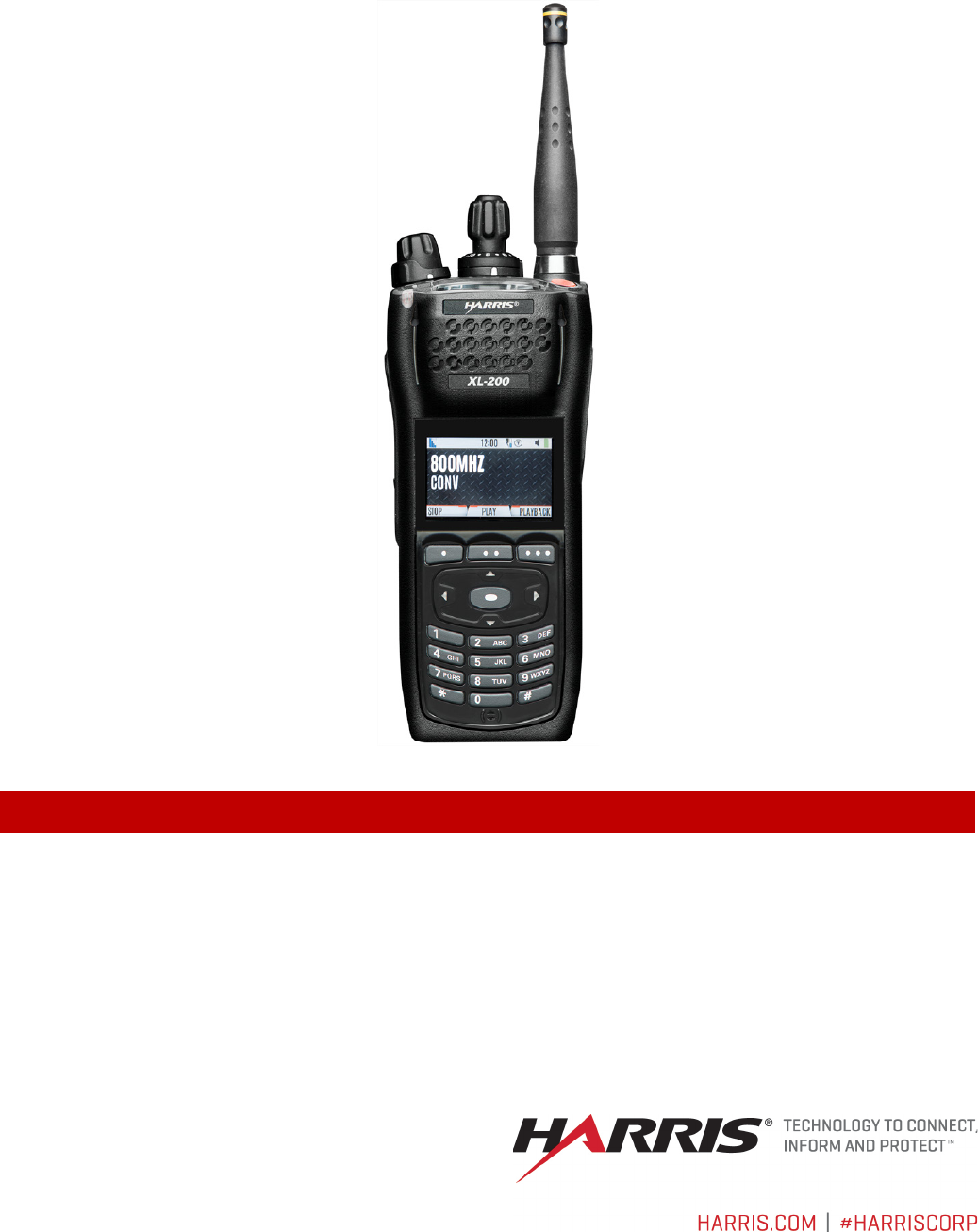
Operator’s Manual
14221-1800-2000
Rev. G, July 2017
XL-200P Full-Spectrum Multiband
XL-185P Single Band
Portable Radios
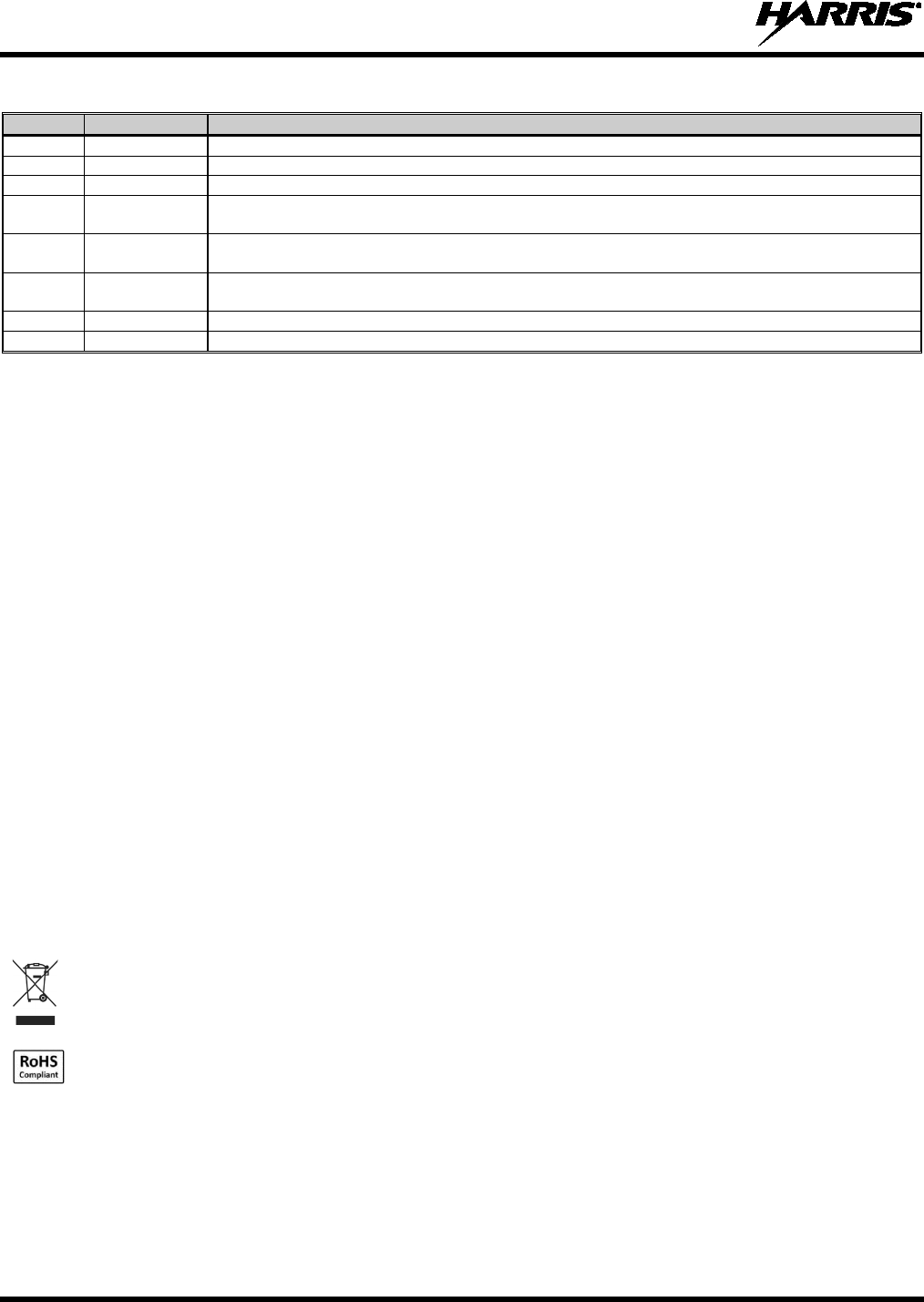
14221-1800-2000, Rev. G
2
MANUAL REVISION HISTORY
REV.
DATE
REASON FOR CHANGE
-
Sep/15
Initial release.
A
Sep/15
Added Section 3.
B
Nov/15
Added CE information.
C Jan/16
Updated Declaration of Conformity. Added EU regulatory approval information (standards) and
EU RF exposure information.
D Jul/16
Updated Table 1-1 and Tableau 2-1. Updated for XLP R2A. Added note to Section 4.3.1
regarding charging the battery before first use. Updated Appendix A. Updated Section 4.3.3.
E Jan/17
Updated Sections 1.2, 4.1, 4.6, 5.8, 5.12, 10, included XLP R3A features, and added Sections
4.3.4, 5.35, and 5.6.
F
Apr/17
Updated to add XLP R4A features.
G
Jul/17
Added XL-185P, XLP R5A features, and C1D1 information.
ACKNOWLEDGEMENT
This product was developed using GEOTRANS, a product of the National Geospatial Intelligence Agency and U.S. Army Engineering
Research and Development Center. Use of this software does not indicate endorsement or approval of the product by the Secretary of
Defense or the National Geospatial Intelligence Agency.
This device made under license under one or more of the following US patents: 4,590,473; 4,636,791; 5,148,482; 5,185,796; 5,271,017;
5,377,229; 4,716,407; 4,972,460; 5,502,767; 5,146,697; 5,164,986; 5,185,795.
The Advanced Multi-Band Excitation implementation 2 (AMBE+2) voice coding Technology embodied in this product is protected by
intellectual property rights including patent rights, copyrights and trade secrets of Digital Voice Systems, Inc. This voice coding
Technology is licensed solely for use within this Communications Equipment. The user of this Technology is explicitly prohibited from
attempting to extract, remove, decompile, reverse engineer, or disassemble the Object Code, or in any other way convert the Object Code
into a human-readable form. U.S. Patent Nos. #5,870,405, #5,826,222, #5,754,974, #5,701,390, #5,715,365, #5,649,050, #5,630,011,
#5,581,656, #5,517,511, #5,491,772, #5,247,579, #5,226,084 and #5,195,166.
CREDITS
Harris, Unity, VIDA, EDACS, NetworkFirst, and OpenSky are registered trademarks of Harris Corporation. TECHNOLOGY TO
CONNECT, INFORM AND PROTECT is a trademark of Harris Corporation.
Bluetooth is a registered trademark of Bluetooth SIG, Inc.
Motorola is a registered trademark of Motorola, Inc.
AMBE is a registered trademark and IMBE, AMBE+, and AMBE+2 are trademarks of Digital Voice Systems, Inc.
Wi-Fi is a registered trademark of Wi-Fi Alliance.
All brand and product names are trademarks, registered trademarks, or service marks of their respective holders.
NOTICE!
The material contained herein is subject to U.S. export approval. No export or re-export is permitted without written approval from the U.S.
Government. Rated: EAR99; in accordance with U.S. Dept. of Commerce regulations 15CFR774, Export Administration Regulations.
Information and descriptions contained herein are the property of Harris Corporation. Such information and descriptions may not be copied
or reproduced by any means, or disseminated or distributed without the express prior written permission of Harris Corporation, PSPC
Business, 221 Jefferson Ridge Parkway, Lynchburg, VA 24501.
Repairs to this equipment should be made only by an authorized service technician or facility designated by the supplier. Any repairs,
alterations or substitutions of recommended parts made by the user to this equipment not approved by the manufacturer could void the
user's authority to operate the equipment in addition to the manufacturer's warranty.
This product conforms to the European Union WEEE Directive 2012/19/EU. Do not dispose of this product in a public
landfill. Take it to a recycling center at the end of its life.
Harris products comply with the Restriction of the Use of Certain Hazardous Substances in Electrical and Electronic
Equipment (RoHS) Directive.
This manual is published by Harris Corporation without any warranty. Improvements and changes to this manual necessitated by typographical errors,
inaccuracies of current information, or improvements to programs and/or equipment, may be made by Harris Corporation at any time and without notice.
Such changes will be incorporated into new editions of this manual. No part of this manual may be reproduced or transmitted in any form or by any means,
electronic or mechanical, including photocopying and recording, for any purpose, without the express written permission of Harris Corporation.
Copyright © 2015-2017 Harris Corporation.
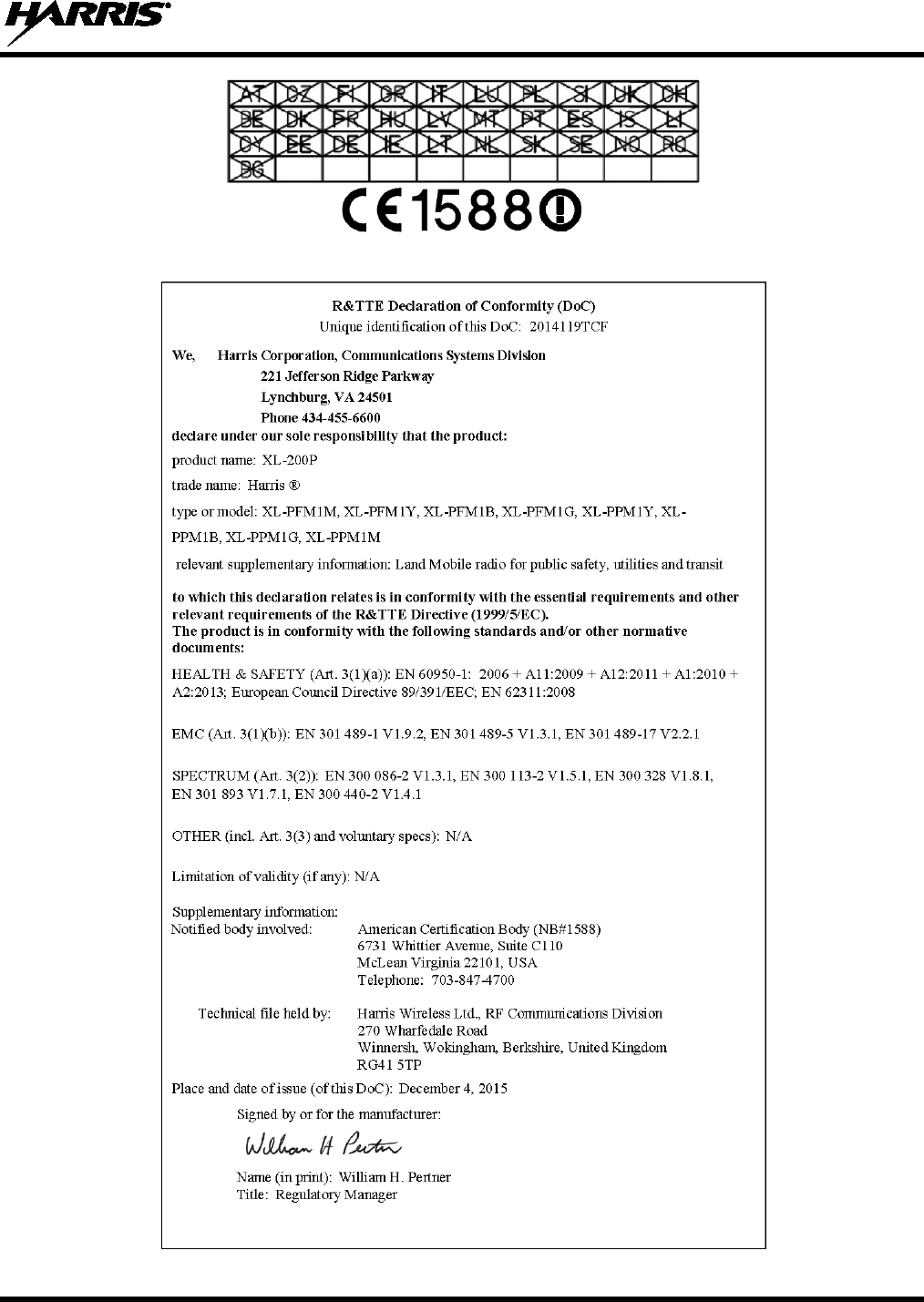
14221-1800-2000, Rev. G
3
This device is a RF transceiver intended for land mobile radio applications. The device may have use restrictions, which require that the
national authority be contacted for any system licensing requirements, frequency use, allowable power level, etc.
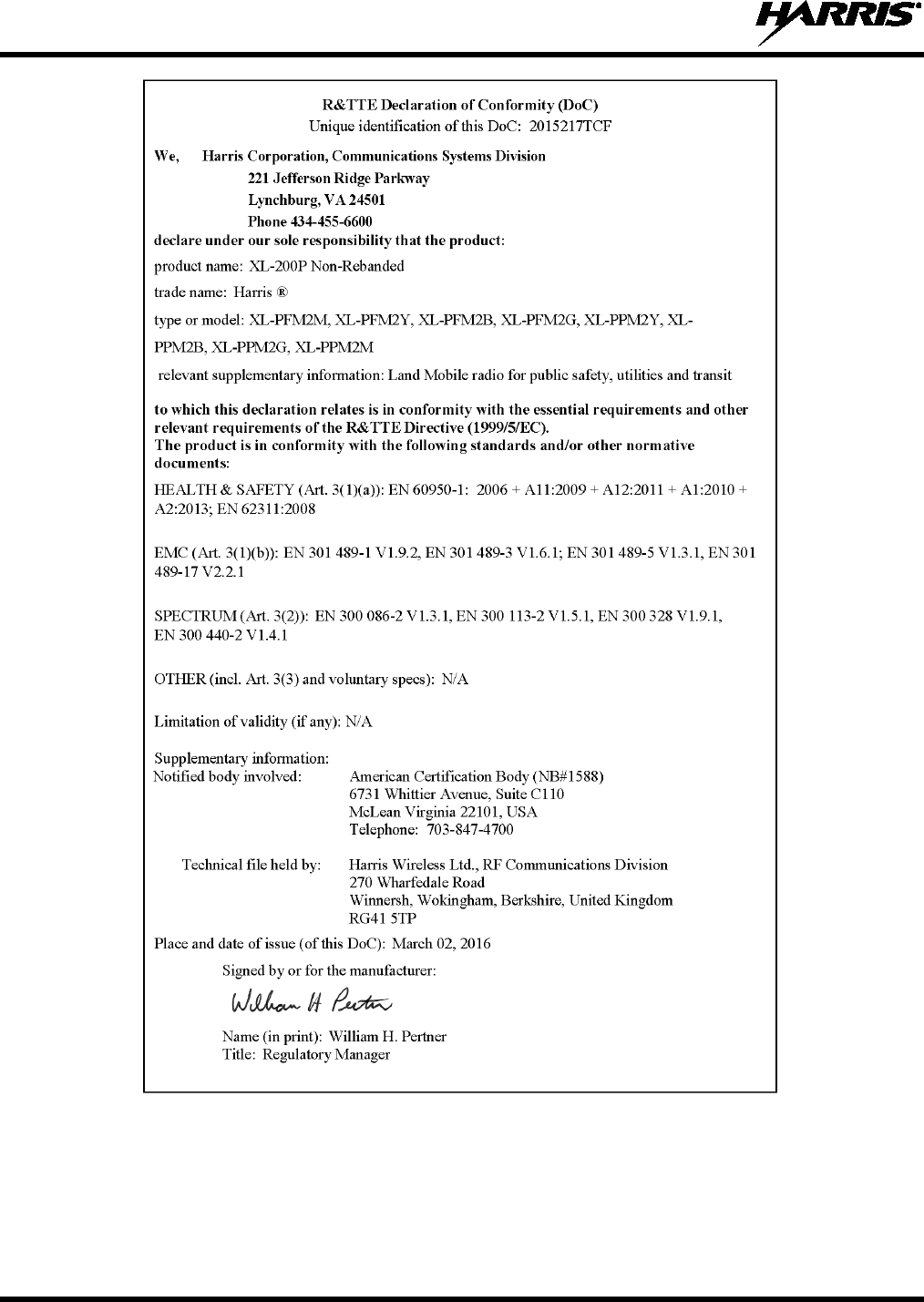
14221-1800-2000, Rev. G
4

14221-1800-2000, Rev. G
5
DECLARATION OF CONFORMITY
Česky [Czech]
Harris Corporation tímto prohlašuje, že tento XL-200P je ve shodě se základními požadavky a
dalšími příslušnými ustanoveními směrnice 1999/5/ES.
Dansk [Danish] Undertegnede Harris Corporation
erklærer herved, at følgende udstyr XL-200P overholder de
væsentlige krav og øvrige relevante krav i direktiv 1999/5/EF.
Deutsch
[German]
Hiermit erklärt
Harris Corporation,
dass sich das Gerät XL-200P in Übereinstimmung mit den
grundlegenden Anforderungen und den übrigen einschlägigen Bestimmungen der Richtlinie
1999/5/EG befindet.
Eesti [Estonian] Käesolevaga kinnitab Harris Corporation seadme XL-200P vastavust direktiivi 1999/5/EÜ
põhinõuetele ja nimetatud direktiivist tulenevatele teistele asjakohastele sätetele.
English
Hereby,
Harris Corporation
, declares that this
XL-200P
is in compliance with the essential
requirements and other relevant provisions of Directive 1999/5/EC.
Español
[Spanish]
Por medio de la presente Harris Corporation declara que el XL-200P cumple con los requisitos
esenciales y cualesquiera otras disposiciones aplicables o exigibles de la Directiva 1999/5/CE.
Ελληνική
[Greek]
ΜΕ ΤΗΝ ΠΑΡΟΥΣΑ Harris Corporation ΔΗΛΩΝΕΙ ΟΤΙ XL-200P ΣΥΜΜΟΡΦΩΝΕΤΑΙ ΠΡΟΣ ΤΙΣ
ΟΥΣΙΩΔΕΙΣ ΑΠΑΙΤΗΣΕΙΣ ΚΑΙ ΤΙΣ ΛΟΙΠΕΣ ΣΧΕΤΙΚΕΣ ΔΙΑΤΑΞΕΙΣ ΤΗΣ ΟΔΗΓΙΑΣ 1999/5/ΕΚ.
Français
[French]
Par la présente Harris Corporation déclare que l'appareil XL-200P est conforme aux exigences
essentielles et aux autres dispositions pertinentes de la directive 1999/5/CE.
Italiano [Italian] Con la presente Harris Corporation
dichiara che questo XL-200P
è conforme ai requisiti
essenziali ed alle altre disposizioni pertinenti stabilite dalla direttiva 1999/5/CE.
Latviski
[Latvian]
Ar šo Harris Corporation deklarē, XG 25P UHF-L (378-470 MHz), 7/800 (764-870MHz) atbilst
Direktīvas 1999/5/EK būtiskajām prasībām un citiem ar to saistītajiem noteikumiem.
Lietuvių
[Lithuanian]
Šiuo Harris Corporation deklaruoja, kad šis XL-200P atitinka esminius reikalavimus ir kitas
1999/5/EB Direktyvos nuostatas.
Nederlands
[Dutch]
Hierbij verklaart Harris Corporation
dat het toestel XL-200P in overeenstemming is met de
essentiële eisen en de andere relevante bepalingen van richtlijn 1999/5/EG.
Malti [Maltese]
Hawnhekk, Harris Corporation, jiddikjara li dan XL-200P jikkonforma mal-ħtiġijiet essenzjali u ma
provvedimenti oħrajn relevanti li hemm fid-Dirrettiva 1999/5/EC.
Magyar
[Hungarian]
Alulírott, Harris Corporation nyilatkozom, hogy a XL-200P megfelel a vonatkozó alapvetõ
követelményeknek és az 1999/5/EC irányelv egyéb elõírásainak.
Polski [Polish]
Niniejszym Harris Corporation oświadcza, że XL-200P jest zgodny z zasadniczymi wymogami
oraz pozostałymi stosownymi postanowieniami Dyrektywy 1999/5/EC.
Português
[Portuguese]
Harris Corporation
declara que este XL-200P
está conforme com os requisitos essenciais e
outras disposições da Directiva 1999/5/CE.
Slovensko
[Slovenian]
Harris Corporation
izjavlja, da je ta
XL-200P
v skladu z bistvenimi zahtevami in ostalimi
relevantnimi določili direktive 1999/5/ES.
Slovensky
[Slovak]
Harris Corporation týmto vyhlasuje, že XL-200P spĺňa základné požiadavky a všetky príslušné
ustanovenia Smernice 1999/5/ES.
Suomi [Finnish]
Harris Corporation vakuuttaa täten että XL-200P tyyppinen laite on direktiivin 1999/5/EY
oleellisten vaatimusten ja sitä koskevien direktiivin muiden ehtojen mukainen.
Svenska
[Swedish]
Härmed intygar Harris Corporation
att denna XL-200P
står I överensstämmelse med de
väsentliga egenskapskrav och övriga relevanta bestämmelser som framgår av direktiv 1999/5/EG.
Íslenska
[Icelandic]
Hér með lýsir Harris Corporation
yfir því að XL-200P
er í samræmi við grunnkröfur og aðrar
kröfur, sem gerðar eru í tilskipun 1999/5/EC.
Norsk
[Norwegian]
Harris Corporation erklærer herved at utstyret XL-200P er i samsvar med de grunnleggende krav
og øvrige relevante krav i direktiv 1999/5/EF.

14221-1800-2000, Rev. G
6
TABLE OF CONTENTS
Section Page
1. REGULATORY AND SAFETY INFORMATION ........................................................................... 11
1.1 SAFETY CONVENTIONS ........................................................................................................ 11
1.2 SAFETY TRAINING INFORMATION .................................................................................... 11
1.2.1 RF Exposure Guidelines ................................................................................................ 12
1.2.2 Electromagnetic Interference/Compatibility .................................................................. 13
1.3 REGULATORY APPROVALS ................................................................................................. 14
1.3.1 Part 15 ............................................................................................................................ 14
1.3.2 Industry Canada ............................................................................................................. 14
1.4 OPERATING TIPS .................................................................................................................... 14
1.4.1 Efficient Radio Operation .............................................................................................. 14
1.4.2 Antenna Care and Replacement ..................................................................................... 14
1.4.3 Electronic Devices ......................................................................................................... 15
1.4.4 Aircraft ........................................................................................................................... 15
1.4.5 Electric Blasting Caps .................................................................................................... 15
1.4.6 Potentially Explosive Atmospheres ............................................................................... 15
2. RENSEIGNEMENTS SUR LA RÉGLEMENTATION ET SÉCURITÉ ....................................... 16
2.1 CONVENTIONS SUR LES SYMBOLES DE SÉCURITÉ ...................................................... 16
2.2 RENSEIGNEMENTS SUR LA FORMATION SUR LA SÉCURITÉ ...................................... 16
2.2.1 Directives sur l’exposition aux RF ................................................................................ 17
2.2.2 Interférence/Compatibilité Électromagnétique .............................................................. 18
2.3 INTERFÉRENCE DES RADIOFRÉQUENCES ....................................................................... 18
2.3.1 Partie 15 de la FCC ........................................................................................................ 18
2.3.2 Industrie Canada ............................................................................................................ 18
2.4 CONSEILS D’UTILISATION ................................................................................................... 18
2.4.1 Utilisation Efficace de la Radio ..................................................................................... 18
3. HAZARDOUS LOCATIONS .............................................................................................................. 21
3.1 CLASS 1, DIVISION 2 OPTION ............................................................................................... 21
3.2 CLASS 1, DIVISION 1 OPTION ............................................................................................... 22
4. INTRODUCTION ................................................................................................................................ 25
4.1 DESCRIPTION .......................................................................................................................... 25
4.2 STORAGE GUIDELINES ......................................................................................................... 25
4.3 BASIC SETUP ........................................................................................................................... 26
4.3.1 Assemble the Radio ....................................................................................................... 26
4.3.2 Removing the Battery .................................................................................................... 27
4.3.3 Removing the Optional Belt Clip or D-Post .................................................................. 27
4.3.4 Install the SIM Card ....................................................................................................... 28
4.4 UNIVERSAL DEVICE CONNECTOR ..................................................................................... 29
4.5 CLEANING ................................................................................................................................ 29
4.6 OPTIONS AND ACCESSORIES .............................................................................................. 30
4.7 RELATED PUBLICATIONS .................................................................................................... 33
5. BASIC OPERATION ........................................................................................................................... 34
5.1 RADIO CONTROLS .................................................................................................................. 34
5.2 SOFT DTMF KEYPAD ............................................................................................................. 36
5.3 BEFORE FIRST USE ................................................................................................................. 36
5.4 POWER ON AND SET VOLUME ............................................................................................ 37
5.5 RADIO DISPLAYS .................................................................................................................... 37
5.5.1 Top Display ................................................................................................................... 37

14221-1800-2000, Rev. G
7
TABLE OF CONTENTS
Section Page
5.5.2 Front Display ................................................................................................................. 38
5.6 MANDOWN............................................................................................................................... 40
5.7 STATUS MESSSAGES ............................................................................................................. 40
5.8 PREDEFINED MENU LAYOUTS............................................................................................ 41
5.9 MENU ........................................................................................................................................ 42
5.10 ALERT TONES.......................................................................................................................... 45
5.11 SELECT ZONE/SYSTEM ......................................................................................................... 46
5.12 SELECT GROUP/CHANNEL AND BANK ............................................................................. 47
5.13 LOCK/UNLOCK KEYPAD....................................................................................................... 47
5.14 GROUP CALLS ......................................................................................................................... 48
5.14.1 Transmit a Group Call ................................................................................................... 48
5.14.2 Receive a Group Call ..................................................................................................... 48
5.15 INDIVIDUAL CALLS ............................................................................................................... 49
5.15.1 Transmit an Individual Call ........................................................................................... 49
5.15.2 Receiving an Individual Call ......................................................................................... 49
5.16 USER PROFILES ....................................................................................................................... 50
5.17 NOISE CANCELLATION ......................................................................................................... 51
5.17.1 Enable Noise Cancellation ............................................................................................. 51
5.17.2 Using Noise Cancellation .............................................................................................. 52
5.17.3 The Effect of Distance from the Microphone ................................................................ 52
5.17.4 Primary versus Secondary Microphone ......................................................................... 52
5.17.5 When using an SCBA Mask .......................................................................................... 52
5.18 PTT OPTIONS ........................................................................................................................... 53
5.19 VOICE ANNUNCIATION ........................................................................................................ 53
5.20 ENABLE/DISABLE ENCRYPTION ........................................................................................ 54
5.21 TRANSMIT ENABLE/DISABLE ............................................................................................. 54
5.22 CHANNEL GUARD (ANALOG CONVENTIONAL ONLY) ................................................. 55
5.23 USE TALKAROUND TO BYPASS REPEATER (ANALOG AND P25 CONVENTIONAL
ONLY) ........................................................................................................................................ 56
5.24 TYPE 99 OPERATION .............................................................................................................. 57
5.24.1 Enable/Disable Type 99 ................................................................................................. 57
5.24.2 Disable After PTT.......................................................................................................... 58
5.24.3 Auto Reset ..................................................................................................................... 58
5.25 CALL ALERT (PAGE) .............................................................................................................. 58
5.25.1 Send Alert ...................................................................................................................... 58
5.25.2 Receive Alert ................................................................................................................. 58
5.26 DTMF ......................................................................................................................................... 58
5.27 AUDIO PLAYBACK ................................................................................................................. 59
5.28 START SCAN ............................................................................................................................ 60
5.29 STOP SCAN ............................................................................................................................... 61
5.30 MONITOR AND SQUELCH TYPES (CONVENTIONAL ONLY) ........................................ 62
5.31 NUISANCE DELETE ................................................................................................................ 63
5.32 CONVENTIONAL FAILSOFT (EDACS ONLY) .................................................................... 64
5.33 EMERGENCY OPERATION .................................................................................................... 65
5.33.1 Declaring an Emergency Call ........................................................................................ 65
5.33.2 Receiving an Emergency Call ....................................................................................... 65
5.33.3 Stealth Emergency ......................................................................................................... 66
5.34 MDC-1200 (ANALOG CONVENTIONAL ONLY) ................................................................. 66

14221-1800-2000, Rev. G
8
TABLE OF CONTENTS
Section Page
5.34.1 Normal PTT Operation .................................................................................................. 66
5.34.2 MDC PTT ID Receive Handling ................................................................................... 66
5.34.3 Emergency Declaration ................................................................................................. 66
5.35 BEON OPERATION .................................................................................................................. 67
6. ADVANCED OPERATIONS .............................................................................................................. 68
6.1 VIEW/CHANGE PERSONALITIES ......................................................................................... 68
6.1.1 View Personalities ......................................................................................................... 68
6.1.2 Change Active Personality ............................................................................................ 69
6.2 SITUATIONAL AWARENESS (SA) – P25 CONVENTIONAL ONLY ................................. 70
6.3 USER-DEFINED ZONES/SYSTEMS ....................................................................................... 71
6.3.1 Command Tactical Zone ................................................................................................ 71
6.3.2 Mixed System Zone ....................................................................................................... 72
6.4 CH INFO MENU ........................................................................................................................ 73
6.5 AUDIO SETTINGS .................................................................................................................... 73
6.6 DISPLAY SETTINGS ................................................................................................................ 74
6.7 GPS SETTINGS ......................................................................................................................... 76
6.8 POSITION INFO ........................................................................................................................ 76
6.9 WI-FI .......................................................................................................................................... 77
6.10 BLUETOOTH ............................................................................................................................ 78
6.10.1 Enable Bluetooth ........................................................................................................... 78
6.10.2 Pair Devices ................................................................................................................... 79
6.11 CLOCK SETTINGS ................................................................................................................... 80
6.12 BATTERY INFO ........................................................................................................................ 80
6.13 SELECT LANGUAGE............................................................................................................... 81
6.14 SET UP SCAN ........................................................................................................................... 81
6.14.1 Default, Priority 1, and Priority 2 Channels .................................................................. 82
6.14.2 Trunked/Conventional Scanning ................................................................................... 82
6.14.3 Vote Scan (Analog and P25 Conventional Only) .......................................................... 83
6.14.4 Edit Scan List ................................................................................................................. 83
6.14.5 Set or Remove Priority 1 and Priority 2 Channels ......................................................... 84
6.14.6 Custom Scan Lists ......................................................................................................... 85
6.14.7 Wide Area System Scan (P25 Trunked and EDACS) ................................................... 87
6.15 RADIO STATUS ........................................................................................................................ 87
6.16 RADIO MESSAGE .................................................................................................................... 88
6.17 RADIO TEXTLINK ................................................................................................................... 89
6.17.1 Radio TextLink Messages ............................................................................................. 90
6.17.2 Radio TextLink Forms ................................................................................................... 90
6.17.3 View Received Messages .............................................................................................. 91
6.18 FAULTS/ALERTS ..................................................................................................................... 91
6.19 TONE ENCODE ........................................................................................................................ 92
6.20 ENCRYPTION ........................................................................................................................... 93
6.20.1 Create and Load Keys .................................................................................................... 93
6.20.2 Zeroize Keys from Radio ............................................................................................... 93
6.20.3 Protected Keys ............................................................................................................... 93
6.20.4 Global Encryption .......................................................................................................... 94
6.20.5 Select Keyset ................................................................................................................. 95
6.20.6 View Key List ................................................................................................................ 95
6.20.7 Delete Individual Keys .................................................................................................. 95

14221-1800-2000, Rev. G
9
TABLE OF CONTENTS
Section Page
6.20.8 OTAR Configuration ..................................................................................................... 96
6.21 SITE ALIAS AND SITE LOCK (P25 TRUNKED ONLY) ...................................................... 96
7. PROGRAMMING ................................................................................................................................ 97
7.1 PROGRAMMING VIA RPM2 .................................................................................................. 97
7.2 EDIT CHANNEL (ANALOG AND P25 CONVENTIONAL ONLY) ..................................... 97
7.3 OTAP .......................................................................................................................................... 99
7.4 PROGRAMMABLE BUTTONS AND SWITCHES ................................................................. 99
7.4.1 Programmable Buttons .................................................................................................. 99
7.4.2 Programmable A/B (Ø/O) Switch ............................................................................... 101
7.4.3 Programmable A/B/C/D Switch .................................................................................. 101
7.5 PROGRAMMABLE ICONS .................................................................................................... 102
7.5.1 Top display .................................................................................................................. 102
7.5.2 Front display ................................................................................................................ 103
8. REFERENCE ...................................................................................................................................... 105
8.1 MARINE FREQUENCIES ...................................................................................................... 105
8.2 NARROWBANDING .............................................................................................................. 110
9. GLOSSARY ........................................................................................................................................ 111
10. BASIC TROUBLESHOOTING ........................................................................................................ 114
10.1 ERROR MESSAGES ............................................................................................................... 114
10.2 OTAR ERRORS/INFORMATION .......................................................................................... 115
11. TECHNICAL ASSISTANCE ............................................................................................................ 116
12. WARRANTY ...................................................................................................................................... 116
APPENDIX A WI-FI PROGRAMMING ......................................................................................... 117
LIST OF FIGURES
Page
Figure 4-1: Radio Assembly .......................................................................................................................... 26
Figure 4-2: Remove the Battery ..................................................................................................................... 27
Figure 4-3: Remove Belt Clip ........................................................................................................................ 27
Figure 4-4: SIM Card Installation .................................................................................................................. 28
Figure 4-5: Universal Device Connector ....................................................................................................... 29
Figure 5-1: Radio Controls ............................................................................................................................ 34
Figure 5-2: Using the Soft DTMF Keypad .................................................................................................... 36
Figure 5-3: Top Display ................................................................................................................................. 37
Figure 5-4: Sample Idle Front Display .......................................................................................................... 38
Figure 5-5: Using Noise Cancellation ............................................................................................................ 52
Figure 6-1: Enabling Wi-Fi ............................................................................................................................ 77
Figure 6-2: Wi-Fi Install Active ..................................................................................................................... 78
Figure A-1: Options Network Configuration .......................................................................................... 118
Figure A-2: Wi-Fi Configuration ................................................................................................................. 118
Figure A-3: Service Name ........................................................................................................................... 119
Figure A-4: Enable Wi-Fi in RPM2 ............................................................................................................. 119
Figure A-5: Enable Wi-Fi Programming Mode on Radio ........................................................................... 120
Figure A-6: RPM2 Radio Tab: Wi-Fi .......................................................................................................... 121

14221-1800-2000, Rev. G
10
LIST OF TABLES
Page
Table 1-1: RF Exposure Compliance Tested Distances (Worst Case Scenario) ............................................ 12
Table 1-2: Simultaneous Transmission Scenarios ......................................................................................... 13
Tableau 2-1 : Distances de test de conformité des expositions aux RF (pire des scénarios) ......................... 17
Table 4-1: Options and Accessories ............................................................................................................... 30
Table 5-1: Radio Controls, Indicators, and Connectors ................................................................................. 34
Table 5-2: Radio Icons ................................................................................................................................... 38
Table 5-3: Status Messages ............................................................................................................................ 40
Table 5-4: Predefined Menu Layouts ............................................................................................................. 41
Table 5-5: Menu Navigation ......................................................................................................................... 42
Table 5-6: Alert Tones ................................................................................................................................... 45
Table 7-1: Valid Frequency Ranges ............................................................................................................... 99
Table 7-2: Programmable Button Options ................................................................................................... 100
Table 7-3: Programmable Ø/O Switch Options ........................................................................................... 101
Table 7-4: Single-Instance Features ............................................................................................................. 101
Table 7-5: Indexed Features ......................................................................................................................... 102
Table 8-1: Marine Frequencies .................................................................................................................... 105
Table 10-1: Displayed Error Messages, Reasons, and Resolutions ............................................................ 114
Table 12-1: Wi-Fi Feature Support .............................................................................................................. 121
Harris Corporation, Public Safety and Professional Communications (PSPC) Business continually evaluates its technical publications for
completeness, technical accuracy, and organization. You can assist in this process by submitting your comments and suggestions to the
following:
Harris Corporation fax your comments to: 1-434-455-6851
PSPC Business or
Technical Publications e-mail us at: PSPC_TechPubs@harris.com
221 Jefferson Ridge Parkway
Lynchburg, VA 24501
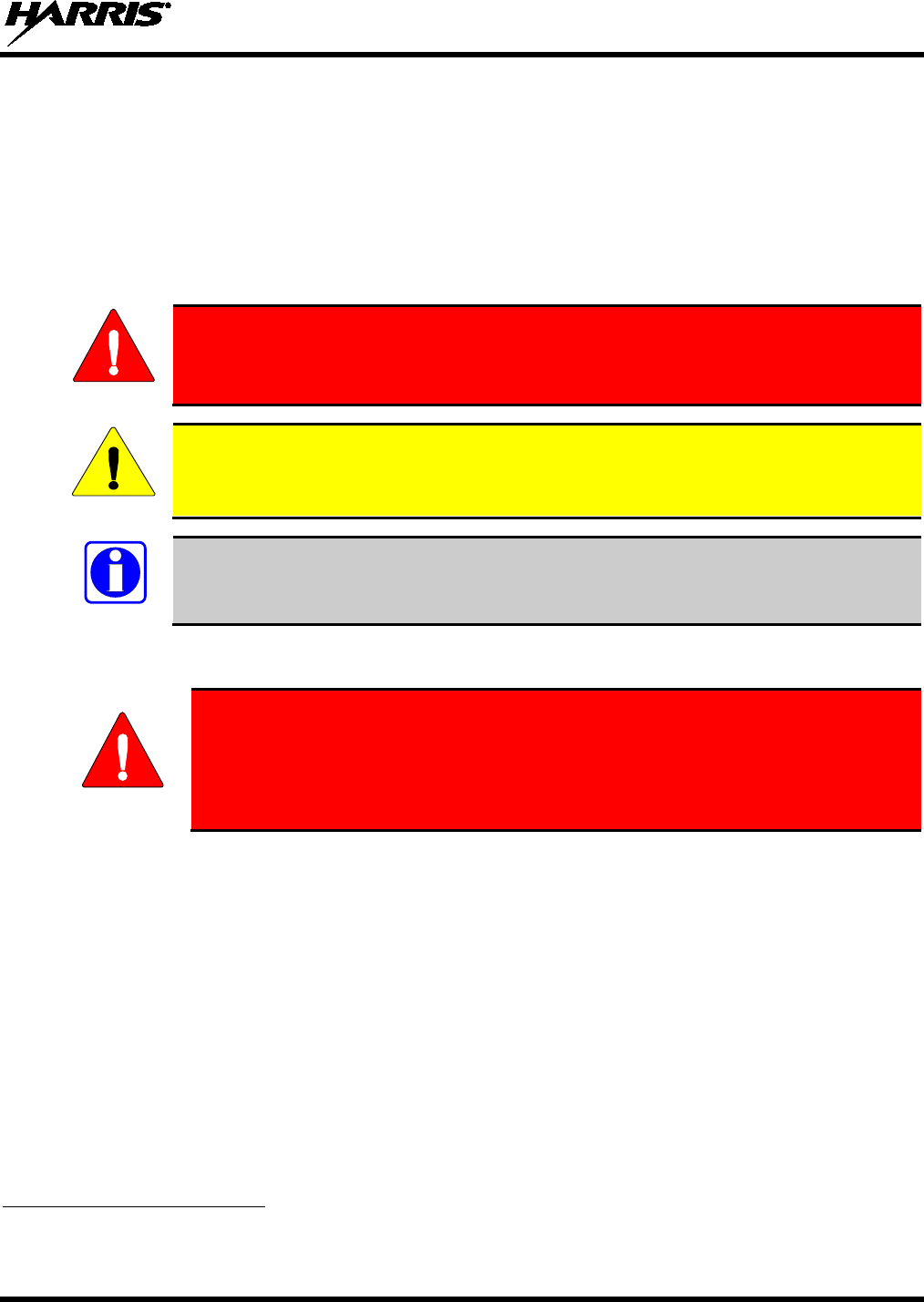
14221-1800-2000, Rev. G
11
1. REGULATORY AND SAFETY INFORMATION
1.1 SAFETY CONVENTIONS
The following conventions are used throughout this manual to alert the user to general safety precautions
that must be observed during all phases of operation, service, and repair of this product. Failure to comply
with these precautions or with specific warning elsewhere in this manual violates safety standards of
design, manufacture, and intended use of the product. Harris assumes no liability for the customer’s
failure to comply with these standards.
The WARNING symbol calls attention to a procedure, practice, or the like, which, if
not correctly performed or adhered to, could result in personal injury. Do not
proceed beyond a WARNING symbol until the conditions identified are fully
understood or met.
The CAUTION symbol calls attention to an operating procedure, practice, or the like,
which, if not performed correctly or adhered to, could result in damage to the equipment
or severely degrade the equipment performance.
The NOTE symbol calls attention to supplemental information, which may improve
system performance or clarify a process or procedure.
1.2 SAFETY TRAINING INFORMATION
The Harris XL-200P/XL-185P portable radio generates RF electromagnetic energy
during transmit mode. This radio is designed for and classified as “Occupational
Use Only,” meaning it must be us
ed only during the course of employment by
individuals aware of the hazards and the ways to minimize such hazards. This
radio is NOT intended for use by the “General Population” in an uncontrolled
environment.
The XL-200P/XL-185P portable radio has been tested and complies with the FCC RF exposure limits for
“Occupational Use Only.” In addition, this Harris radio complies with the following Standards and
Guidelines with regard to RF energy and electromagnetic energy levels and evaluation of such levels for
exposure to humans:
• FCC KDB Publication 447498 General RF Exposure Guidance
• American National Standards Institute (C95.1 – 19921), IEEE Standard for Safety Levels with
Respect to Human Exposure to Radio Frequency Electromagnetic Fields, 3 kHz to 300 GHz.
• American National Standards Institute (C95.3 – 1992), IEEE Recommended Practice for the
Measurement of Potentially Hazardous Electromagnetic Fields – RF and Microwave.
• IC Standard RSS-102. Radiofrequency Exposure Compliance of Radiocommunication Apparatus
(All Frequency Bands).
• European Council Directive 89/391/EEC.
1 Tested to ANSI C95.1-1992 in compliance with 47 CFR 2.1093. Meets or exceeds safety requirements of ANSI C95.1-2005.
WARNING
CAUTION
NOTE
WARNING
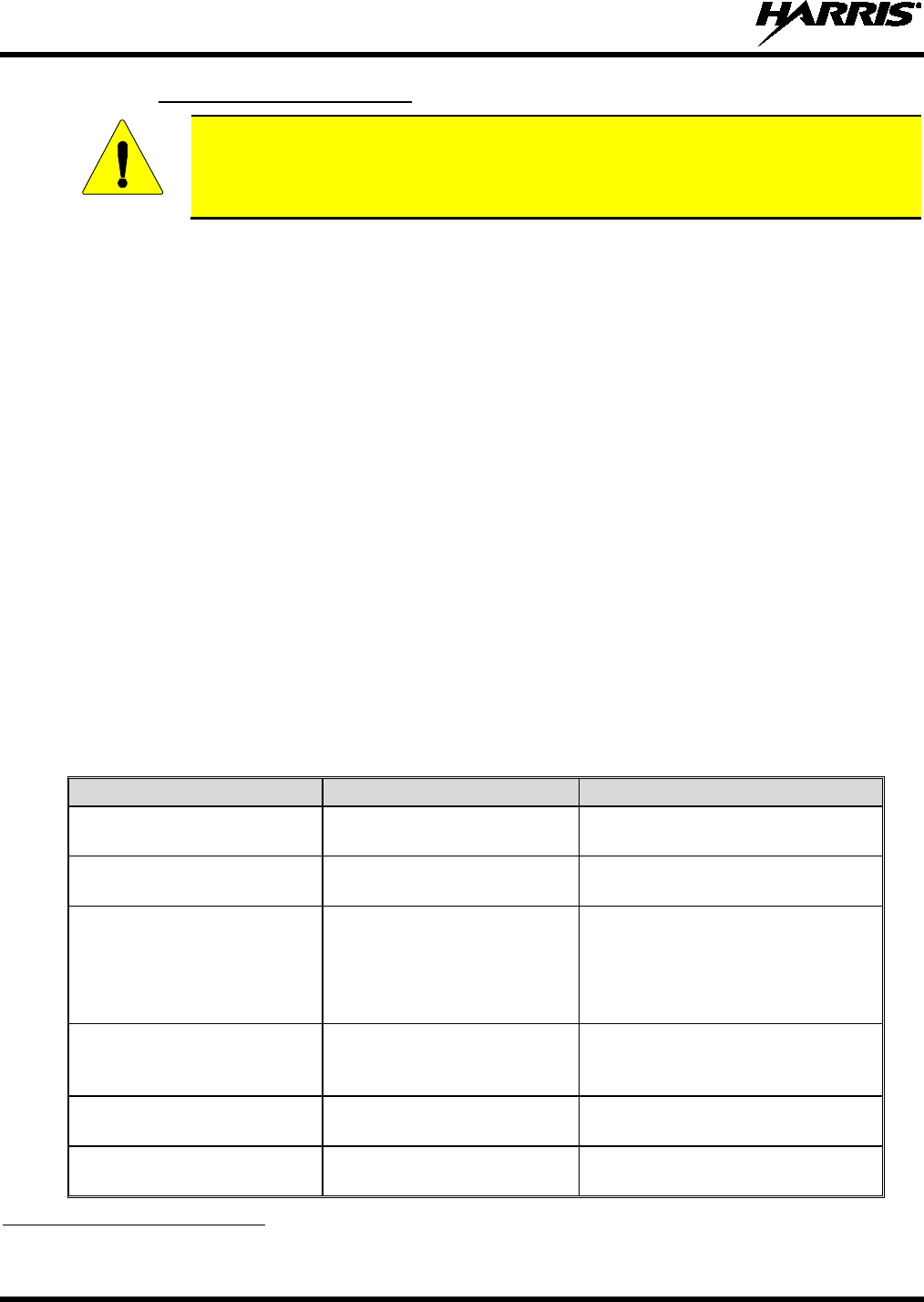
14221-1800-2000, Rev. G
12
1.2.1 RF Exposure Guidelines
To ensure that exposure to RF electromagnetic energy is within the EU/AU/FCC/IC
allowable limits for occupational use, always adhere to the following guidelines:
• DO NOT operate the radio without a proper antenna attached, as this may damage the radio and may
also cause the FCC RF exposure limits to be exceeded. A proper antenna is the antenna supplied with
this radio by Harris or an antenna specifically authorized by Harris for use with this radio. (Refer to
Table 4-1.)
• DO NOT transmit for more than 50% of total radio use time (“50% duty cycle”). Transmitting more
than 50% of the time can cause FCC RF exposure compliance requirements to be exceeded. The radio
is transmitting when the “TX” indicator appears in the display. The radio will transmit by pressing the
“PTT” (Push-To-Talk) button.
• ALWAYS transmit using low power when possible. In addition to conserving battery charge, low
power can reduce RF exposure.
• ALWAYS use Harris authorized accessories (antennas, batteries, belt clips, speaker/mics, etc.). Use
of unauthorized accessories may cause the FCC Occupational/Controlled Exposure RF compliance
requirements to be exceeded. (Refer to Table 1-1.)
• As noted in Table 1-1, ALWAYS keep the housing of the transmitter AT LEAST 0.47 inches (1.2
cm) from the body and at least 0.98 in (2.5 cm) from the face when transmitting to ensure
EU/AU/FCC/IC RF exposure compliance requirements are not exceeded. However, to provide the
best sound quality to the recipients of your transmission, Harris recommends you hold the
microphone at least 2 in (5 cm) from mouth, and slightly off to one side.
• Refer to Standard EN 62311:2008.
Table 1-1: RF Exposure Compliance Tested Distances (Worst Case Scenario)
RADIO FREQUENCY Body2 Face
VHF
(136 - 174 MHz) 0.47 in (1.2 cm) 0.98 in (2.5 cm)
UHF
(378 - 522 MHz) 0.47 in (1.2 cm) 0.98 in (2.5 cm)
700/800 MHz
(768 - 776 MHz)
(798 - 806 MHz)
(806 - 824 MHz)
(851 - 870 MHz)
0.47 in (1.2 cm) 0.98 in (2.5 cm)
900 MHz
(935-944 MHz)
(896-902 MHz)
0.47 in (1.2 cm) 0.98 in (2.5 cm)
2400 MHz
(2412 - 2472 MHz) 0.47 in (1.2 cm) 0.98 in (2.5 cm)
5 GHz
(5.18 - 5.825 GHz) 0.47 in (1.2 cm) 0.98 in (2.5 cm)
2 This is worst case based on the thinnest body mount accessory (belt clip).
CAUTION
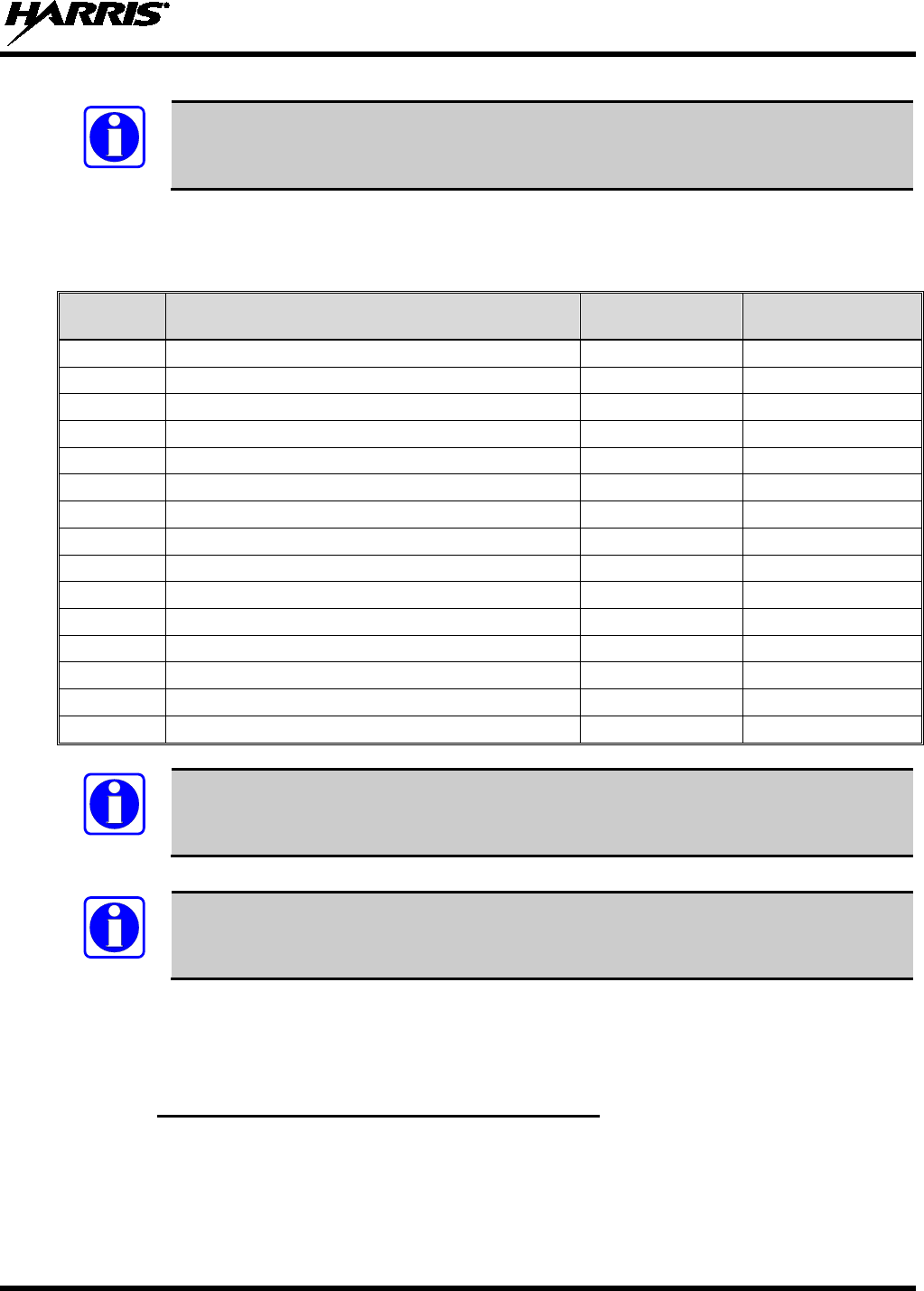
14221-1800-2000, Rev. G
13
SAR Evaluation: 1g averaged, 50% PTT Duty Factor, Occupational/Controlled Exposure.
This device contains multiple transmitters that may operate simultaneously, see Table 1-2 Simultaneous
Transmission Scenarios for the capable transmit configurations.
Table 1-2: Simultaneous Transmission Scenarios
NO. CAPABLE TRANSMIT CONFIGURATION HEAD BODY-WORN
ACCESSORY
1 LTE B13/14/4 + VHF
YES
YES
2 LTE B13/14/4 + UHF
YES
YES
3 LTE B14 + 800 MHz
YES
YES
4 LTE B13/14/4 + Bluetooth
YES
YES
5 LTE B13/14/4 + 2.4 GHz WLAN
YES
YES
6 LTE B13/14/4 + 5 GHz WLAN
YES
YES
7 LTE B13/14/4 + VHF + Bluetooth
YES
YES
8 LTE B13/14/4 + UHF + Bluetooth
YES
YES
9 LTE B14 + 800 MHz + Bluetooth
YES
YES
10 LTE B13/14/4 + VHF + WLAN
YES
YES
11 LTE B13/14/4 + UHF + WLAN
YES
YES
12 LTE B14 + 800 MHz + WLAN
YES
YES
13 LTE B13/14/4 + 900 MHz (XL-185P Only)
YES
YES
14 LTE B13/14/4 + 900 MHz + Bluetooth
YES
YES
15 LTE B13/14/4 + 900 MHz + WLAN
YES
YES
LTE B13/14/4 + 700 MHz simultaneous transmission is not supported by this device.
LTE B13/4 + 800 MHz simultaneous transmission is not supported by
LTE is not supported by the XL Portable with the C1D1 option.
The information in this section provides the information needed to make the user aware of RF exposure,
and what to do to assure that this radio operates within the FCC RF exposure limits.
1.2.2 Electromagnetic Interference/Compatibility
During transmissions, this Harris radio generates RF energy that can possibly cause interference with
other devices or systems. To avoid such interference, turn off the radio in areas where signs are posted to
do so. DO NOT operate the transmitter in areas that are sensitive to electromagnetic radiation such as
hospitals, aircraft, and blasting sites.
NOTE
NOTE
NOTE
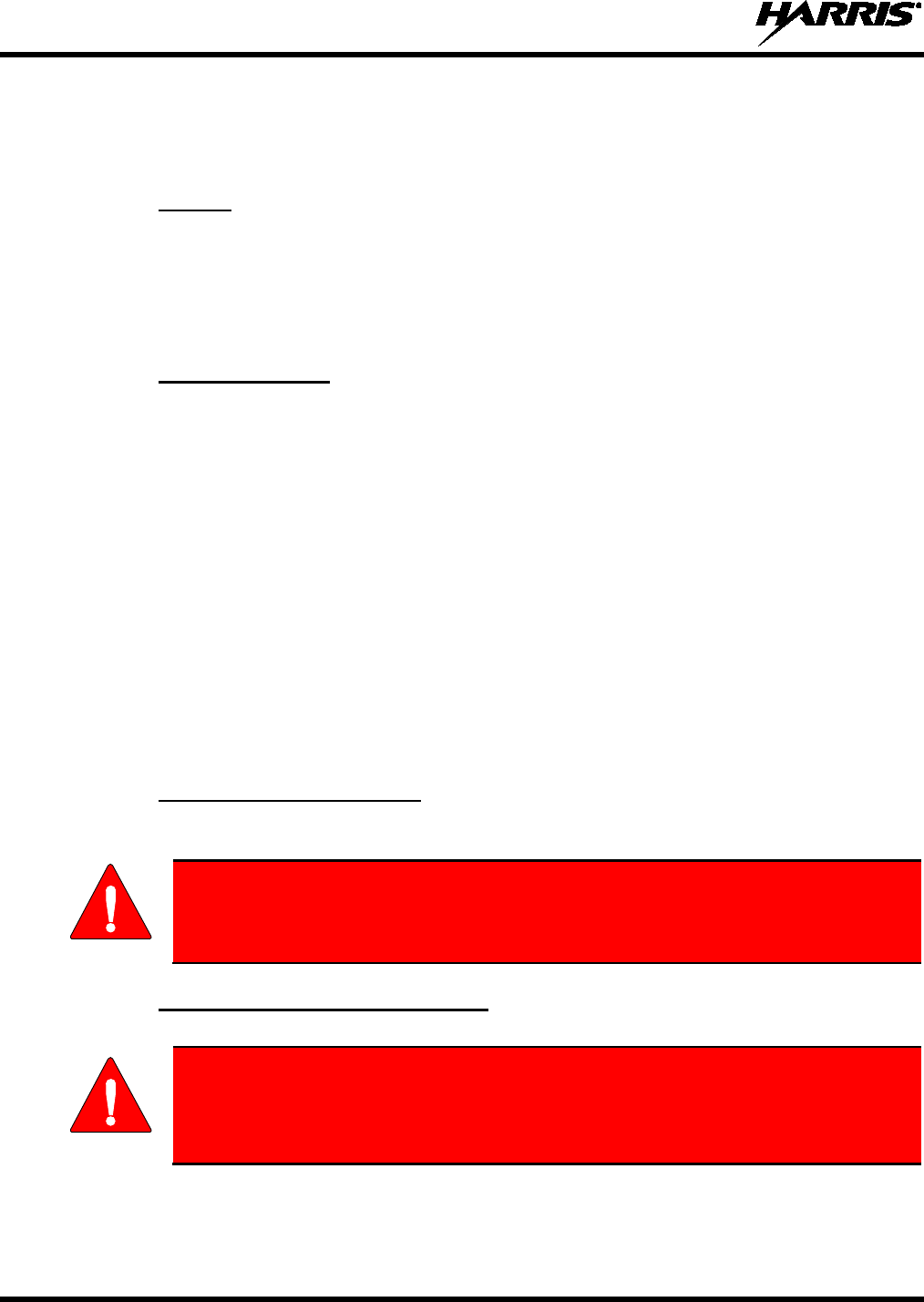
14221-1800-2000, Rev. G
14
1.3 REGULATORY APPROVALS
Changes or modifications not expressly approved by the manufacturer could void the user’s authority to
operate the equipment.
1.3.1 Part 15
This device complies with Part 15 of the FCC Rules. Operation is subject to the following two conditions:
1. This device may not cause harmful interference, and
2. This device must accept any interference received, including interference that may cause undesired
operation.
1.3.2 Industry Canada
This device complies with Industry Canada license-exempt RSS standard(s). Operation is subject to the
following two conditions: (1) this device may not cause interference, and (2) this device must accept any
interference, including interference that may cause undesired operation of the device.
1.4 OPERATING TIPS
Antenna location and condition are important when operating a portable radio. Operating the radio in
low-lying areas or terrain, under power lines or bridges, inside of a vehicle, or in a metal framed building
can severely reduce the range of the unit. Mountains can also reduce the range of the unit.
In areas where transmission or reception is poor, some improvement may be obtained by ensuring that the
antenna is vertical. Moving a few yards in another direction or moving to a higher elevation may also
improve communications. Vehicular operation can be aided with the use of an externally mounted
antenna.
Battery condition is another important factor in the trouble-free operation of a portable radio. Always
properly charge the battery.
1.4.1 Efficient Radio Operation
Keep the antenna in a vertical position when receiving or transmitting a message.
Do NOT hold onto the antenna when the radio is powered on!
1.4.2 Antenna Care and Replacement
Do not use the portable radio with a damaged or missing antenna. A minor burn
may result if a damaged antenna comes into contact with the skin. Replace a
damaged antenna immediately. Operating a portable radio with the antenna missing
could cause personal injury, damage the radio, and may violate FCC regulations.
WARNING
WARNING
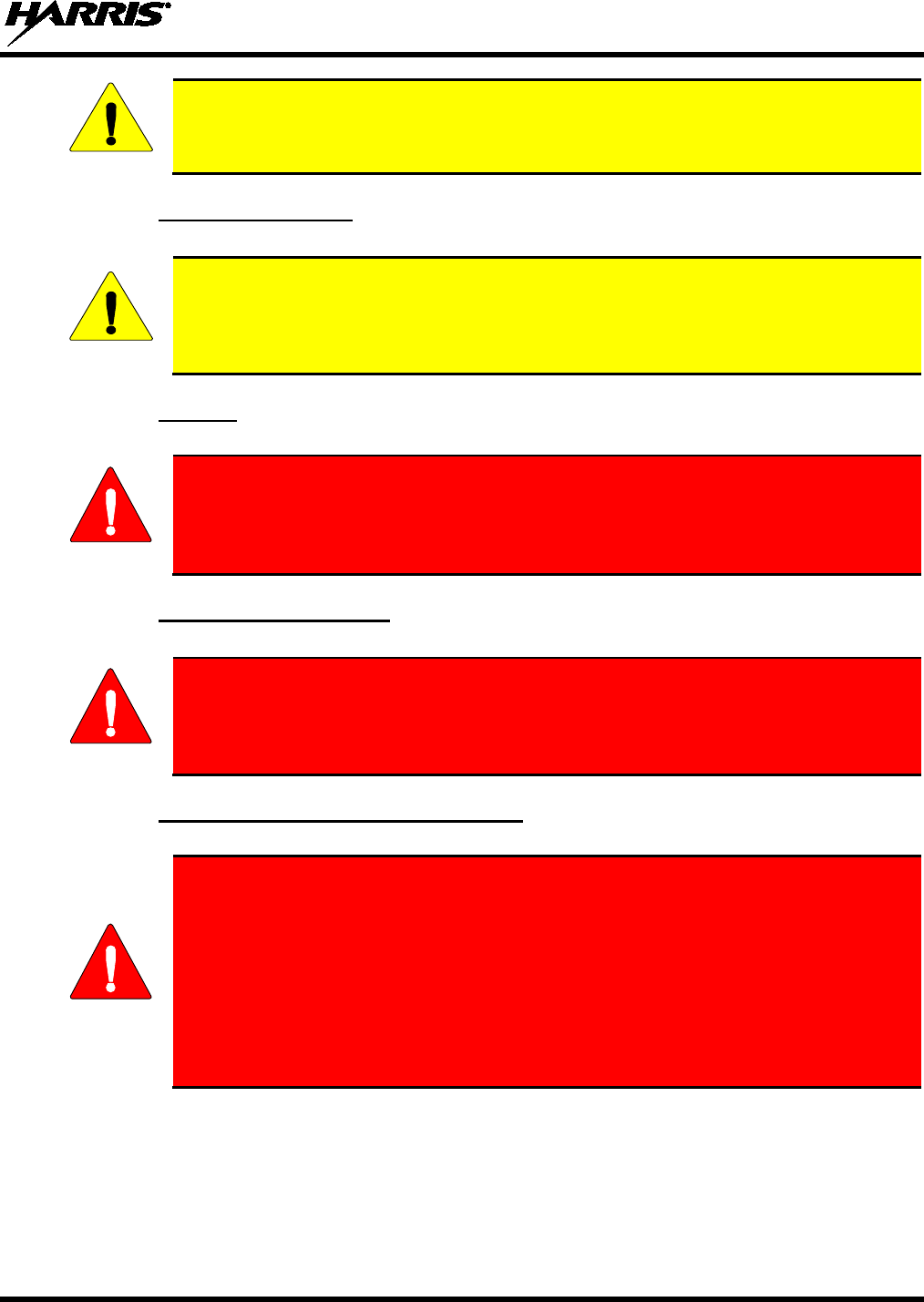
14221-1800-2000, Rev. G
15
Use only the supplied or approved antenna. Unauthorized antennas, modifications, or
attachments could cause damage to the radio unit and may violate FCC regulations. (Refer
to Table 4-1.)
1.4.3 Electronic Devices
RF energy from portable radios may affect some electronic equipment. Most modern
electronic equipment in cars, hospitals, homes, etc. is shielded from RF energy. However,
in areas in which you are instructed to turn off two-way radio equipment, always observe
the rules. If in doubt, turn it off!
1.4.4 Aircraft
• Always turn off a portable radio before boarding any aircraft!
• Use it on the ground only with crew permission.
• DO NOT use while in-flight!!
1.4.5 Electric Blasting Caps
To prevent accidental detonation of electric blasting caps, DO NOT use two-way
radios within 1000 feet of blasting operations. Always obey the "Turn Off Two-Way
Radios" signs posted where electric blasting caps are being used (OSHA Standard:
1926.900).
1.4.6 Potentially Explosive Atmospheres
Areas with potentially explosive atmospheres are often, but not always, clearly
marked. These may be fueling areas, such as gas stations, fuel or chemical transfer
or storage facilities, and areas where the air contains chemicals or particles, such as
grain, dust, or metal powders.
Sparks in such areas could cause an explosion or fire resulting in bodily injury or
even death.
Turn off two-way radios when in any area with a potentially explosive atmosphere. It
is rare, but not impossible that a radio or its accessories could generate sparks.
CAUTION
CAUTION
WARNING
WARNING
WARNING
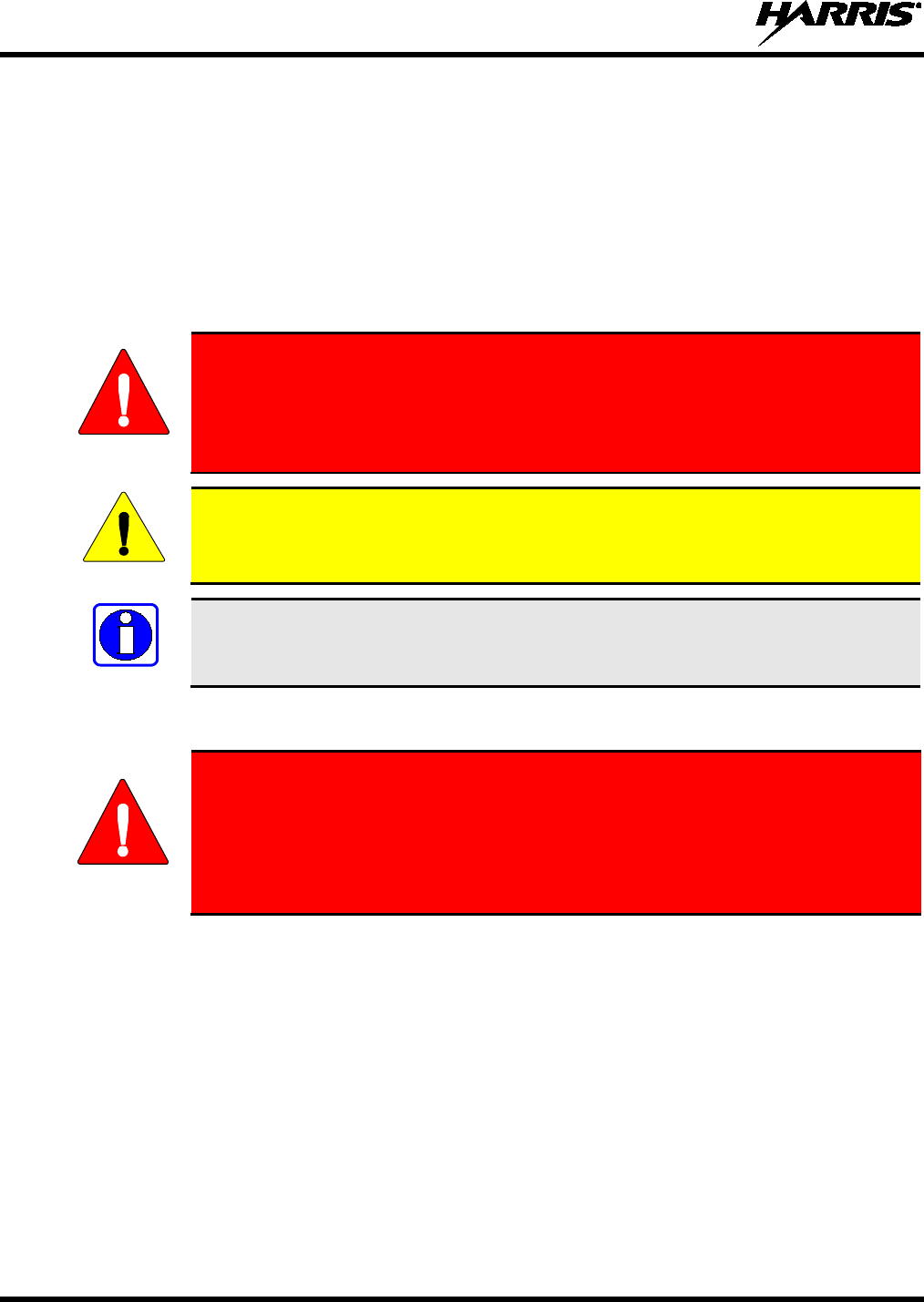
14221-1800-2000, Rev. G
16
2. RENSEIGNEMENTS SUR LA RÉGLEMENTATION ET
SÉCURITÉ
2.1 CONVENTIONS SUR LES SYMBOLES DE SÉCURITÉ
Les conventions suivantes sont utilisées dans le présent manuel pour avertir l’utilisateur des précautions générales de
sécurité qui doivent être observées pendant toutes les phases d’opération, d’entretien et de réparation de ce produit.
Le non-respect de ces précautions ou d’avertissements précisés ailleurs enfreint les normes de sécurité de la
conception, de la fabrication et de l’utilisation prévue du produit. Harris n’assume aucune responsabilité pour le
non-respect de ces normes par le client.
Le symbole MISE EN GARDE attire l’attention sur une procédure ou une
pratique
qui, si elle n’est pas correctement effectuée ou observée, pourrait
entraîner une blessure personnelle. Ne pas poursuivre au-delà d’un symbole de
MISE EN GARDE avant que les conditions identifiées soient complètement
comprises ou satisfaites.
Le symbole AVERTISSEMENT attire l’attention sur une procédure ou une pratique
opérationnelle qui, si elle n’est pas correctement effectuée ou observée, pourrait
entraîner un bris d’équipement ou une importante baisse de rendement de l’équipement.
Le symbole REMARQUE attire l’attention sur des renseignements supplémentaires qui
peuvent améliorer le rendement du système ou clarifier un processus ou une procédure.
2.2 RENSEIGNEMENTS SUR LA FORMATION SUR LA SÉCURITÉ
La radio portative Harris XL-200P/XL-185P produi
t de l’énergie
électromagnétique des RF lorsqu’en mode de transmission. Cette radio est conçue
et classée pour une « Utilisation professionnelle seulement », ce qui signifie qu’elle
ne doit être utilisée que dans le cadre d’un emploi par des individus conscients des
risques et des moyens de limiter ceux-ci. Cette radio N’EST PAS conçue pour une
utilisation par la « Population générale » dans un environnement non contrôlé.
La radio portative XL-200P/XL-185P a été testée et est conforme aux limites d’exposition aux RF de la
FCC pour une « Utilisation professionnelle seulement ». De plus, cette radio Harris est conforme aux
normes et directives suivantes quant à l’énergie des RF et aux niveaux d’énergie électromagnétique, ainsi
qu’à l’évaluation de ces niveaux pour l’exposition aux humains:
• FCC KDB 447498
• American National Standards Institute (C95.1 – 1992), norme de l’IEEE sur les niveaux sécuritaires
d’exposition humaine aux champs électromagnétiques des radiofréquences, 3 kHz à 300 GHz.
• American National Standards Institute (C95.3 – 1992), pratique recommandée par l’IEEE pour la
mesure des champs électromagnétiques potentiellement dangereux – RF et micro-ondes.
MISE EN GARDE
AVERTISSEMENT
REMARQUE
MISE EN GARDE
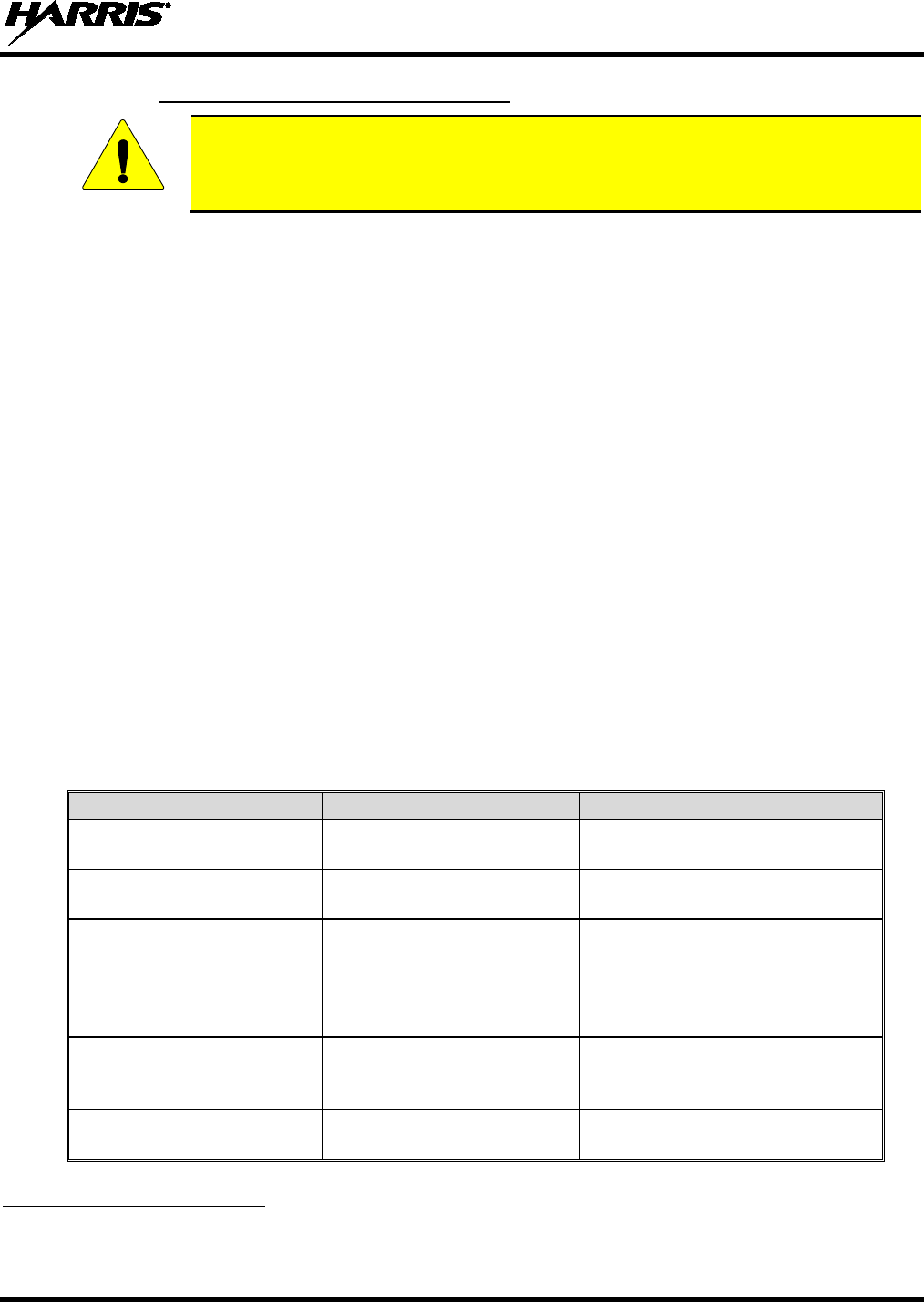
14221-1800-2000, Rev. G
17
2.2.1 Directives sur l’exposition aux RF
Pour s’assurer que l’exposition à l’énergie électromagnétique des RF se situe dans les
limites acceptables de la FCC pour l’utilisation professionnelle, respectez toujours les
directives suivantes :
• N’utilisez PAS la radio sans qu’une antenne appropriée y soit connectée, car ceci peut endommager la
radio et également causer un dépassement des limites d’exposition aux RF de la FCC. Une antenne
appropriée est celle fournie par Harris avec cette radio, ou une antenne spécifiquement autorisée par
Harris pour être utilisée avec cette radio. (Reportez-vous à Tableau 2-1.)
• Ne transmettez PAS pendant plus de 50 % de la durée d’utilisation totale de la radio (« cycle de
service de 50 % »). La transmission pendant plus de 50 % du temps peut causer un dépassement des
exigences de conformité de la FCC en matière d’exposition aux RF. La radio transmet lorsque
l’indicateur « TX » apparaît sur l’affichage. La radio transmet lorsqu’on appuie sur le bouton « PTT »
(bouton de microphone).
• Transmettez TOUJOURS en basse puissance lorsque possible. En plus de préserver la charge de la
pile, une faible puissance réduit l’exposition aux RF.
• Utilisez TOUJOURS des accessoires autorisés Harris (antennes, piles, pinces de ceinture, haut-
parleurs/micros, etc.). L’utilisation d’accessoires non autorisés peut entraîner un dépassement des
exigences de conformité pour une exposition aux RF professionnelle ou contrôlée de la FCC.
(Reportez-vous à Table 4-1.)
• Tel qu’indiqué dans Tableau 2-1, conservez TOUJOURS l’appareil et son antenne à AU MOINS
1,2 cm du corps, et à au moins 2,5 cm du visage pendant la transmission, pour vous assurer de ne pas
dépasser les exigences de conformité de la FCC en matière d’exposition aux RF. Cependant, pour
offrir la meilleure qualité sonore aux auditeurs de votre transmission, Harris recommande de tenir le
microphone à au moins 5 cm (2 po) de votre bouche et légèrement déplacé sur un côté.
Tableau 2-1 : Distances de test de conformité des expositions aux RF (pire des scénarios)
RADIOFRÉQUENCES Corps3 Visage
VHF
(136 - 174 MHz) 1,2 cm 2,5 cm
UHF
(378 - 522 MHz) 1,2 cm 2,5 cm
700/800 MHz
(768 - 776 MHz)
(798 - 806 MHz)
(806 - 824 MHz)
(851 - 870 MHz)
1,2 cm 2,5 cm
900 MHz
(935-944 MHz)
(896-902 MHz)
1,2 cm 2,5 cm
2400 MHz
(2412 - 2472 MHz) 1,2 cm 2,5 cm
3 Ce est le pire des cas basée sur le corps plus mince monter accessoire (clip ceinture).
AVERTISSEMENT

14221-1800-2000, Rev. G
18
RADIOFRÉQUENCES
Corps
3
Visage
5 GHz
(5.18 - 5.825 GHz) 1,2 cm 2,5 cm
Dans cette section figurent les renseignements nécessaires pour sensibiliser l’utilisateur à l’exposition aux
RF et sur ce qu’il faut faire pour s’assurer que cette radio fonctionne dans les limites d’exposition aux RF
de la FCC.
2.2.2 Interférence/Compatibilité Électromagnétique
Pendant les transmissions, cette radio Harris produit de l’énergie des RF qui peut causer de l’interférence
avec d’autres appareils ou systèmes. Pour éviter de telles interférences, fermez la radio dans les zones où
il est indiqué de le faire. N’utilisez PAS le transmetteur dans des zones sensibles aux radiations
électromagnétiques, comme les hôpitaux, les avions et les sites de détonation.
2.3 INTERFÉRENCE DES RADIOFRÉQUENCES
2.3.1 Partie 15 de la FCC
Cet appareil est conforme à la Partie 15 de la réglementation de la FCC. Le fonctionnement est soumis
aux deux conditions suivantes :
1. Cet appareil ne doit pas causer une interférence nuisible; et
2. Cet appareil doit accepter toute interférence reçue, y compris une interférence qui peut causer un
fonctionnement non souhaité.
2.3.2 Industrie Canada
Le présent appareil est conforme aux CNR d'Industrie Canada applicables aux appareils radio exempts de
licence. L'exploitation est autorisée aux deux conditions suivantes : (1) l'appareil ne doit pas produire de
brouillage, et (2) l'utilisateur de l'appareil doit accepter tout brouillage radioélectrique subi, même si le
brouillage est susceptible d'en compromettre le fonctionnement.
2.4 CONSEILS D’UTILISATION
L’emplacement et l’état de l’antenne sont importants pour l’utilisation d’une radio portative. L’utilisation
de la radio dans des zones de faible élévation, sous des lignes électriques ou des ponts, à l’intérieur d’un
véhicule ou dans un immeuble à ossature métallique, peut réduire la portée de l’appareil de manière
considérable. Les montagnes peuvent également réduire la portée de l’unité.
Dans les zones où la transmission ou la réception est insatisfaisante, certaines améliorations peuvent être
obtenues en s’assurant que l’antenne est verticale. Se déplacer de quelques mètres dans une autre
direction ou à un emplacement plus élevé peut également améliorer les communications. L’utilisation
d’une antenne fixée à l’extérieur peut faciliter le fonctionnement dans un véhicule.
L’état de la pile est un autre facteur important d’une utilisation sans tracas d’une radio portative. Chargez
toujours correctement la pile.
2.4.1 Utilisation Efficace de la Radio
Gardez l’antenne dans une position verticale pendant la réception ou la transmission d’un message.
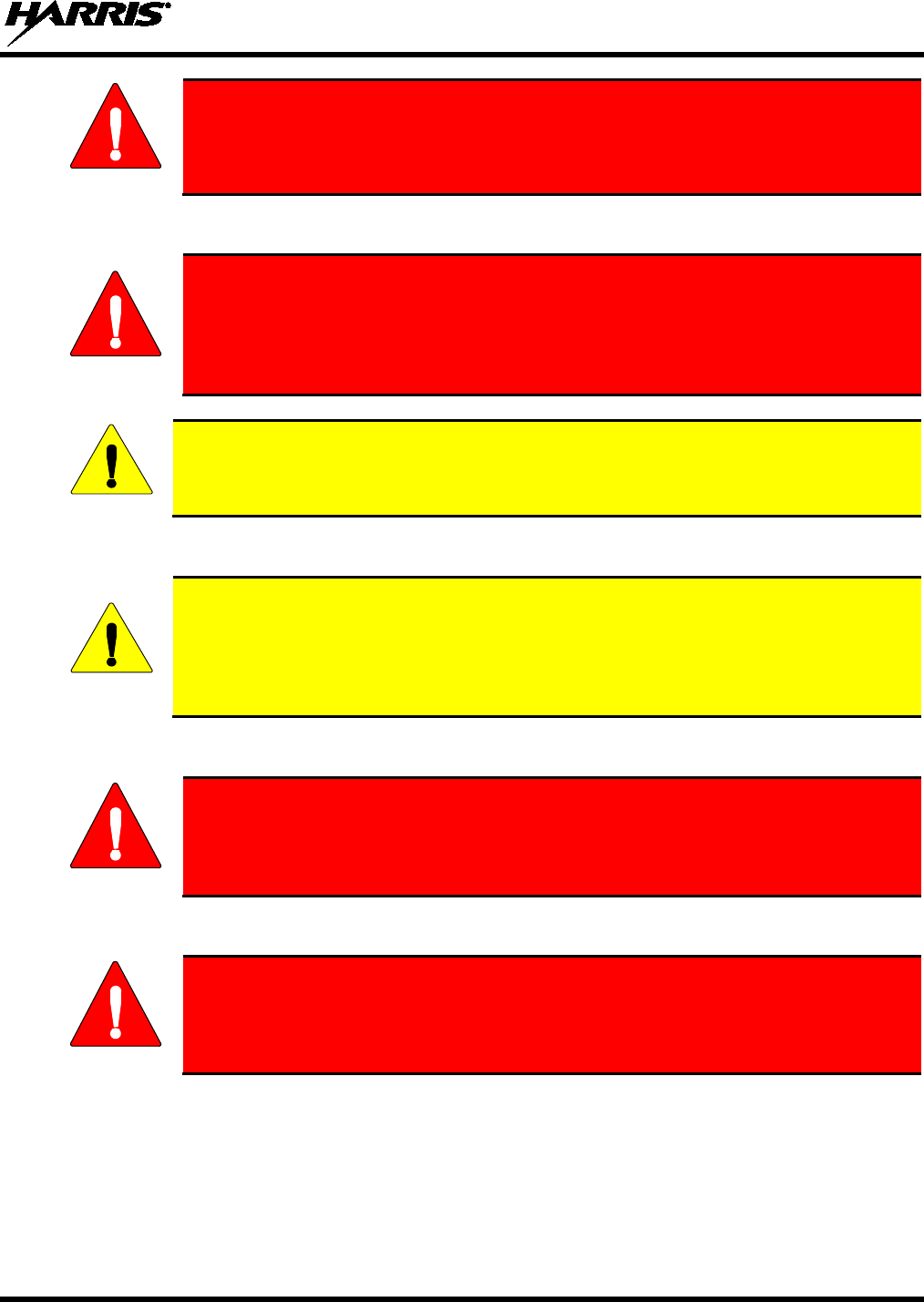
14221-1800-2000, Rev. G
19
Ne tenez PAS l’antenne lorsque la radio est allumée!
2.4.1.1 Entretien Et Remplacement De L’antenne
N’utilisez pas la radio portative si son antenne est endommagée ou absente. Une
brûlure
légère peut se produire au contact d’une antenne endommagée avec la
peau. Remplacez immédiatement une antenne endommagée. L’utilisation d’une
radio portative alors que l’antenne est absente peut causer des blessures,
endommager la radio et pourrait enfreindre la réglementation de la FCC.
Utilisez seulement l’antenne fournie ou une antenne approuvée. Des antennes non autorisées, des
modifications ou des ajouts à une antenne peuvent endommager la radio et enfreindre la
réglementation de la FCC. (Reportez-vous à Table 4-1.)
2.4.1.2 Appareils Électroniques
L’énergie des RF provenant de radios portatives peut affecter certains appareils
électroniques. La majorité de l’équipement électronique moderne dans les voitures, les
hôpitaux, les maisons, etc. est blindé contre l’énergie des RF. Cependant, dans les zones
où l’on vous demande de fermer l’équipement de radio bidirectionnelle, respectez toujours
les règles. En cas de doute, éteignez-le!
2.4.1.3 Avion
• Éteignez toujours une radio portative avant d’embarquer à bord d’un avion!
• Ne l’utilisez au sol qu’avec la permission de l’équipage.
• NE l’utilisez PAS durant le vol!
2.4.1.4 Détonateurs Électriques
Pour prévenir la détonation accidentelle des détonateurs électriques, n’utilisez PAS
de radios bidirectionnelles à moins de 305 m (1 000 pi) des opérations de détonation.
Respectez toujours les indications « Éteindre les radios bidirectionnelles » situées là
où des détonateurs électriques sont utilisés. (Norme OSHA : 1926.900)
MISE EN GARDE
MISE EN GARDE
AVERTISSEMENT
AVERTISSEMENT
MISE EN GARDE
MISE EN GARDE
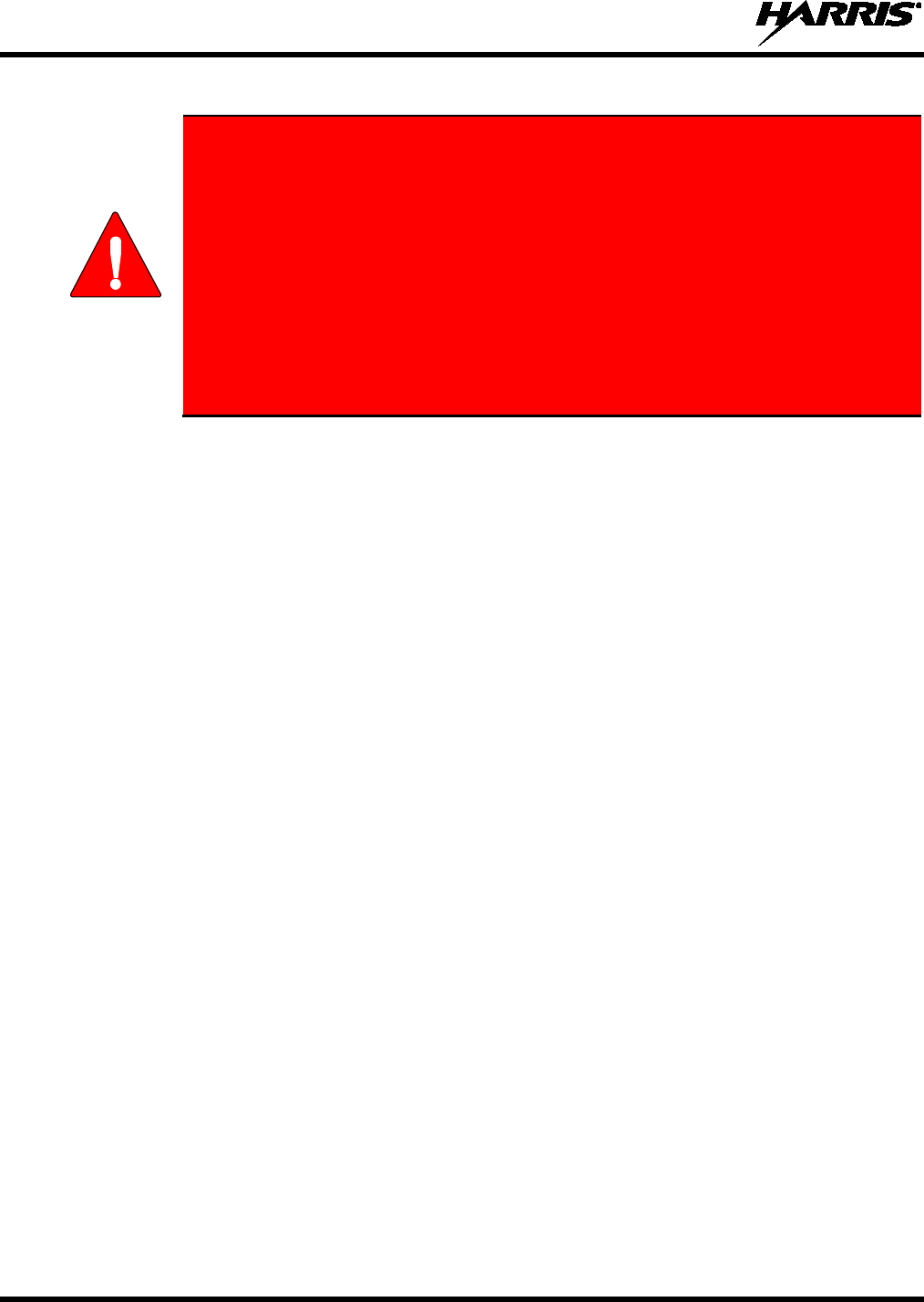
14221-1800-2000, Rev. G
20
2.4.1.5 Atmosphère Potentiellement Explosive
Les zones ayant une atmosphère potentiellement explosive sont souvent, mais pas
toujours, identifiées clairement comme telles. Il peut s’agir de zones d’alimentation
en carburant, comme les postes d’essence, les installations de stockage ou de
tr
ansfert de carburant ou de produits chimiques, ainsi que les zones dont l’air
contient des produits chimiques ou des particules, comme des grains, de la poussière
ou des poudres métalliques.
Des étincelles dans de telles zones peuvent provoquer une explosion ou un incendie,
causant ainsi des blessures ou même la mort.
Éteignez les radios bidirectionnelles dans toute zone ayant une atmosphère
potentiellement explosive. Il est rare, mais pas impossible qu’une radio ou ses
accessoires produisent des étincelles.
MISE EN GARDE
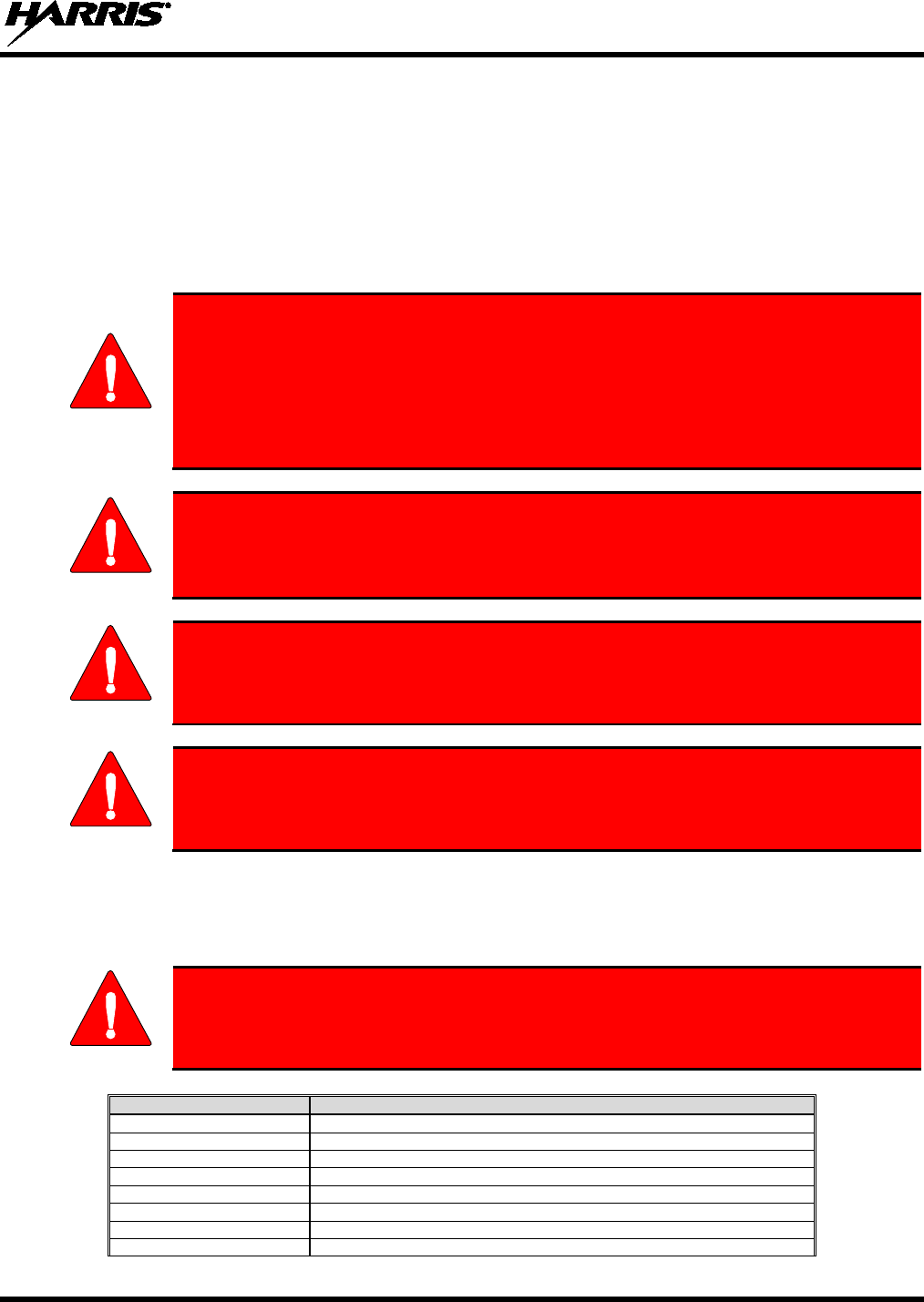
14221-1800-2000, Rev. G
21
3. HAZARDOUS LOCATIONS
3.1 CLASS 1, DIVISION 2 OPTION
Radios ordered with the Class 1, Division 2 option are suitable for use in Class 1, Division 2, Groups A,
B, C, and D or non-hazardous (unclassified) locations only.
Les radios commandées avec l’option Classe 1, Division 2 sont adéquates pour utilisation en Classe 1,
Division 2, Groupes A, B, C et D, ou en lieux non-hasardeux (non-classifiés) seulement
EXPLOSION HAZARD – REPLACE BATTERY PACK ONLY IN AN AREA
KNOWN TO BE NON-HAZARDOUS, AND ONLY WITH HARRIS
PART NO.
14035-4010-01.
AVERTISSEMENT – RISQUE D’EXPLOSION –
LES BATTERIES DOIVENT
ÊTRE REMPLACÉES DANS UNE ZONE RECONNUE NON-HASARDEUSE
SEULEMENT, ET SEULEMENT AVEC UNE BATTERIE HARRIS PORTANT
LE NUMÉRO DE PIÈCE 14035-4010-01.
EXPLOSION HAZARD – Substitution of any component may impair suitability for
Class I, Division 2.
AVERTISSEMENT – RISQUE D’EXPLOSION –
Une substitution de toute
composante pourrait compromettre la convenance pour la Classe I, Division 2.
EXPLOSION HAZARD – Do not exceed maxi
mum battery charging current of
5.250 A or maximum charging voltage of 12.0 V DC at any time.
CAUTION - The battery used in this device may present a risk of fire or explosion
when heated above 100°C (212°F) or incinerated. Replace battery with Harris Part
No. 14035-4010-
01 only. Use of another battery may present a risk of fire or
explosion.
Battery replacement instructions: Remove battery by 1) depressing battery latches then 2) remove battery
from radio chassis. Install replacement battery by inserting battery in radio chassis opening and
depressing battery into chassis until both battery latches are engaged. Dispose of used battery promptly.
Keep away from children. Do not disassemble and do not dispose of in fire.
EXPLOSION HAZARD – In addition to any simple single-
ended coil antenna and
carrying case option, only the following Harris accessories may be used with this
radio:
PART NUMBER
DESCRIPTION
12082-0600-01
Speaker Microphone
12082-0600-02
Speaker Microphone, Emergency Button
12082-0650-01
Microphone, Palm,2 Wire, Black
12082-0650-02
Microphone, Palm, 2 Wire, Beige
12082-0650-03
Microphone, Mini-Lapel,3 Wire, Black
12082-0650-04
Microphone, Mini-Lapel,3 Wire, Beige
12082-0650-05
Earphone Kit, Black
12082-0650-06
Earphone Kit, Beige
WARNING
WARNING
WARNING
WARNING
WARNING
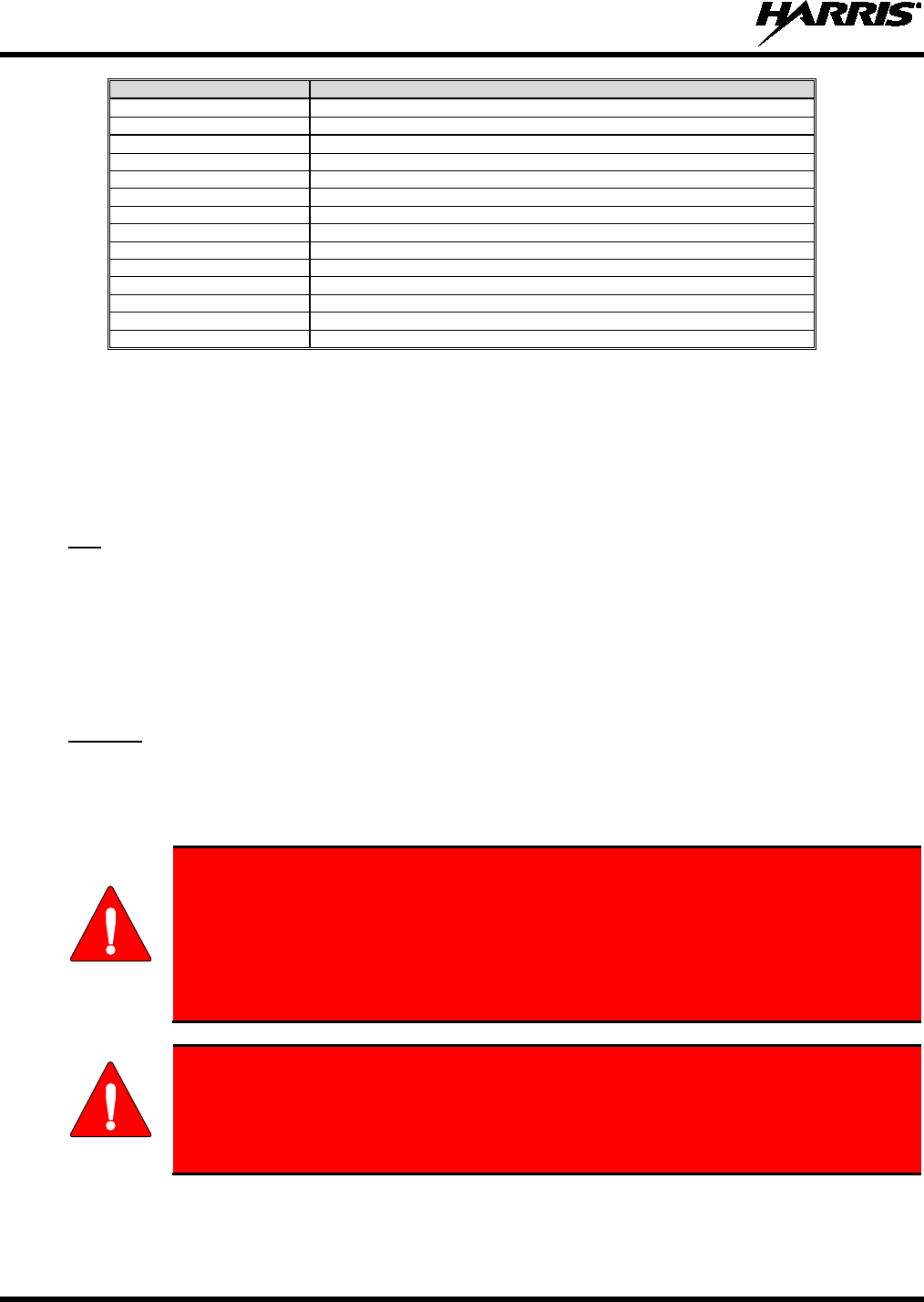
14221-1800-2000, Rev. G
22
PART NUMBER
DESCRIPTION
12082-0650-07
Headset, In-Ear, Boom Mic, In-Line PTT
12082-0650-08
Headset, Lightweight, Over-the-Head, Single Ear, In-Line PTT
12082-0650-09
Headset, Lightweight, Behind-the-Head, Dual Ear, In-Line PTT
12082-0650-10
Headset, Lightweight, Behind-the-Head, Dual Ear, Pigtail PTT
12082-0650-13
Headset, Heavy Duty, Behind-the-Head, w/PTT
12082-0650-14
Headset, Heavy Duty, Over-the-Head, w/PTT
12082-0650-15
Headset, Behind-the-Head, Boom Mic, Earpiece, w/PTT
12082-0650-16
Headset, Tactical, Boom Mic, Earpiece, w/PTT
12082-0650-17
Skull Mic, w/Body PTT and Earcup
12082-0650-18
Throat Mic, W/Acoustic Tube & Body PTT
12082-0650-19
Throat Mic, w/Acoustic Tube, Body and Ring PTT
LS103239V1
Earphone, Lapel Microphone, 2.5mm
LS103239V2
Earphone, Lapel Microphone, 2.5mm, RT Angle
12150-1000-01
Speaker Mic, Premium, Fire (FSM), Noise Cancelling
3.2 CLASS 1, DIVISION 1 OPTION
APPLIES TO XL-200P C1D1 NON-REBANDED, XL-200P C1D1 REBANDED, XL-185 C1D1
NON-REBANDED, XL-185P C1D1 REBANDED, XL-185 C1D1 UHF, and XL-185 C1D1 VHF
Radios ordered with the Class 1, Division 1 option are considered “intrinsically safe apparatus” and are
suitable for use in the following locations:
US:
Class I, Division 1, Groups C and D; Class II, Division 1, Groups E, F and G; Class III, Division 1
hazardous locations; Class 1, Division 2, Groups A, B, C and D or non-hazardous (unclassified) locations
only.
Classe I, Division 1, Groupes C et D; Classe II, Division 1, Groupes E, F et G; Classe III, Division 1
emplacements dangereux; Classe 1, Division 2, Groupes A, B , C et D, ou en sites non-hasardeux (non-
classifiés) seulement.
Canada:
Class 1, Division 2, Groups A, B, C, and D or non-hazardous (unclassified) locations only.
Classe 1, Division 2 sont adéquates pour utilisation en Classe 1, Division 2, Groupes A, B, C et D, ou en
lieux non-hasardeux (non-classifiés) seulement
EXPLOSION HAZARD – REPLACE BATTERY PACK ONLY IN AN AREA
KNOWN TO BE NON-
HAZARDOUS, AND ONLY WITH HARRIS PART NO.
14035-4045-01.
AVERTISSEMENT – RISQUE D’EXPLOSION –
LES BATTERIES DOIVENT
ÊTRE REMPLACÉES DANS UNE ZONE RECONNUE NON-HASARDEUSE
SEULEMENT, ET SEULEMENT AVEC UNE BATTERIE HARRIS PORTANT
LE NUMÉRO DE PIÈCE 14035-4045-01.
EXPLOSION HAZARD – Substitution of any component may impair suitability for
Class I, Division 1; Class II, Division 1; Class III, Division 1; or Class 1, Division 2.
AVERTISSEMENT – RISQUE D’EXPLOSION –
Une substitution de toute
composante pourrait compromettre la convenance pour la Classe I, Division 1;
Classe II , Division 1; Classe III , Division 1; ou Classe 1 , Division 2.
WARNING
WARNING
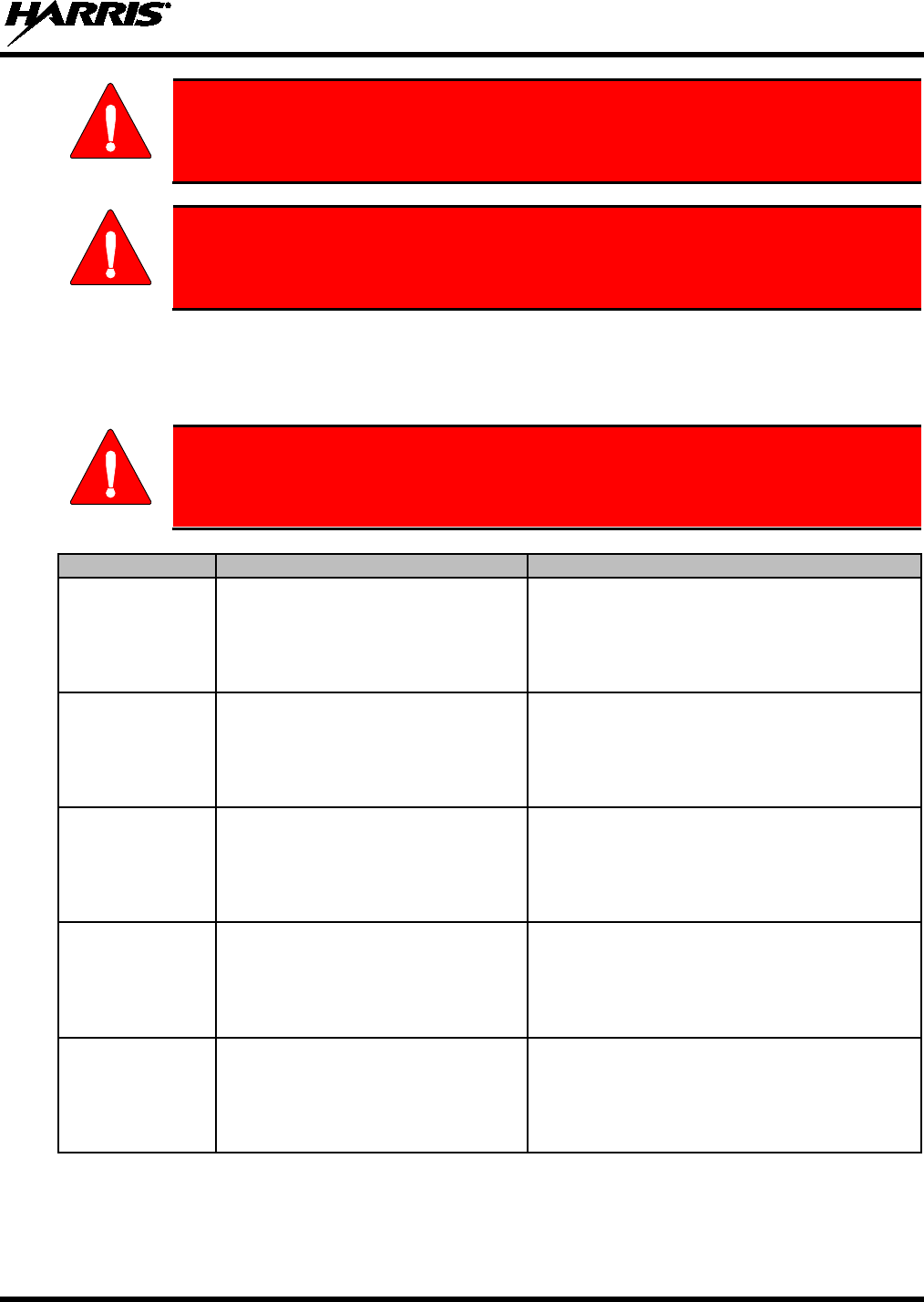
14221-1800-2000, Rev. G
23
EXPLOSION HAZARD – Do not exceed maximum battery charging current of 1.7
A or maximum charging voltage of 8.4 V DC at any time.
CAUTION - The battery used in this device may present a risk of fire or explosion
when heated above 100°C (212°F) or incinerated. Replace battery with Harris Part
No. 14035-4045-01
only. Use of another battery may present a risk of fire or
explosion.
Battery replacement instructions: Remove battery by 1) depressing battery latches then 2) remove battery
from radio chassis. Install replacement battery by inserting battery in radio chassis opening and
depressing battery into chassis until both battery latches are engaged. Dispose of used battery promptly.
Keep away from children. Do not disassemble and do not dispose of in fire.
EXPLOSION HAZARD – In addition to any simple single-ended coil antenna
and
carrying case option
, only the following Harris accessories may be used with this
radio:
PART NUMBER
DESCRIPTION
Approved Hazardous Locations
12082-0600-01 Standard Speaker Mic – Non-Antenna
US: Class I, Division 1, Groups C and D; Class II,
Division 1, Groups E, F and G; Class III, Division 1
hazardous locations; Class 1, Division 2, Groups A,
B, C and D
Canada: Class 1, Division 2, Groups A, B, C and D
12082-0600-02 Speaker Microphone, Emergency
Button
US: Class I, Division 1, Groups C and D; Class II,
Division 1, Groups E, F and G; Class III, Division 1
hazardous locations; Class 1, Division 2, Groups A,
B, C and D
Canada: Class 1, Division 2, Groups A, B, C and D
12082-0600-03 Speaker Microphone, Emergency
Button, Antenna, 18”
US: Class I, Division 1, Groups C and D; Class II,
Division 1, Groups E, F and G; Class III, Division 1
hazardous locations; Class 1, Division 2, Groups A,
B, C and D
Canada: Class 1, Division 2, Groups A, B, C and D
12082-0650-13 Headset, Heavy Duty, Behind-the-
Head, w/PTT
US: Class I, Division 1, Groups C and D; Class II,
Division 1, Groups E, F and G; Class III, Division 1
hazardous locations; Class 1, Division 2, Groups A,
B, C and D
Canada: Class 1, Division 2, Groups A, B, C and D
12082-0650-14 Headset, Heavy Duty, Over-the-Head,
w/PTT
US: Class I, Division 1, Groups C and D; Class II,
Division 1, Groups E, F and G; Class III, Division 1
hazardous locations; Class 1, Division 2, Groups A,
B, C and D
Canada: Class 1, Division 2, Groups A, B, C and D
WARNING
WARNING
WARNING

14221-1800-2000, Rev. G
24
PART NUMBER
DESCRIPTION
Approved Hazardous Locations
LS103239V1 Earphone for speaker/mic
US: Class I, Division 1, Groups C and D; Class II,
Division 1, Groups E, F and G; Class III, Division 1
hazardous locations; Class 1, Division 2, Groups A,
B, C and D
Canada: Class 1, Division 2, Groups A, B, C and D
LS103239V2 Earphone for speaker/mic, Right Angle
US: Class I, Division 1, Groups C and D; Class II,
Division 1, Groups E, F and G; Class III, Division 1
hazardous locations; Class 1, Division 2, Groups A,
B, C and D
Canada: Class 1, Division 2, Groups A, B, C and D
12082-0600-04 Speaker Microphone, Emergency
Button, Antenna, 25.6”
US: Class I, Division 1, Groups C and D; Class II,
Division 1, Groups E, F and G; Class III, Division 1
hazardous locations; Class 1, Division 2, Groups A,
B, C and D
Canada: Class 1, Division 2, Groups A, B, C and D
12082-0600-05 Speaker Microphone, Emergency
Button, Antenna, 30”
US: Class I, Division 1, Groups C and D; Class II,
Division 1, Groups E, F and G; Class III, Division 1
hazardous locations; Class 1, Division 2, Groups A,
B, C and D
Canada: Class 1, Division 2, Groups A, B, C and D

14221-1800-2000, Rev. G
25
4. INTRODUCTION
4.1 DESCRIPTION
The XL-Series portable radios provide the advanced connectivity that first responders require while
addressing evolving voice and data communications. They meet MIL-STD-810G for durability and are
certified to more stringent MIL-STD parameters for contamination by fluids and explosive atmospheres.
XL portable radios support P25 Trunking, P25 Conventional, Enhanced Digital Access Communications
System (EDACS), analog conventional, and BeOn® over a Wi-Fi® or LTE network.
EDACS operation is not supported in UHF or VHF.
Refer to Feature Manual 14221-7200-6130 for details on configuring and using BeOn on
the XL Series radios.
Radio features include:
• Extremely Rugged – exceeds the standards of other radios on the market.
• Multiband Operation – supports any combination of VHF, UHF, and 700/800 MHz frequencies.
Also, allows different bands to be enabled for selected users.
• Single-key DES Encryption – provides basic secure communications without having to buy the
complete encryption option.
• Instant Recall of Received Audio – allows user to replay the last transmission received to avoid
unnecessary repetition.
• Active Noise Cancellation – with three internal microphones to transmit intelligible audio from users
in loud environments.
• Built-in GPS – for location reporting and rapid response for emergencies.
• Integrated Bluetooth® – for wireless interface to selected accessories.
• Wi-Fi Connectivity – permits simple and easy radio software and personality updates.
• Wi-Fi Access Point – Radios that include the LTE option can be configured via RPM2 to act as a Wi-
Fi access point and/or router, providing access to broadband data for Wi-Fi devices. Refer to RPM2’s
online help when configuring the radio for these functions.
• Covert Mode – allows users to quickly configure the radio for operation in a covert environment.
• Fully Programmable Keypad – each key can be programmed to a variety of functions.
• 4-position switch – provides added configuration flexibility.
• Unique User Interface – tools specially designed by first responders make radio operation simple and
intuitive. An easy-to-read multi-color front display and a monochromatic top display with optional
colored backlighting enhance communications for improved user safety.
For optional accessories, refer to Table 4-1. Additional accessories may have been added since
publication of this manual; contact Harris for more information.
4.2 STORAGE GUIDELINES
Store your radio and batteries in a clean, cool (not exceeding 86 °F [+30 °C]), dry, and ventilated storage
area.
NOTE
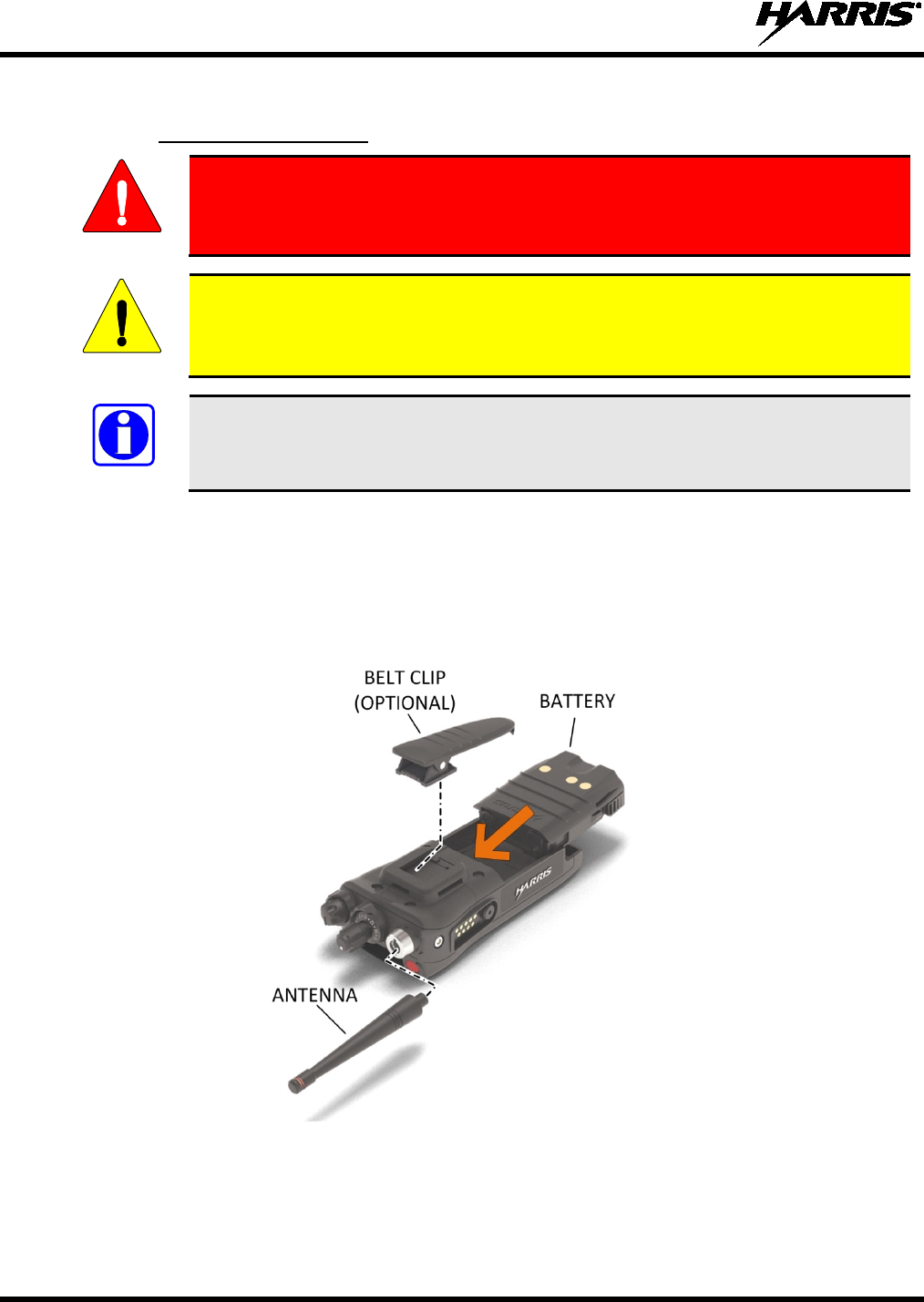
14221-1800-2000, Rev. G
26
4.3 BASIC SETUP
4.3.1 Assemble the Radio
Only use a Harris charger approved for the battery chemistry. Injury could occur
from improper charger use.
Do not over-tighten the antenna as damage could result.
Please charge battery fully before first use. Due to government regulations, batteries
ship in a discharged state and may require up to two (2)
minutes in a charger for
successful initialization. During initialization, the charger will not show any charge
indication. After this initialization period, charging will resume normally.
1. Make sure batteries are charged per the manual supplied with the charger.
2. To attach optional belt clip, remove the existing tab from the back of the radio above the battery
compartment. Slide the belt clip into the groove.
3. Lift clip, if installed, and slide top of battery into top of battery compartment at the rear of the radio.
4. Press down on bottom side of battery until it snaps into place.
Figure 4-1: Radio Assembly
WARNING
CAUTION
NOTE
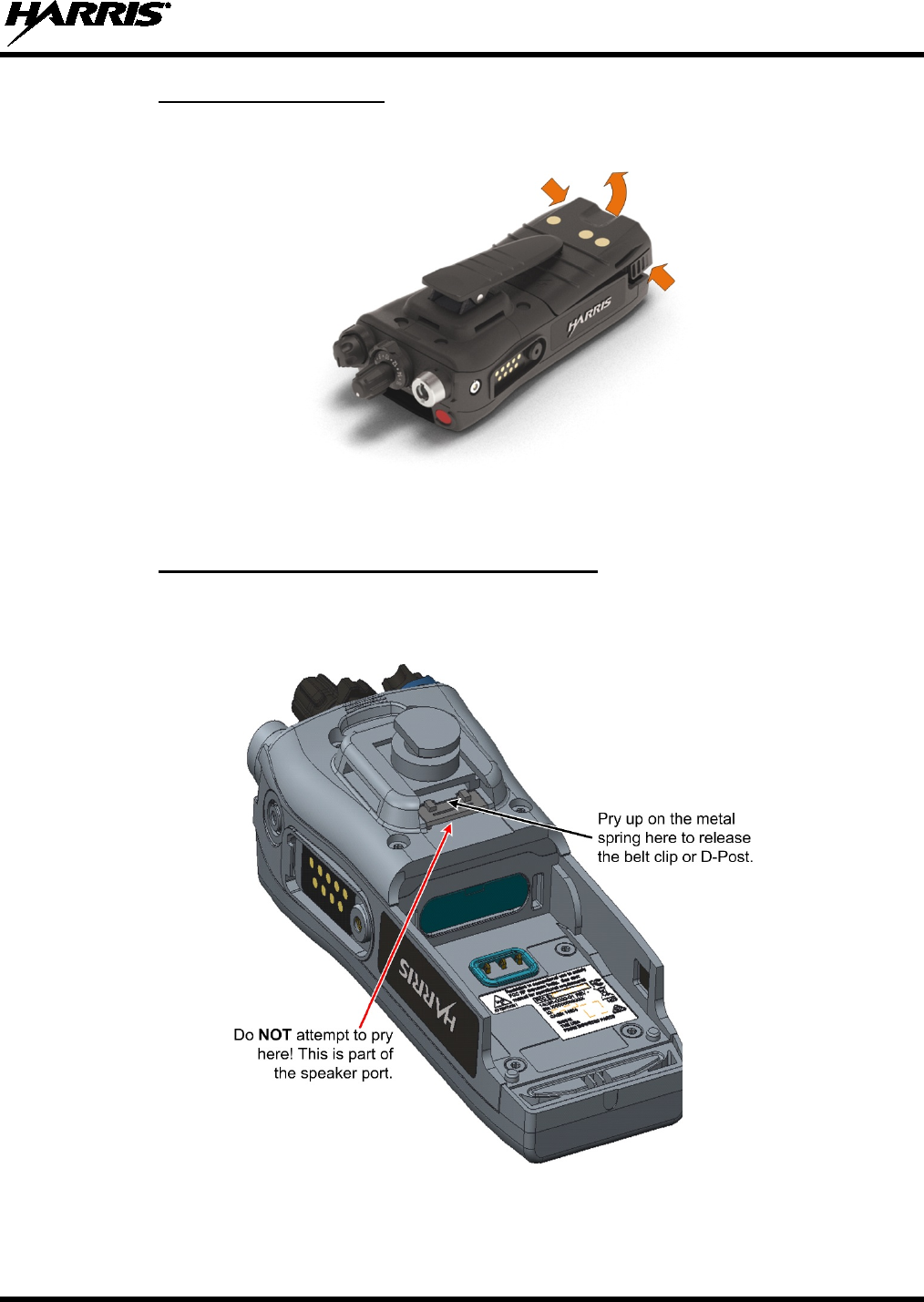
14221-1800-2000, Rev. G
27
4.3.2 Removing the Battery
To remove, press and hold the two tabs at the bottom of the battery and then pull battery up and out of the
radio.
Figure 4-2: Remove the Battery
4.3.3 Removing the Optional Belt Clip or D-Post
Remove the battery before removing the belt clip or D-Post. To remove the belt clip, pry up on the metal
spring towards the top of the battery compartment (see Figure 4-3) using a flat head screwdriver and slide
the belt clip or D-Post out of the groove in the back of the radio.
Figure 4-3: Remove Belt Clip
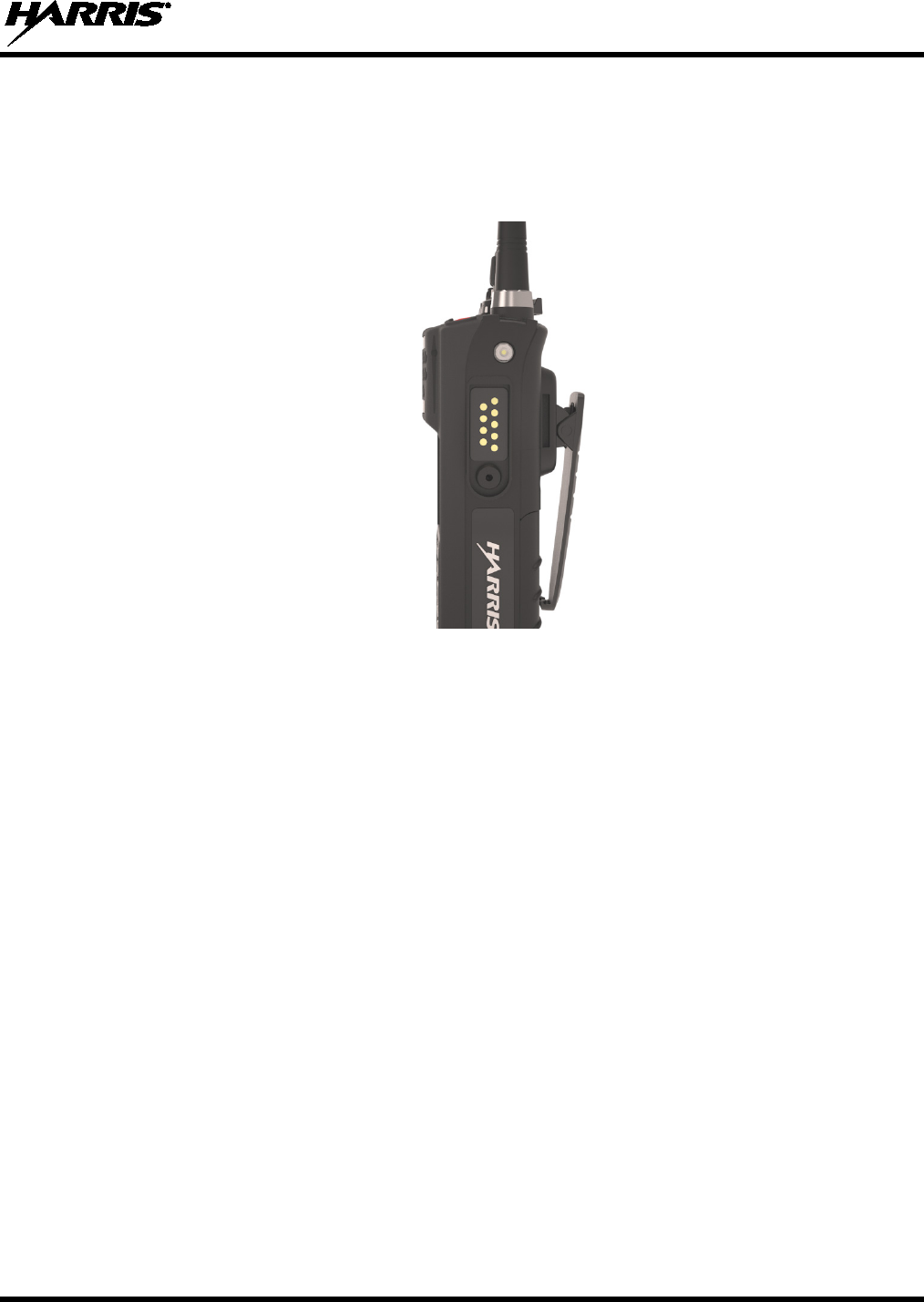
14221-1800-2000, Rev. G
29
4.4 UNIVERSAL DEVICE CONNECTOR
The Universal Device Connector (UDC) provides connections for external accessories such as a headset,
a speaker-microphone, audio test box, audio test cables, and programming cables. The UDC is located on
the right side of the radio, opposite the PTT Button. The UDC facilitates programming and testing the
radio. The UDC pins perform different functions depending on the accessory attached to the UDC.
Figure 4-5: Universal Device Connector
4.5 CLEANING
Keep the exterior of the radio, battery, antenna, and radio accessories clean.
Periodically clean using the following procedures:
1. To remove dust and dirt, clean using damp clean cloth (warm water and mild detergent soap).
2. Follow by wiping with damp (warm water) clean cloth. Wipe dry with clean cloth.
3. Remove the battery and wipe the battery and radio contacts using a soft dry cloth to remove dirt or
grease. This will ensure efficient power transfer from the battery to the radio.
4. Remove any accessories and clean the UDC contacts using a clean dry cloth. When the UDC is not
in use, cover the connector with the protective dust cap to prevent the build-up of dust or water
particles.
5. If the radio is used in a harsh environment (such as driving rain, salt fog, etc.), it may be necessary to
periodically dry and clean the battery and radio contacts with a soft dry cloth or soft-bristle non-
metallic brush.
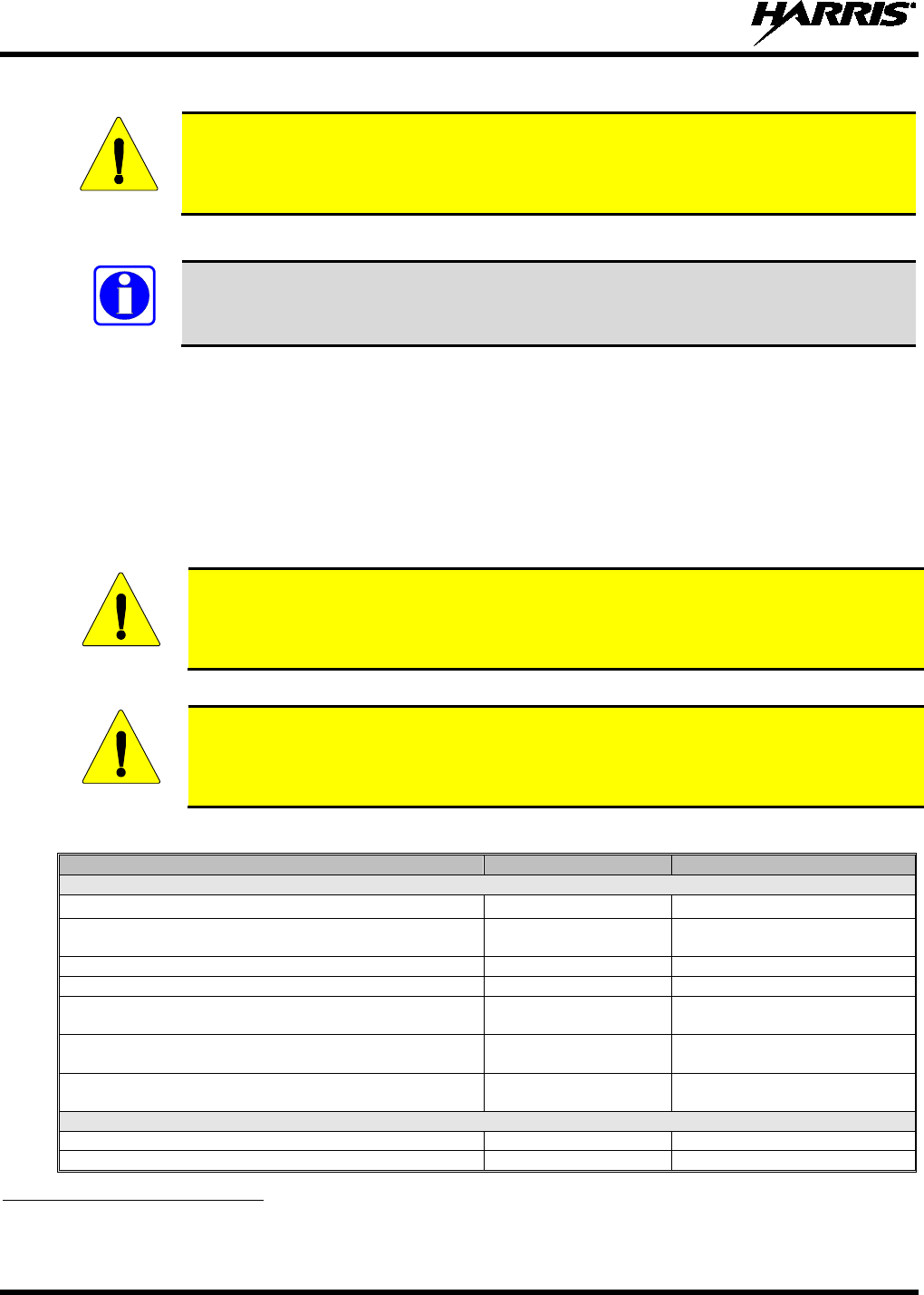
14221-1800-2000, Rev. G
30
For more rigorous cleaning, use the following procedure:
Do not use chemical cleaners, spray, or petroleum-based products. They may damage
the radio housing. We recommend using Chemtronics® Electro-Wash® PR (ES-1603) or
equivalent.
1. Apply the cleaning solution to a clean damp cloth and clean the radio.
Do not spray cleaning solution directly on radio. To clean the radio in the speaker and
microphone areas, carefully wipe these areas but prevent the cleaning solution from
entering the speaker or microphone openings.
2. Wipe off the radio with clean damp cloth using mild warm soapy water.
3. Follow up by wiping off the radio with clean damp cloth using warm water only.
4. Wipe dry with clean cloth.
4.6 OPTIONS AND ACCESSORIES
Only use Harris approved accessories. Refer to Harris’ Product and Services catalog for the complete list
of options and accessories available. Contact Harris for requirements not contained in this list:
Always use the correct options and accessories (battery, antenna, speaker/mic, etc.) for
the radio. Immersion rated options must be used with an immersion rated radio. Refer to
Table 4-1.
ONLY accessories marked with an asterisk (*) are approved for use with C1D1
radios.
Table 4-1: Options and Accessories
DESCRIPTION
PART NUMBER
OPTION NUMBER
ANTENNAS
Antenna, Full Spectrum XL-200P Only*
14035-4000-01*
XL-NC5Z*
Antenna, Whip Wideband 378-520 MHz, 762-870 MHz
XL-200P Only*
14035-4420-01*
XL-NC8E*
Antenna, Whip, 1/4 Wave, 762-870 MHz XL-200P Only*
14035-4440-02*
XL-NC8F*
Antenna, Whip, 1/2 Wave, 762-870 MHz XL-200P Only*
14035-4440-01*
XL-NC8D*
Antenna, Whip, 1/4 Wave, 762-944 MHz XL-185P Only
(Not approved w/LTE Option)
14035-4450-02
XL-NC9F
Antenna, Whip, 1/2 Wave, 762-944 MHz XL-185P Only
(Approved w/LTE Option)
14035-4450-01
XL-NC9D
Antenna, 896-941 MHz XL-185P Only
(Not approved w/LTE Option)
KRE1011223/02
MAEX-NNC1Z
BATTERIES/CHARGERS
Battery, Lithium, Standard Capacity
14035-4010-01
XL-PA3V
Battery, Li-Ion, 3100 mAH
14035-4010-04
XL-PA3V
* Approved for use with C1D1 radios.
CAUTION
NOTE
CAUTION
CAUTION

14221-1800-2000, Rev. G
31
DESCRIPTION
PART NUMBER
OPTION NUMBER
Battery, Li-Ion, 3100 mAH, UL
14035-4010-05
Battery, Li-Ion, 7.2VDC, 3100 mAh C1D1*
14035-4045-01*
XL-PA4F*
Charger, Single Bay*
14035-1800-01*
XL-CH4X*
Charger, Multi Bay*
14035-1800-02*
XL-CH5A*
Charger, Vehicular*
14035-4100-01*
XL-CH4W*
AUDIO ACCESSORIES
Speaker Microphone*
12082-0600-01*
XL-AE9N*
Speaker Microphone, Emergency Button*
12082-0600-02*
XL-AE4B*
Speaker Microphone, Emergency Button, Antenna, 18”*
12082-0600-03*
XL-AE2K*
Speaker Microphone, Emergency Button, Antenna,
25.6”*
12082-0600-04*
XL-AE2J*
Speaker Microphone, Emergency Button, Antenna, 30”*
12082-0600-05*
XL-AE2L*
Speaker Microphone, Wireless, Bluetooth
12082-0681-01
XL-AE6K
Speaker Microphone, Premium, Fire, Noise Cancelling
12150-1000-01
XL-AE1T
Speaker Microphone, Premium, Fire, Noise Cancelling,
High Visibility Yellow
12150-1000-05 XL-AE1X
Microphone, Palm, 2-Wire, Black
12082-0650-01
XL-AE6G
Microphone, Palm, 2-Wire, Beige
12082-0650-02
XL-AE6M
Microphone, Mini-Lapel, 3-Wire, Black
12082-0650-03
XL-AE6H
Microphone, Mini-Lapel, 3-Wire, Beige
12082-0650-04
XL-AE6N
Earphone Kit, Black
12082-0650-05
Earphone Kit, Beige
12082-0650-06
Headset, In-Ear, Boom Mic, In-Line PTT
12082-0650-07
XL-AE2A
Headset, Light Weight, Over-the-Head, Single Ear, In-
Line PTT
12082-0650-08 XL-AE2B
Headset, Light Weight, Behind-the-Head, Dual Ear, In-
Line PTT
12082-0650-09 XL-AE2C
Headset, Light Weight, Behind-the-Head, Dual Ear, Pig
Tail PTT
12082-0650-10 XL-AE2D
Headset, Light Weight, Behind-the-Head, Dual In-Ear,
In-Line PTT
12082-0650-11 XL-AE2E
Headset, Light Weight, Behind-the-Head, Dual In-Ear,
Pig Tail PTT
12082-0650-12 XL-AE2F
Headset, Heavy Duty, Behind-the-Head, w/PTT*
12082-0650-13*
XL-AE1P*
Headset, Heavy Duty, Over-the-Head, w/PTT*
12082-0650-14*
XL-AE1R*
Headset, BTH Boom Mic, Earpiece, w/PTT
12082-0650-15
XL-AE2G
Headset, Tactical, Boom Mic, Earpiece, w/PTT
12082-0650-16
XL-AE1H
Skull Mic, w/Body PTT, Earcup
12082-0650-17
XL-AE1L
Throat Mic, w/Acoustic Tube, Body PTT
12082-0650-18
XL-AE1M
Throat Mic, w/Acoustic Tube, body and Ring PTT
12082-0650-19
XL-AE1N
Bluetooth, Covert, Earpiece/MIC/PTT, Radios
12082-0684-01
XL-AE1S
Earphone, Lapel Microphone*
LS103239V1*
XL-AE3Z*
Earphone, Speaker Mic, Right Angle, 2.5 MM*
LS103239V2*
XL-AE1K*
MISCELLANEOUS ACCESSORIES
Cable, Data Interface
12082-0445-A1
XL-CJ4A
Cable, MATQ-03424, Test
12082-0435-A1
Cable, USB, Key Loading/Programming
12082-0410-A1
XL-CJ3A
Cable, KVL, Key Loading
12082-0400-A1
XL-CJ3B
Adapter, 6-Pin Hirose
14002-0197-01
XL-CJ4B
Holster, Leather, Radio, Premium
14035-4200-01
Holster, Leather W/Rings, Radio, Premium
14035-4200-02
Holster, Nylon, Black, Radio, Premium
14035-4200-03
Holster, Ring, Leather, Radio, Premium
14035-4200-04
Case, Leather, Premium, Belt Loop, D-swivel
14035-4201-01
XL-HC4K
* Approved for use with C1D1 radios.
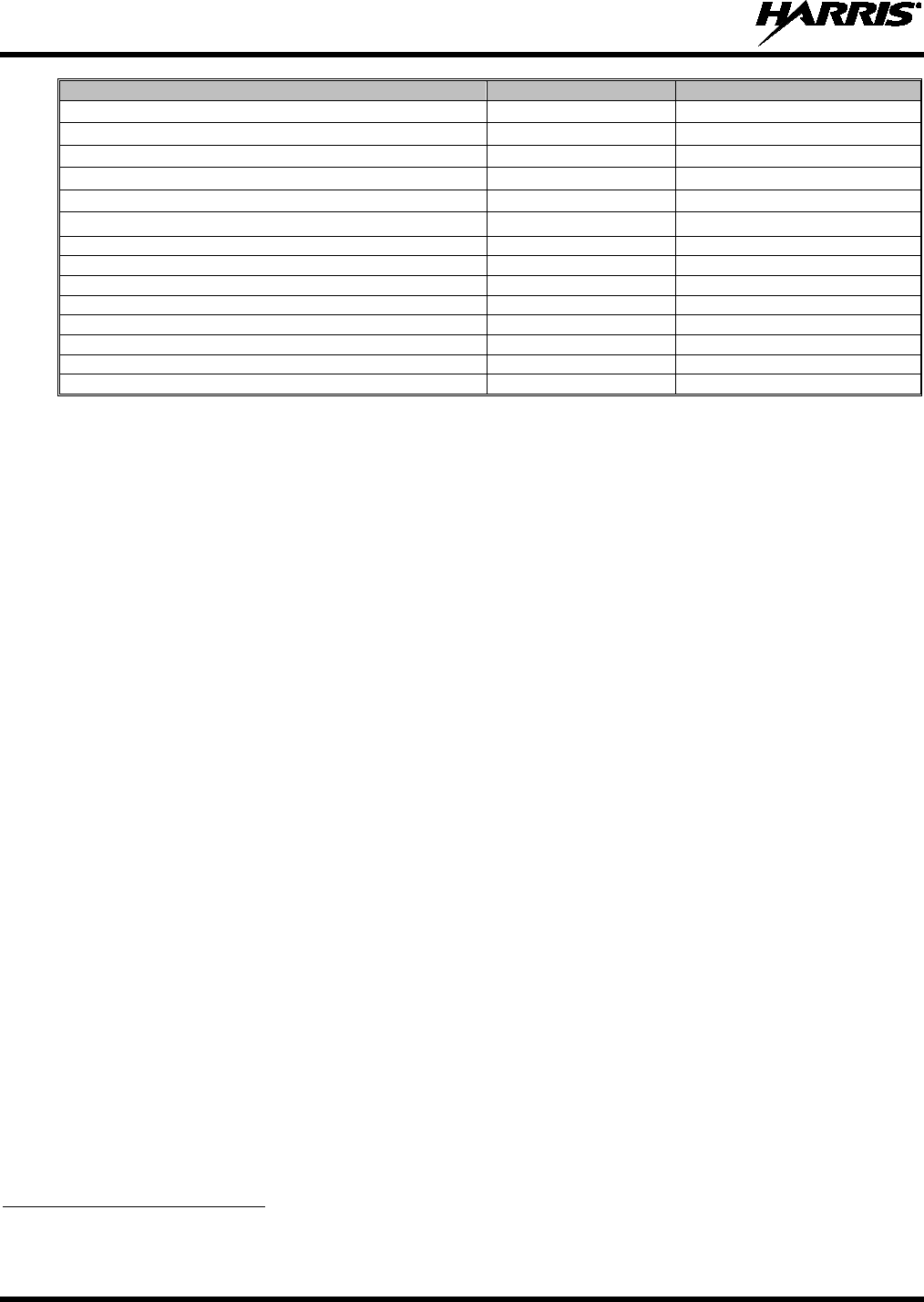
14221-1800-2000, Rev. G
32
DESCRIPTION
PART NUMBER
OPTION NUMBER
Case, Leather, Premium, Shoulder Strap
14035-4201-02
XL-HC4L
Case, Leather, Premium, Shoulder Strap
14035-4202-01
Holster, Leather W/Rings, Radio, Standard
14035-4202-02
Holster, Nylon, Black, Radio, Standard
14035-4202-03
Holster, Ring, Leather, Radio, Standard
14035-4202-04
Belt Loop, Leather, Premium *
14002-0218-01*
XL-HC4A*
D-Swivel*
12082-3230-01*
Strap, Shoulder
CC103333V1
Metal Belt Clip*
12082-1290-01*
XL-HC3L*
Case, Leather, Premium, Shoulder Strap
14035-4201-02
XL-HC4L
Belt Loop, Leather
KRY1011609/1
Holster, Leather, Premium
14036-4000-01
Holster, Leather W/Rings, Premium
14036-4000-02
Side Connector Cover*
12082-1398-01*
XL-ZN7V*
* Approved for use with C1D1 radios.
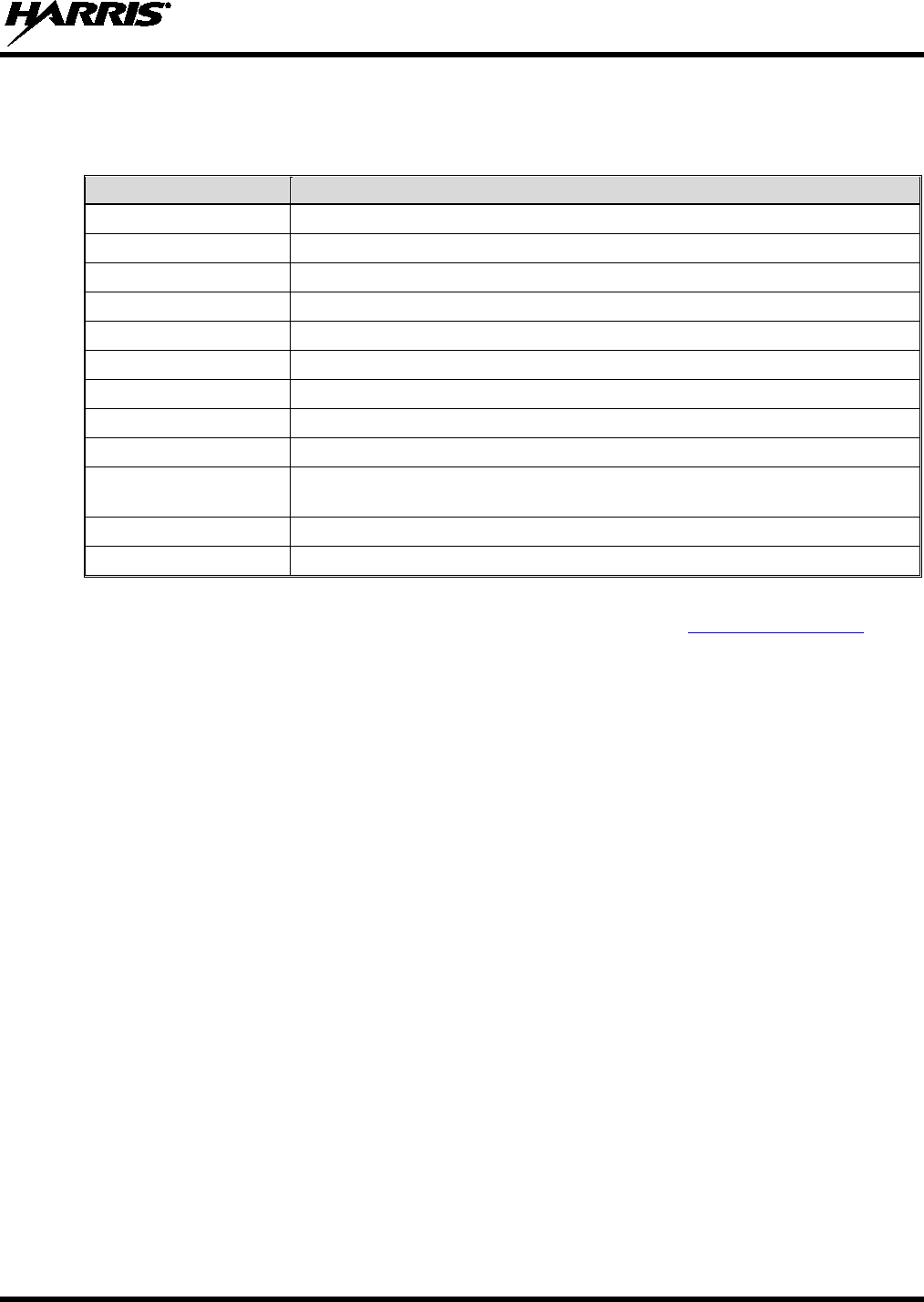
14221-1800-2000, Rev. G
33
4.7 RELATED PUBLICATIONS
The following publications contain additional information about the radio and related products:
MANUAL NUMBER DESCRIPTION
14221-1800-2010 Portable Radio Product Safety Manual
14221-1800-1000 XL-200P/XL-185P Portable Radio Quick Guide
14221-1800-2000 XL-200P/XL-185P Portable Radio Operator’s Manual
14221-1800-8000 XL-200P/XL-185P Portable Radio Software Release Notes
MM1000019423 Key Manager and Key Admin Overview and Operation Manual
MM1000019424 Key Manager and Key Loader Overview and Operation Manual
14221-1600-2090 Single-Bay Desktop Charger Operator Manual
14221-1600-2110 VC4000 Vehicular Charger Operator Manual
14221-7200-6110 Voice Annunciation Feature Manual
14221-2100-3000 Advanced Access Control/Radio Personality Manager Overview
Manual
14221-1100-8170 Radio Personality Manager 2 (RPM2) Software Release Notes
14221-7200-6130 BeOn Configuration and Use Feature Manual
The product safety manual and the quick guide are included with the radio equipment package when the
radio ships from the factory. All publications listed above are available at www.pspc.harris.com via an
Information Center login and Tech Link.
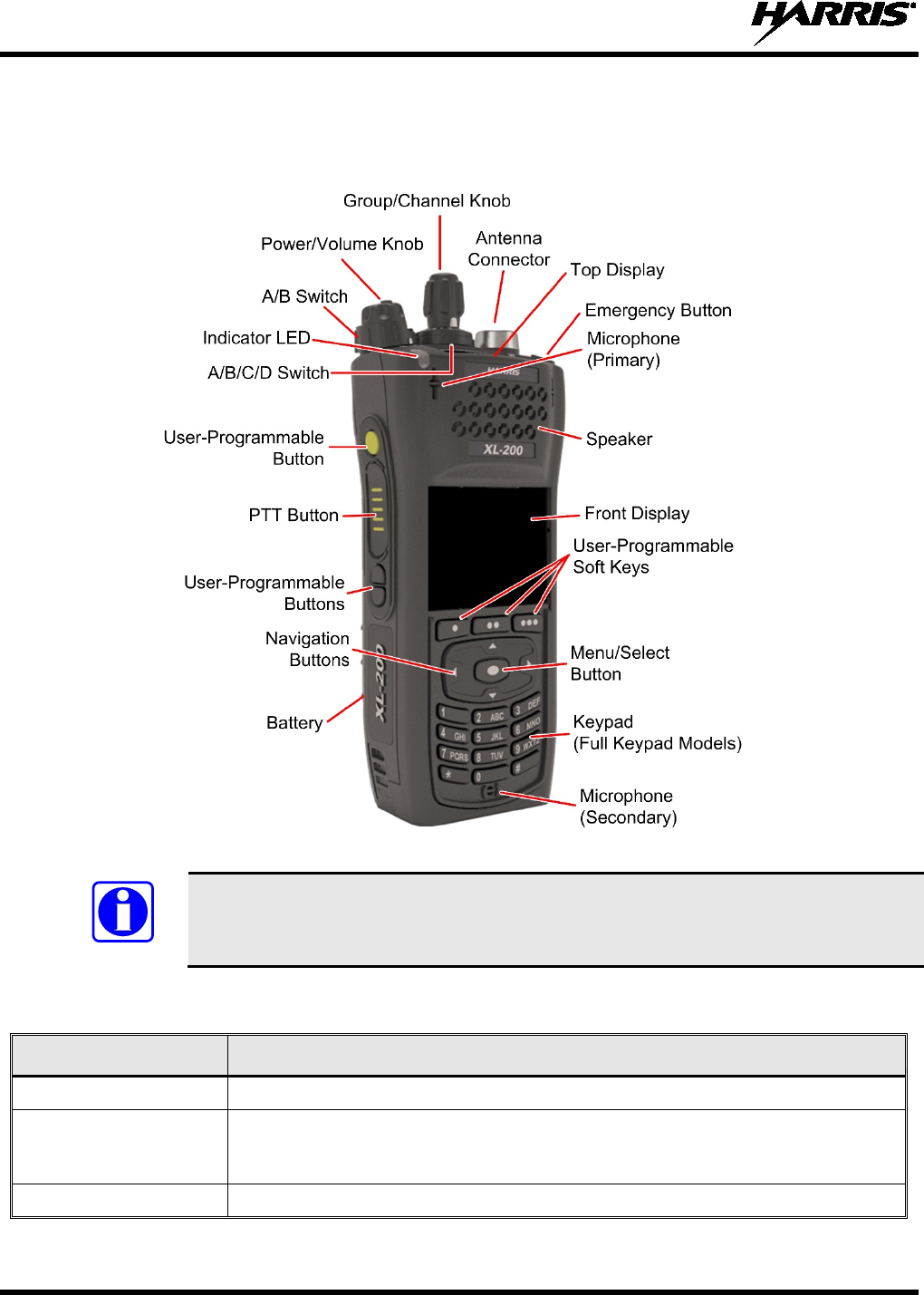
14221-1800-2000, Rev. G
34
5. BASIC OPERATION
5.1 RADIO CONTROLS
Figure 5-1: Radio Controls
Table 5-1 describes the default functions of buttons, knobs, and controls. Most can be
programmed for different functions; see Section 7.4 for more information.
Table 5-1: Radio Controls, Indicators, and Connectors
CONTROL/INDICATOR
FUNCTION
Group/Channel Knob
Selects groups/channels.
Power/Volume Knob
Turn clockwise to power on radio and increase volume of audio heard from
speaker. Minimum volume levels may be programmed into the radio to prevent
missed calls due to a low volume setting.
A/B (Ø/O) Switch
User-programmable switch (see Section 7.4.2).
NOTE

14221-1800-2000, Rev. G
35
CONTROL/INDICATOR
FUNCTION
Microphone
(Secondary)
When noise cancellation is enabled, the secondary and primary microphones are
used together to form a dual microphone system. Noise cancellation improves the
quality of transmitted voice. When noise cancellation is disabled, only the primary
microphone is used. See Section 5.17
for detailed information on using noise
cancellation.
A/B/C/D Switch
User-programmable switch (see Section 7.4.3). By default, selects one of four
channel banks (see Section 5.12).
User-Programmable
Buttons
Used to select a commonly used function as an alternative to navigating menus.
This is configured via programming using Radio Personality Manager 2 (RPM2).
See Section 7.4.1 for the options that can be programmed to these buttons.
Push-To-Talk (PTT)
Button
Press to transmit. Make sure Push-To-Talk (PTT) is enabled (Section 6.5).
Battery
Battery - Refer to Section 4.3 for battery connection and removal.
Antenna Connector
Antenna connector.
Emergency Button
Used to place radio in emergency mode (see Section 5.32). This button can be
disabled via programming using RPM2. In addition, this button can be used in
conjunction with a User-Programmable Button to clear emergencies if configured
to do so.
Indicator Light Emitting
Diode (LED)
Indicates radio status:
• Red = actively transmitting.
• Green = actively receiving.
• Orange = actively transmitting encrypted.
Top Display
Shows summary of radio operation, including channel/talkgroup (which can be
color coded), as well as a variety of programmable icons. Display orientation can
be configured for viewing from the front or rear of the radio. (Section 6.6).
Speaker
Radio speaker which can be muted (Section 6.5). Adjust volume using the
Power/Volume knob.
Microphone (Primary)
When noise cancellation is enabled, the primary and secondary microphones are
used together to form a dual microphone system. Noise cancellation improves the
quality of transmitted voice. When noise cancellation is disabled, only the primary
microphone is used. See Section 5.8
for detailed information on using noise
cancellation.
Front Display
Front display shows complete status and radio menus.
User-Programmable
Soft Keys
User-programmable dynamic keys that have their current function labeled on the
radio display directly above each button. See Section 7.4.1 for the options that
can be programmed to these buttons.
Menu/Select Button
From the Main Display, press this button to access the menu. Also, selects
highlighted menu items.
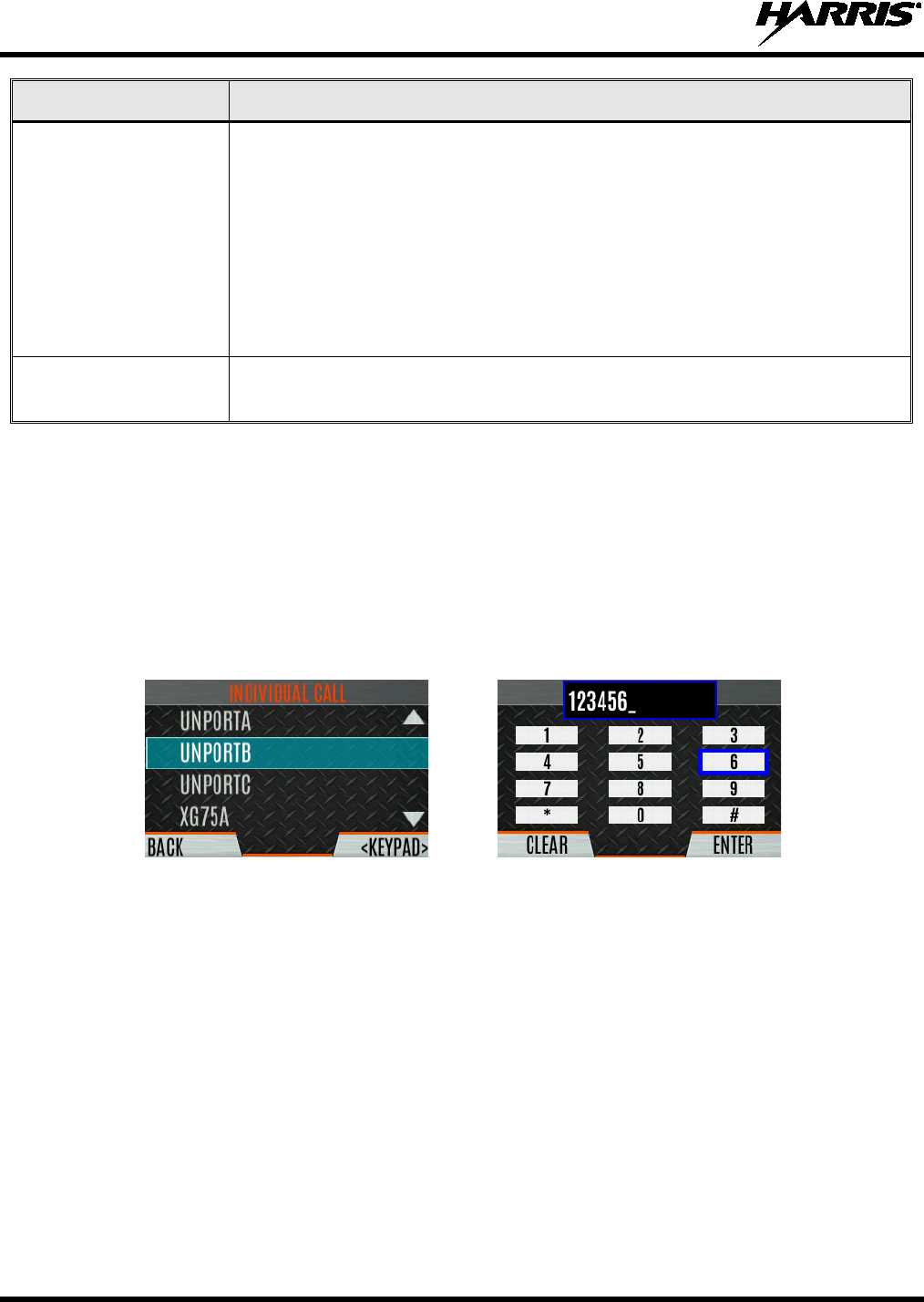
14221-1800-2000, Rev. G
36
CONTROL/INDICATOR
FUNCTION
Navigation Buttons
Navigates menu items.
In addition:
Press the left navigation button (
) while on the idle display to access Channel
Information (see Section 6.4).
Press the down navigation button () while on the idle
display to display the
functions assigned to programmable buttons (see Section 7.4).
Press the up navigation button () to display Missed Call info.
Press the right navigation button () to end or reject an I-Call.
Keypad
By default, used to enter text or numbers. Can be programmed for various
functions (see Section 7.4).
5.2 SOFT DTMF KEYPAD
The partial keypad model of the radio supports a “soft” DTMF keypad. This allows the radio user to
utilize a graphical DTMF keypad in place of a physical DTMF keypad.
On screens that require keypad entry, press the KEYPAD softkey to display the keypad. Use the
navigation buttons to highlight the desired number, press the Menu/Select button to select highlighted
digit, and then press the ENTER softkey.
For example, when placing an Individual Call to a numeric address, the soft DTMF keypad can be used to
enter the address as shown:
Figure 5-2: Using the Soft DTMF Keypad
5.3 BEFORE FIRST USE
Make sure the radio has:
• Fully charged battery
• Antenna attached
• Personality and radio programmed using RPM2
• Encryption keys loaded if using encrypted channels
• Personality activated
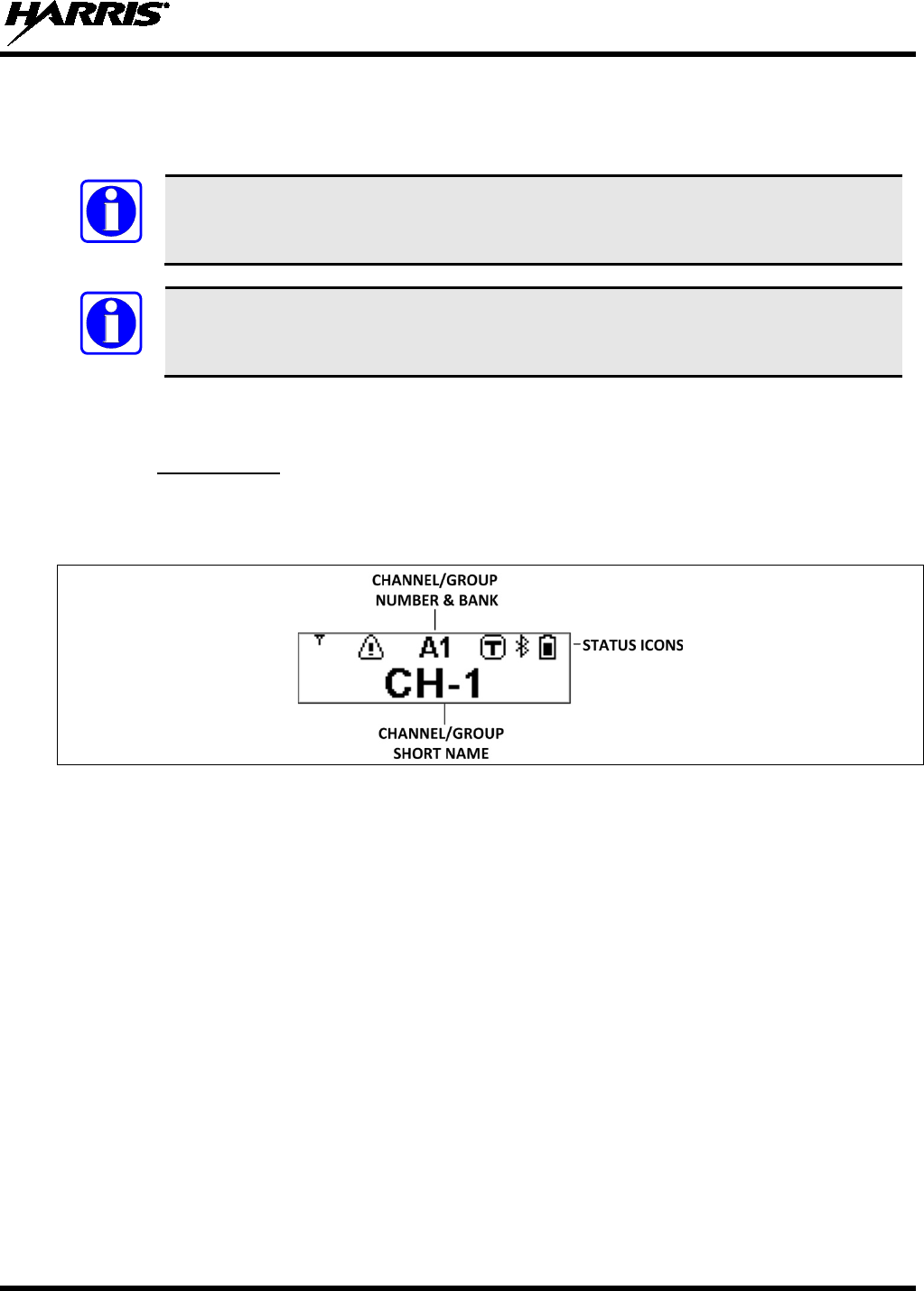
14221-1800-2000, Rev. G
37
5.4 POWER ON AND SET VOLUME
The power switch and volume control are the same knob on top of the radio (see Figure 5-1). Turn the
Power/Volume Knob clockwise to power on radio and increase the volume.
A minimum volume level can be programmed into the radio to prevent missed calls due
to a low volume setting.
The radio can be programmed to require the entry of a PIN to operate the radio. Check
with your System Administrator if you forget your PIN. As the PIN is entered, an asterisk
is displayed for each digit; the actual value is not displayed.
5.5 RADIO DISPLAYS
5.5.1 Top Display
The top display (Figure 5-3) shows a summary of status, such as channel number/bank, channel short
name, battery, scanning, and emergency mode. The display can be configured for viewing from the front
or rear of the radio (see Section 6.6). The channel short name is programmed using RPM2.
Figure 5-3: Top Display
NOTE
NOTE
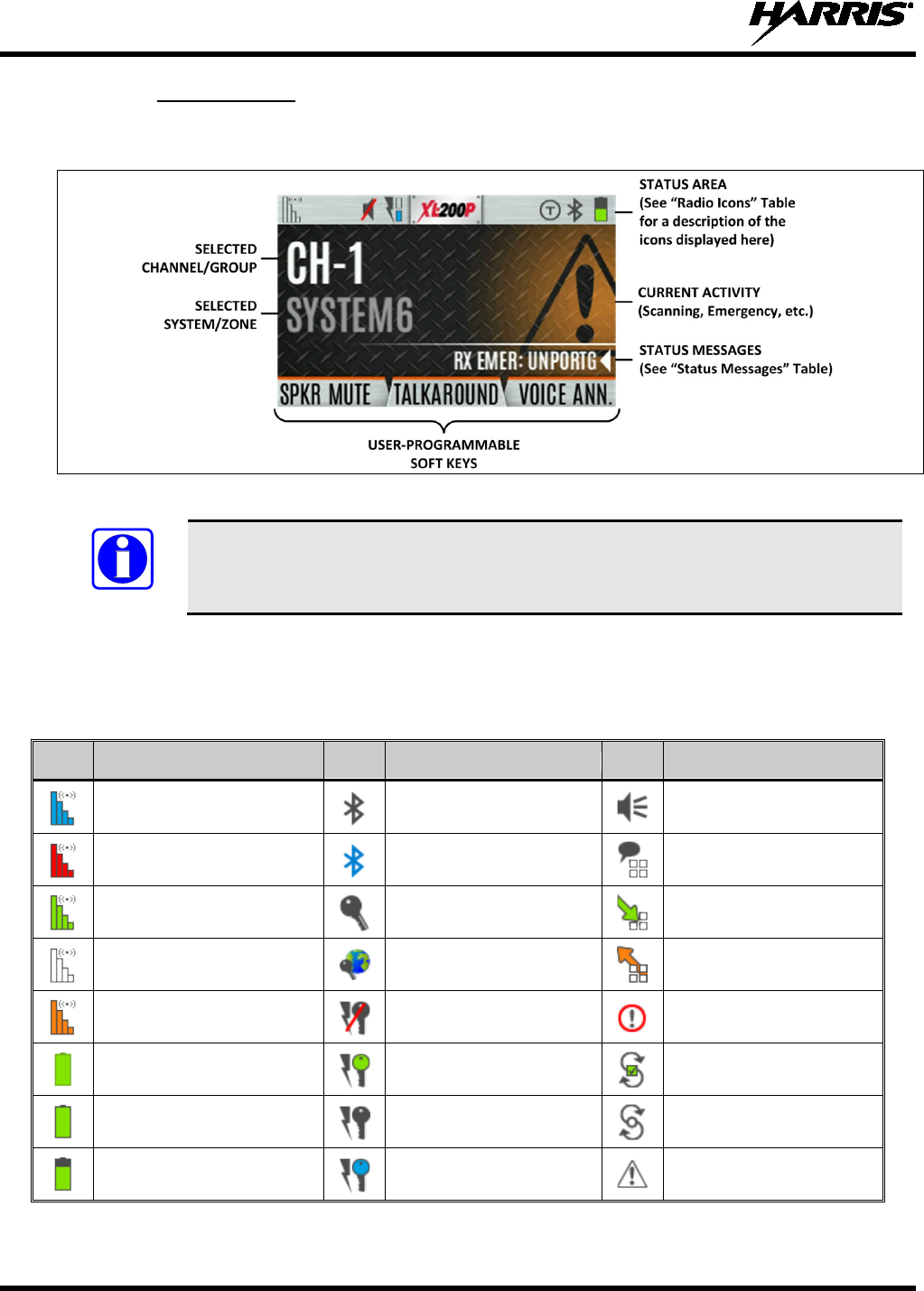
14221-1800-2000, Rev. G
38
5.5.2 Front Display
Figure 5-4 shows a sample front display while on the idle screen. The idle screen appears after power up
or after exiting from the menus.
Figure 5-4: Sample Idle Front Display
The radio can be programmed to display the User ID on the System line of the display.
Table 5-2 describes some of the icons that may be displayed by the radio. The radio menu also contains
an icon glossary in the Utility Menu (see Section 5.8). Icons and their location can be customized using
RPM2.
Table 5-2: Radio Icons
ICON
DESCRIPTION
ICON
DESCRIPTION
ICON
DESCRIPTION
(Blue)
Trunked Signal Strength
Bluetooth Enabled
Monitor On
(Red)
TX Power
(Blue)
Bluetooth Connected
VDOC
(Green)
Receive Signal Strength
Encryption Enabled
Receiving Data
(No Color)
Channel Idle
Global Encryption
Transmitting Data
(Orange)
Transmitting Encrypted
OTAR Disabled
Alert(s) Present
Battery Fully Charged
OTAR Registered
Vote Scanning
Battery Level
100% Capacity
OTAR Registering
Scanning Enabled
Battery Level
75% Capacity
OTAR Rekeying
Emergency
NOTE
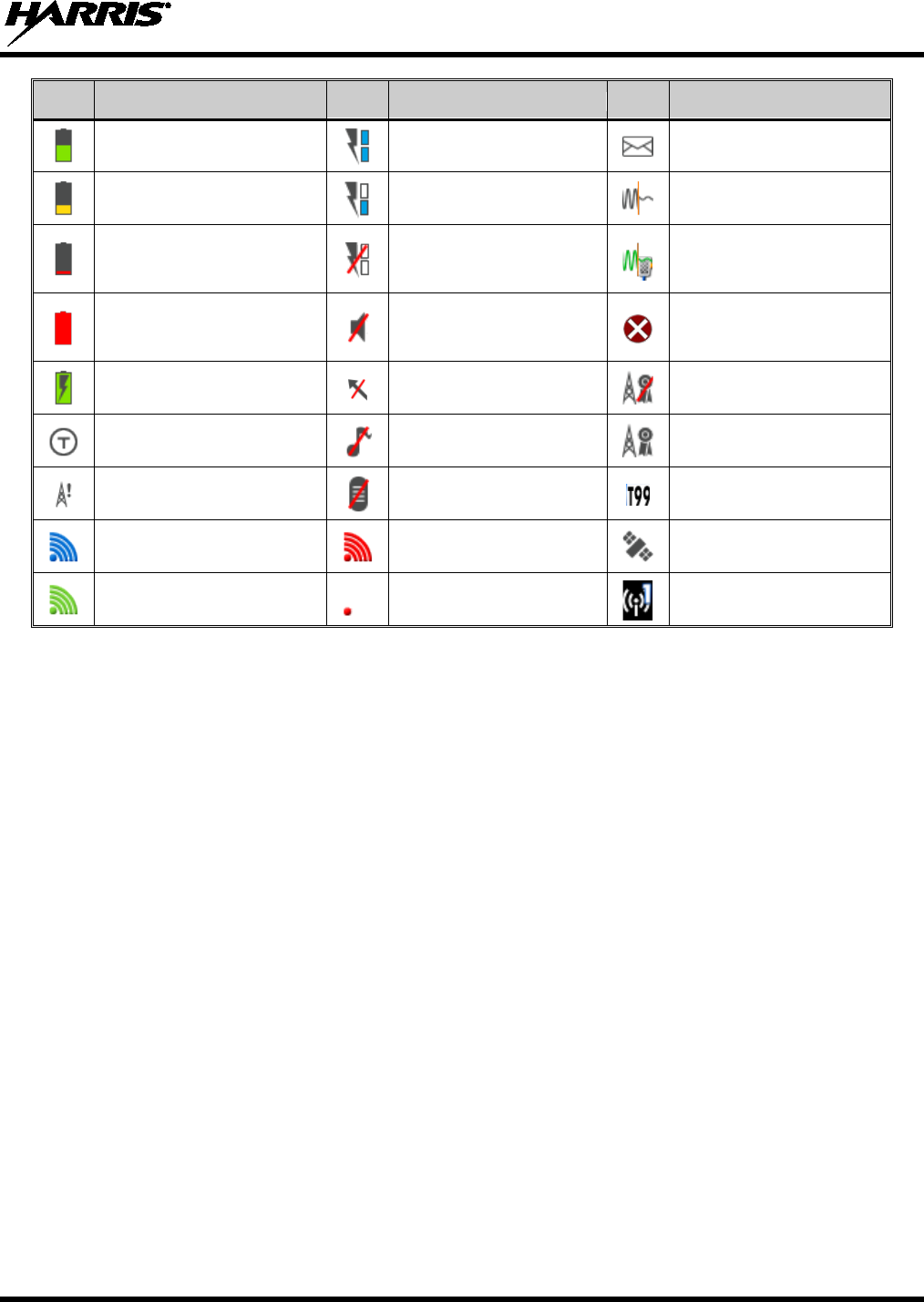
14221-1800-2000, Rev. G
39
ICON
DESCRIPTION
ICON
DESCRIPTION
ICON
DESCRIPTION
Battery Level
50% Capacity
Transmit Power Level High
RX Mail
Battery Level
25% Capacity
Transmit Power Level Low
Noise Cancellation Enabled
Battery Level
5% Capacity
(Low Battery Audio Indicator)
RX Only Fire Speaker Mic Attached
Battery Level
Battery Exhausted
(RX-Only State)
Speaker Muted Nuisance Channel
Battery Charging
TX Disabled
Conventional Site
Unregistered
Talkaround Enabled
Tones Disabled
Conventional Site
Registered
Failsoft
PTT Disabled Type 99 Enabled
LTE – Registered
Foreign Network
LTE – Denied or Unknown
Registration Status
GPS Tracking
LTE – Registered Home
LTE – No Signal
Wi-Fi Clients Connected

14221-1800-2000, Rev. G
40
5.6 MANDOWN
If enabled via radio programming, the following conditions can be configured to trigger a Mandown
condition:
• MOTION - Mandown is declared with lack of motion.
• TILT - Mandown is declared when the radio is tilted.
• BOTH - Mandown is declared by radio tilting and lack of motion.
This can be useful if, for example, a radio user is in danger and has not moved for a certain amount of
time. If the user’s movement falls below the configured level, then a tone begins playing. An Emergency
is declared on the channel/group based on the radio’s Emergency configuration.
5.7 STATUS MESSSAGES
The radio may display various radio Status Messages during operation. These messages are described in
Table 5-3. Table 5-3: Status Messages
MESSAGE DESCRIPTION
PTT DENIED P25 Trunked and EDACS - The radio or talkgroup is not authorized to operate on the selected
system and/or talkgroup.
CALL QUEUED P25 Trunked and EDACS - The system has placed the call in a request queue.
SYSTEM BUSY P25 Trunked and EDACS - The system is busy, no channels are currently available, the queue is
full, or an individual call is being attempted to a radio that is currently transmitting.
SCANNING The radio is scanning.
TX EMERGENCY An emergency call is being transmitted.
RX EMERGENCY An emergency call is being received. The radio displays the unit name or unit ID.
WIDE AREA SCAN P25 Trunked and EDACS - The radio has entered the Wide Area Scan mode to search for a new
system.
INVALID TALKGROUP P25 Trunked and EDACS - The current talkgroup is not valid for the current system. This could
happen if the site denies registration due to an unrecognized talkgroup ID.
INVALID UNIT P25 Trunked and EDACS - The current unit is not valid for the current system.
REGISTERING P25 Trunked only - Displayed when the radio is performing a registration/affiliation on a P25
trunking site.
CTRL CHANNEL SCAN P25 Trunked and EDACS - The control channel is lost and the radio has entered the Control
Channel Scan mode to search for the control channel (usually out of range indication).
BAND SCANNING
P25 Trunked and EDACS - Only displayed if the system is configured for "EnhancedCC" mode of
operation. When the radio cannot find a Control Channel in either the trunked frequency set or the
list of discovered adjacencies, the radio can perform a full spectrum frequency scan to find a new
Control Channel.
MISSED CALL P25 Modes and EDACS - Another user has tried to call or page this radio. The user can view who
the caller was by pressing the key.
OTAR REKEY COMPLETE OTAR Rekey operation completed successfully.
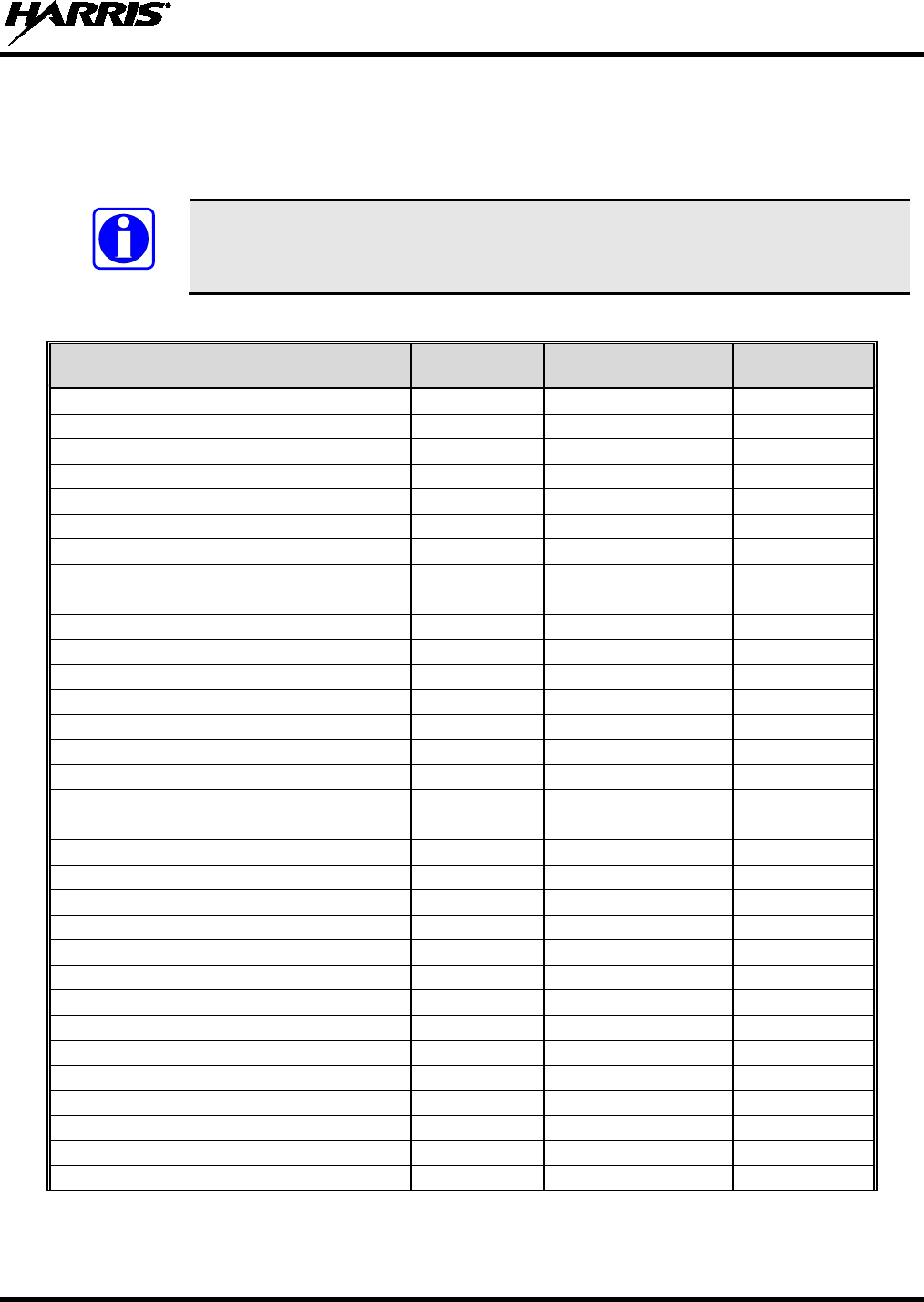
14221-1800-2000, Rev. G
41
5.8 PREDEFINED MENU LAYOUTS
Depending on radio programming, some menu options described in this manual may not be available.
The radio supports three predefined menu layouts: Full, Custom, and Restricted. Table 5-4 details what is
available in each layout:
The Custom predefined menu layout allows the administrator to customize the list of
menu items that are available to the radio user. Table 5-4 lists the default settings.
Table 5-4: Predefined Menu Layouts
MENU FULL
CUSTOM
(Default Settings)
RESTRICTED
Call Menu
Yes
Yes
Yes
Exit Emergency
Yes
Yes
Yes
Talkaround
Yes
Yes
Yes
Individual Call
Yes
Yes
Yes
Change Talkgroup
Yes
Yes
Yes
Call Alert/Page
Yes
Yes
Yes
Channel Guard
Yes
Yes
Yes
Audio Playback
Yes
Yes
No
Tone Encode
Yes
Yes
Yes
T99
Yes
Yes
Yes
Audio Settings
Yes
No
No
Display Settings
Yes
Yes
Yes
GPS Settings
Yes
No
No
Clock Settings
Yes
Yes
No
Bluetooth Settings
Yes
Yes
No
Scan Menu
Yes
Yes
Yes
Enable/Disable Scan
Yes
Yes
Yes
View Scan List
Yes
Yes
No
Edit Zone Scan List
Yes
No
No
View Custom Channels
Yes
Yes
No
Edit Custom Scan List
Yes
No
No
Custom Scan
Yes
Yes
No
Site Roam
Yes
Yes
No
Security Menu
Yes
Yes
Yes
Encryption Enable
Yes
Yes
Yes
Zeroize
Yes
No
No
Global CKR Enable
Yes
No
No
GCKR Key Select
Yes
No
No
Active Key Set
Yes
Yes
Yes
Key List
Yes
Yes
No
OTAR Enable
Yes
Yes
No
OTAR Rekey
Yes
Yes
Yes
NOTE

14221-1800-2000, Rev. G
42
MENU FULL
CUSTOM
(Default Settings)
RESTRICTED
Message Menu
Yes
Yes
Yes
Radio Status
Yes
Yes
No
Radio Message
Yes
Yes
No
Textlink Messages
Yes
Yes
No
Textlink Forms
Yes
Yes
No
Textlink Mailbox
Yes
Yes
No
Faults
Yes
Yes
Yes
Program Menu
Yes
Yes
No
Activate Plan
Yes
Yes
No
Activate Profile
Yes
Yes
No
Maintenance Menu
Yes
Yes
Yes
Radio Info
Yes
Yes
No
Battery
Yes
Yes
No
TCXO Tuning
Yes
No
No
P25 Tests
Yes
No
No
RSSI Display
Yes
Yes
Yes
Phase II Display
Yes
Yes
No
Feature Info
Yes
Yes
No
WiFi Access Point
Yes
Yes
Yes
Change Language
Yes
No
No
Change PIN
Yes
Yes
Yes
Icon Glossary
Yes
Yes
Yes
Install GPP Software x
Yes
Yes
Yes
Zone
Yes
Yes
No
5.9 MENU
Press the Menu/Select button while on the idle display to access the menu. Press the left or right
navigation buttons to scroll through the top-level menus, and press the up or down navigation buttons to
scroll through the sub-menus. Refer to Figure 5-1 for button location. While in a menu, press the
Menu/Select button to choose, activate, or toggle the selected item; similar to an enter key. Table 5-5
provides a high-level overview of the menu layout. Menu options on your radio may vary depending on
available features and radio programming.
Table 5-5: Menu Navigation
MENUS
DESCRIPTION
CALL MENU:
EXIT EMERGENCY MODE
Exits emergency. See Section 5.32 for more information.
TALKAROUND MODE
Enable/disable talk-around. See Section 5.23 for more information.
T99 TOGGLE Enable/disable T99. See Section 5.24 for more information.
TONE ENCODE
Analog conventional only - Transmits a programmed tone sequence on the current
radio system and channel. See Section 6.19 for more information.
INDIVIDUAL CALL
Allows you to select an individual for an individual call. See Section 5.15 for more
information.
CHANGE TLKGRP
Change the selected talkgroup. See Section 5.14.
CALL ALERT
Select a group for Call Alert transmission. See Section 5.25.
CHANNEL GUARD Select the Transmit and/or Receive Channel Guard tone. See Section 5.22.

14221-1800-2000, Rev. G
43
MENUS
DESCRIPTION
AUDIO PLAYBACK
Replays the last recorded call. See Section 5.27 for more information.
SCAN MENU:
START SCAN/STOP SCAN
Start or stop scan operation. See Sections 5.28 and 5.29.
SCAN LISTS
View/Edit available scan lists. See Section 6.14.
ASSIGNED CUSTOM LIST Create, View, and Edit Custom Scan Lists. See Section 6.14.6.
SITE ROAMING
Enable/Disable Wide Area System Scan. See Section 6.14.7.
SITE ALIAS
Select an available site from this list to lock the radio to; i.e., prevent the radio from
roaming. This is also known as Site Lock. See Section 6.14.8 for more information.
SECURITY MENU:
ZEROIZE KEYS
Removes all encryption keys from the radio. See Section 6.20.2.
ENCRYPTION
Enable/Disable encryption. See Section 5.20.
GLOBAL ENCRYPTION Enable/Disable Global Encryption. See Section 6.20.4.
GLOBAL KEY
Select the Global Key. Only available if Global Encryption is Enabled. See Section
6.20.4.
ACTIVE KEYSET
Select the Active Keyset. See Section 6.20.5.
KEY LIST
View available key lists. See Section 6.20.6
.
OTAR
Enable/disable Over-the-Air Rekeying (OTAR). See Section 6.20.7.
OTAR REKEY Request that the KMF updates the keys in the radio. See Section 6.20.7.
MESSAGES MENU:
RADIO STATUS Used to send a status condition to the site without making a voice call. See Section
6.14.8.
RADIO MESSAGE
Used to send a message to the site without making a voice call. See Section 6.16.
TEXTLINK MESSAGES
Allows the user to send a Radio TextLink message. See Section 6.17.
TEXTLINK FORMS
Allows the user to send a Radio TextLink form. See Section 6.17.
TEXTLINK MAILBOX Contains received Radio TextLink messages. See Section 6.17
.
FAULTS/ALERTS
Displays radio faults and alerts. See Section 6.18.
UTILITY MENU:
AUDIO SETTINGS:
•
SPEAKER (MUTE/UNMUTE)
Mute or unmute the speaker audio.
•
NOISE CANCELLATION
Enable or disable Noise Cancellation. See Section 5.17.
• PTT
Enable or disable Push-To-Talk (PTT). Disable PTT to prevent accidental keying, such
as when radio is in the holster or you are getting into a car.
•
TONES
Enable or disable radio side tones.
•
KEYPAD TONES
Enable or disable tones that sound when the radio’s keypad buttons are pressed.
DISPLAY SETTINGS:
• COLOR SCHEME Press the Menu/Select button to toggle the front and top display’s COLOR SCHEME for
optimum visibility in day or night conditions (NORMAL or INVERTED).
• FRONT BACKLIGHT
Press the Menu/Select button to toggle the front display backlighting between
ON/OFF/MOMENTARY/MOMENTARY (OFF).
•
FRONT BRIGHTNESS
Press the left or right navigation buttons to dim or brighten the display.
• FRONT TIMEOUT
When the FRONT BACKLIGHT setting is MOMENTARY, this value specifies how long
the radio needs to be inactive before the front display’s backlight turns off. Press the left
or right navigation buttons to change the time in 0.5 second increments.
• FRONT DISPLAY OFF
Turns the front display off completely. Press the Menu/Select button to turn the front
display back on.
• TOP BACKLIGHT
Press the Menu/Select button to toggle the top display backlighting
ON/OFF/MOMENTARY.
•
TOP BRIGHTNESS
Press the left or right navigation buttons to dim or brighten the display.
• TOP TIMEOUT
When the TOP BACKLIGHT setting is MOMENTARY, this value specifies how long the
radio needs to be inactive before the top display’s backlight turns off. Press the left or
right navigation buttons to change the time in 0.5 second increments.
• TOP ORIENTATION
Set orientation of top display to be viewed from radio: FRONT, BACK, or AUTO. When
AUTO is selected, the radio changes the top display to be viewed from the back if an
external microphone or speaker is attached. Otherwise, the display can be viewed from
the front.
•
INDICATOR LED
Press the Menu/Select button to toggle the indicator LED ON or OFF.

14221-1800-2000, Rev. G
44
MENUS
DESCRIPTION
BLUETOOTH:
•
ENABLED (YES/NO)
Enable/disable Bluetooth. See Section 6.10 for more information.
• PAIRING MGMT
Pair Bluetooth devices with the radio. See Section 6.10 for more information.
CLOCK SETTINGS:
•
TIME FORMAT
Select 12 or 24-hour time display format.
•
TIME ZONE
Set time zone relative to Universal Time Coordinated (UTC).
GPS SETTINGS:
•
GPS (ENABLED/DISABLED)
Enable/disable GPS.
• POSITION INFO
Displays GPS, Latitude, Longitude, and Altitude information. From this menu, click
NEXT
to access SA INFO (see Section 6.2).
• ANGULAR UNITS
Set unit of measurement of displayed angular units: CARDINAL, DEGREES, or MILS.
•
LINEAR UNITS
Set unit of measurement of displayed linear units: STATUTE, METRIC, or NAUTICAL.
• POSITION FORMAT
Set format of displayed position information: Latitude/Longitude Decimal Degrees (LAT
LONG DD), Latitude/Longitude Degrees Minutes Seconds (LAT/LONG DMS),
LAT/LONG DM, Military Grid Reference System (MGRS), or Universal Transverse
Mercator (UTM).
• SA OVER NETWORK
When Enabled, the radio sends GPS data to a Harris-supplied PC client using RNDIS
networking.
PROGRAM:
•
ACTIVATE PLAN
View/Activate a personality. See Section 6.1.
• PROFILES
Change current profile. See Section 5.16.
MAINTENANCE:
• BATTERY INFO
When a smart battery is attached, displays detailed battery status information. When a
regular battery is attached, displays battery voltage.
• RADIO INFO
Displays radio information, i.e., ESN, software revisions, and firmware revisions.
•
TESTS
Allows service personnel to run radio tests.
•
PH2 LC DISPLAY
For field service use only.
• DISPLAY RSSI
When enabled, RSSI is displayed on the RSSI screen and in the bottom of the idle
display. -130 dBm is displayed when there is no received signal.
• TCXO TUNING
For field service personnel only. Improper adjustment will result in loss of
communications.
• FEATURE INFO
Displays what features are enabled on your radio.
WIFI CLIENT:
Displays the status of Wi-Fi Connection (CONNECTED or DISCONNECTED).
•
POWER
Turn Wi-Fi on/off.
• ADD NETWORK
Displays the list of Trusted Wi-Fi Networks and is populated when Wi-Fi is powered on.
You can view, add, modify, and remove a Wi-Fi Network.
WIFI ACCESS POINT:
• POWER
Power Wi-Fi On/Off.
• CLIENT COUNT
When the radio is configured as a Wi-Fi access point, displays the number of connected
clients.
LTE:
•
PLMN (MCC/MNC):
Displays the Public Land Mobile Network (Mobile Country Code/Mobile Network Code).
•
Signal Strength:
Displays the LTE signal strength.
•
Registration Status:
Indicates if you are registered (connected) to the LTE network.
• NGLM:
Displays the Next Generation LTE Module’s software revision.
• IMEI:
Displays the International Mobile Equipment Identity. The IMEI is used to identify
devices on a network.
• IMSI:
Displays the International Mobile Subscriber Identity. The IMSI is used to identify the
user of a cellular network and is a unique identification associated with all cellular
networks.
ICON GLOSSARY
Defines icons displayed by the radio.
INSTALL GPP SOFTWARE:
Select a GPP package to install.
CHANGE LANGUAGE
Press the up or down navigation buttons until the desired language is highlighted and
then press Menu/Select button.
CHANGE PIN
Allows you to change your PIN.
ZONE MENU:
View or change zones/systems (see Sections 5.11 and 6.3.1).

14221-1800-2000, Rev. G
45
5.10 ALERT TONES
The radio provides audible Alert Tones or “beeps” to indicate various operating conditions. Some of the
most common tones are described in Table 5-6.
Table 5-6: Alert Tones
TONE DESCRIPTION SOUND/DURATION
Ready to Talk Tone
Unencrypted (Analog FM or
P25 digital)
After a PTT is pressed, this is an audible indication (tone) for
you to begin speaking into the microphone. 1000 Hz tone for 25 ms
Ready to Talk Tone
Encrypted P25 digital After a PTT is pressed, this is an audible indication (tone) for
you to begin speaking into the microphone. 1200 Hz tone for 25 ms
PTT Denied
PTT not possible. Momentary tone is present:
• Receive only
• Key not found
• PTT button disabled
• Emergency button disabled
• Emergency not supported for current channel
• Clear transmit denied
• Trunking Channel unavailable
544 Hz tone for 75 ms
Maximum transmit duration
expires Maximum transmit duration is exceeded. 5 beeps of 2400 Hz tone and
then a 544 Hz tone for as long
as PTT is pressed
Low Battery Alarm Alarm sounds upon initial detection of low battery and every
30 seconds thereafter. Tone stops upon detection of a battery
charging state.
Sequence of tones:
• 937 Hz tone for 50 ms
• Silence for 60 ms
• 1300 Hz tone for 50 ms
Emergency Call Received Radio is receiving an emergency call or priority call. 600 Hz tone for 250 ms and
1800 Hz tone for 250 ms
Out of Range Radio fails to find a local control channel.
Programmable via RPM2:
• Disabled (no tone)
• Slow (tone every 15s)
• Medium (tone every 10s)
• Fast (tone every 5s)
• Tones is 544 Hz tone for 75
ms
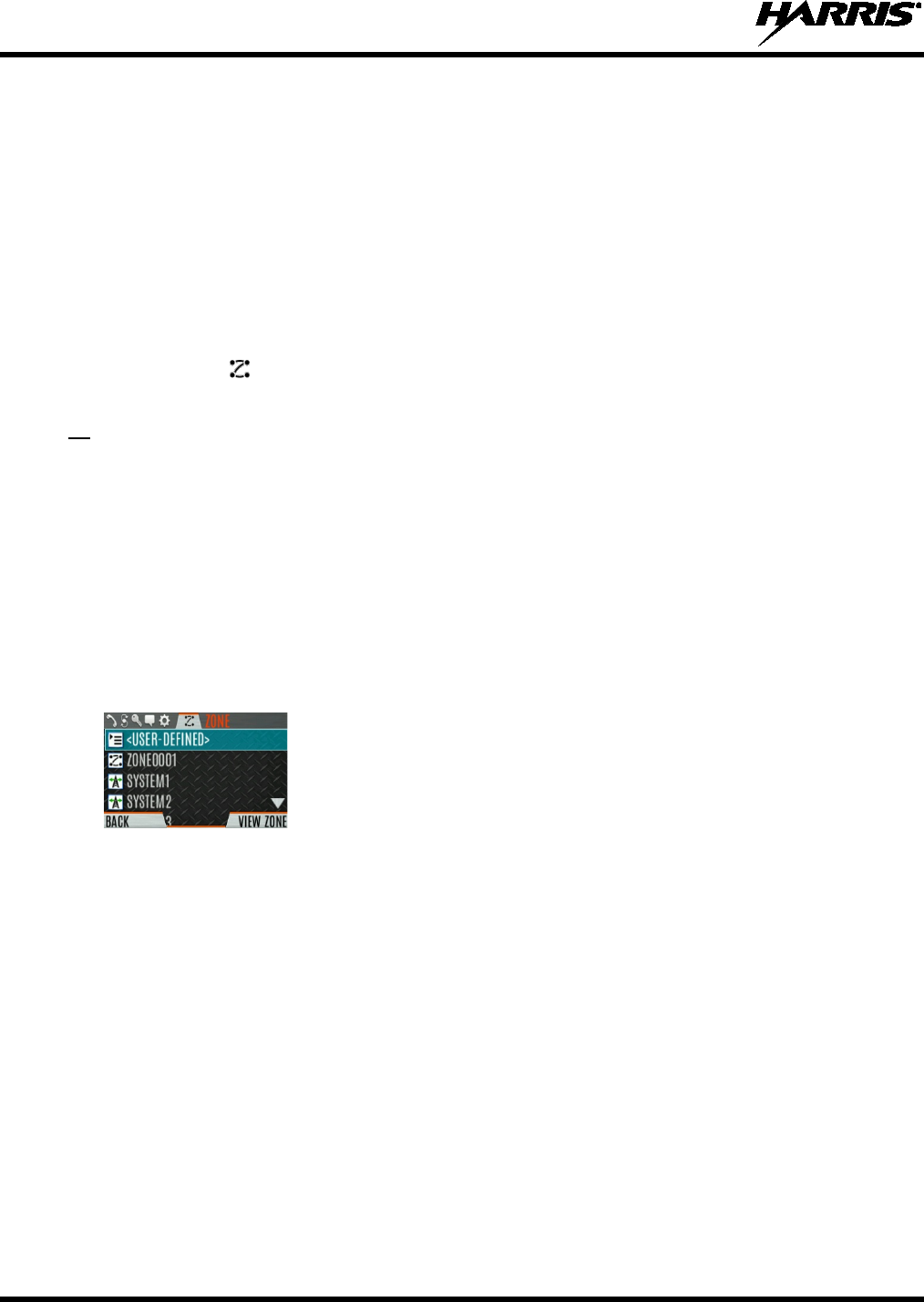
14221-1800-2000, Rev. G
46
5.11 SELECT ZONE/SYSTEM
A System is a group of channels or talkgroups that share a common set of parameters as programmed
using RPM2. For example, a Trunking system defines the parameters needed to communicate on an
infrastructure by agency or geographical region, such as WACN, System ID, Talkgroups, etc. A
conventional system defines the channel set used and any specific signaling attributes (See RPM2 for
more information on System attributes). Systems are designated by the XX icon in the Zone/System
menu.
A Zone is an OPTIONAL container that can hold channels or talkgroups from a variety of systems (see
Section 6.3.2). In other words, each member of a Zone belongs to an underlying system. (See RPM2 for
more information on Zone attributes). Zones are always listed first in the Zone/System menu and are
designated by the icon. A button on the radio can be programmed to scroll through available
zones/systems (see Section 7.4).
Or
To select a zone/system via the menu:
1. Press the Menu/Select button to access the menus.
2. Use the left or right navigation buttons to display the ZONE menu. The currently selected
zone/system will be highlighted. A personality can have up to 512 systems and up to 50 Zones,
independent of banks or channels.
3. Use the up or down navigation buttons to highlight the desired zone/system. The and buttons
may be held to scroll repetitively, and the menu will wrap to allow quick access to a zone/system,
4. Press the VIEW ZONE soft key to view channels in the zone/system, or select the desired
zone/system using the Menu/Select button.

14221-1800-2000, Rev. G
47
5.12 SELECT GROUP/CHANNEL AND BANK
The radio can be programmed with 1,250 talkgroups or 1000 channels per personality. Use the
Group/Channel knob to select groups/channels 1 - 16. Use the A/B/C/D switch to set the bank. The
selected bank is indicated on the display.
• Bank A: Channel A1 - A16 (1-16)
• Bank B: Channel B1 - B16 (17-32)
• Bank C: Channel C1 - C16 (33-48)
• Bank D: Channel D1 - D16 (49-64)
If your system has more than 64 groups/channels, a button on the radio can be programmed for the SEL
CHAN/GRP option. This allows you to select a “super bank,” providing access to groups/channels
beyond the first 64.
Note that ZONES have a limit of 64 entries per zone and cannot be “superbanked.”
Direct Channel Entry
A button on the radio can be programmed for Direct Channel Entry, which allows the user to enter the
talkgroup/channel number directly from the keypad.
The radio can be programmed for one of the following Direct Channel Entry options:
• When a Zone is selected on the radio, Direct Channel Entry performs a lookup using the currently
selected system’s group list
Or
• When a Zone is selected on the radio, Direct Channel Entry performs a lookup using the currently
selected Zone’s system/group list.
5.13 LOCK/UNLOCK KEYPAD
There are two levels of keypad lock available. Keypad lock and Radio lock. Keypad lock only locks the
navigation keys (except for use in unlock), programmable softkeys, and DTMF keypad. Radio lock
disables all physical keys and knobs except:
• The 4-position switch
• PTT
• Emergency Button
• Any User Programmable Button (UPB) programmed for Monitor/Clear. (This is required to allow
Monitor/Clear to function for 2-button emergency clear.)
The A/B switch, ABCD switch, or a button on the radio can be programmed to lock the keypad/radio. If
the keypad was locked via a switch, moving the switch to another position will unlock the keypad. If
locked via a button, the navigation keys must be used to enter the unlock sequence of Left, Right, Up
Down.
See Section 7.4
for the various options that can be programmed to the radio buttons
and switches.
NOTE
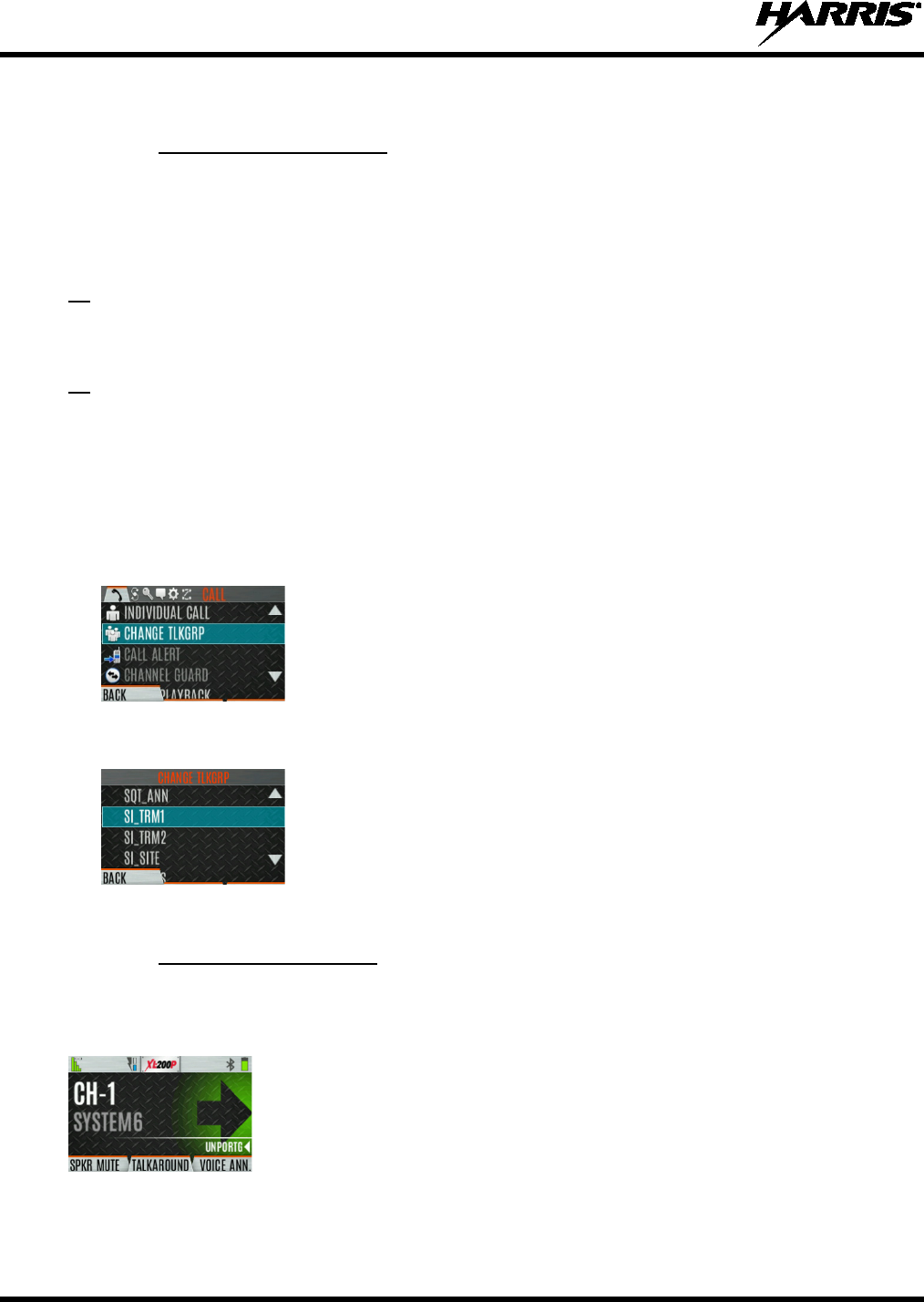
14221-1800-2000, Rev. G
48
5.14 GROUP CALLS
5.14.1 Transmit a Group Call
A talkgroup is a group of radios that you want to have private conversations with. These groups can be
divided into areas such as state, region, county, or large special events. A group call can only be made on
digital channels.
Turn the Channel/Group knob to select the desired group (see Figure 5-1). Press PTT to transmit.
Or
A button on the radio can be programmed for DIRECT CHANNEL ENTRY to allow the user to enter the
talkgroup/channel number. Press PTT to transmit.
Or
To transmit a group call:
1. In P25 Conventional, the talkgroup for the selected channel may be overridden as follows: Press the
Menu/Select button to access the main menu.
2. Press the left or right navigation buttons to display the CALL menu.
3. Press the up or down navigation buttons to highlight CHANGE TLKGRP and press the Menu/Select
button.
4. Press the up or down navigation buttons to highlight and the desired talkgroup and press the
Menu/Select button. After selecting the new talkgroup, the radio returns to the main screen.
5. Press the PTT button to transmit.
5.14.2 Receive a Group Call
When receiving a group call, the status area of the idle display toggles between the Unit Name and the
Group Name of the transmitting radio. Note that if either of those names is not programmed the
corresponding ID number is displayed.
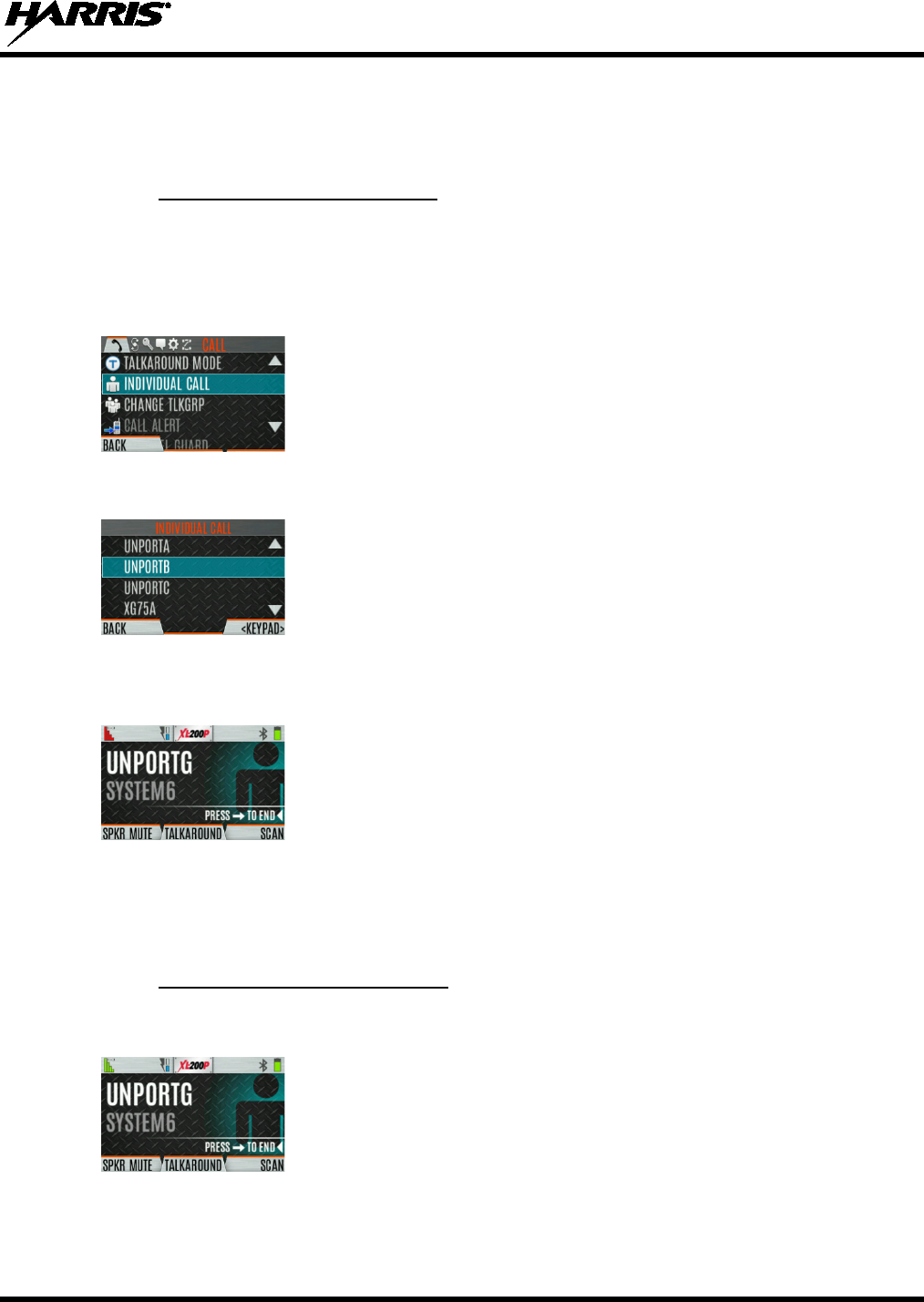
14221-1800-2000, Rev. G
49
5.15 INDIVIDUAL CALLS
An individual call is used to make a call to one radio as opposed to a group of radios. An individual call
can only be made on a digital channel.
5.15.1 Transmit an Individual Call
1. Press Menu/Select button to access the main menu.
2. Press the left or right navigation buttons to display the CALL menu.
3. Press the up or down navigation buttons to highlight INDIVIDUAL CALL and press the
Menu/Select button.
4. Use the up or down navigation buttons to highlight the unit to call and press the Menu/Select button,
or select KEYPAD to enter the Unit ID.
5. Press PTT to make the call. When transmitting an Individual Call, the radio displays the called
radio’s name or Unit ID. If the radio is programmed for Acknowledged Individual Call, the radio
displays “CALL QUEUED” until the callee answers or rejects the call.
6. After the callee answers, press PTT to respond.
7. Press to end the call.
How long the radio remains in Individual Call mode with no activity is programmable.
5.15.2 Receiving an Individual Call
1. When receiving an Individual Call, the radio displays the calling radio’s name or Unit ID. The radio
will also display “Press to END.”
2. Press PTT to respond or to END/REJECT the call. How long the radio remains in the Individual
Call mode with no activity is programmable.
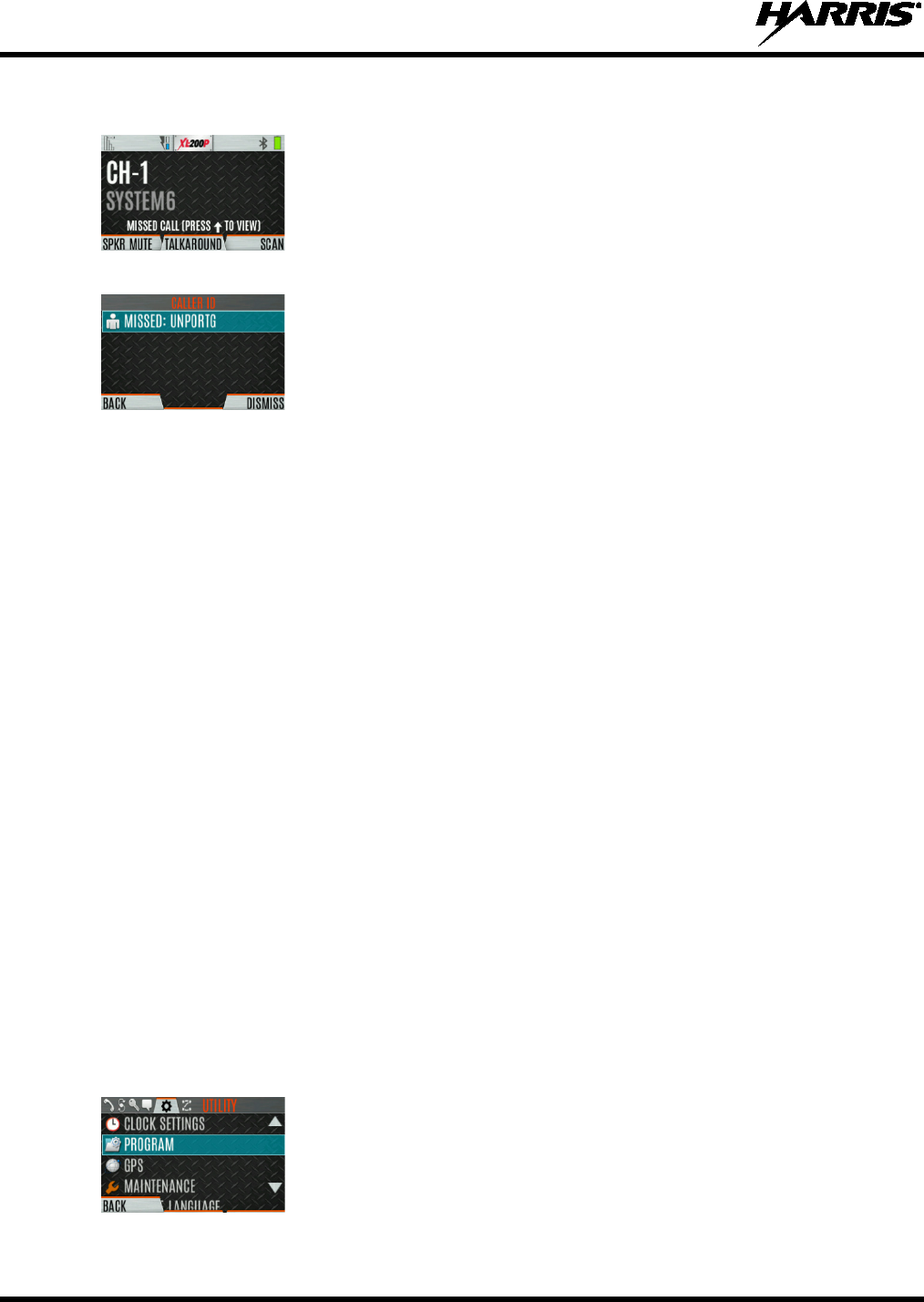
14221-1800-2000, Rev. G
50
3. The radio rings and indicates a missed call if you do not respond. The ring sounds until you press
PTT, view the missed call menu (), change channel/group/system, or power cycle the radio.
4. On the missed call screen, press the DISMISS soft key to clear the entry.
5.16 USER PROFILES
XL-series radios support User Profiles (also referred to as “My Profile”). A User Profile is a grouping of
preset configurations that allow the user to change radio operation based on current activity/scenario. For
example, the radio can be programmed with profiles named Noisy, Fire, etc., and the radio user can
switch profiles on the radio depending on the environment they are entering. User Profile selection
persists across system/group changes and power cycles. Up to 10 profiles can be programmed to the
radio. When you activate a new personality, the selected Profile changes to None.
A "Covert" Profile is installed on the radio by default. This profile cannot be modified or deleted. The
following attributes apply when the Covert profile is active:
• The speaker is enabled.
• All tones are disabled.
• Keypad tones are disabled.
• Voice Annunciation is disabled.
• The front display backlight is disabled
• The top backlight is turned off.
• The indicator LED is disabled.
• All other attributes remain at their current value.
To change the currently selected Profile:
1. Press the Menu/Select button to access the menu.
2. Press the left or right navigation buttons until the UTILITY menu is displayed.
3. Press the up or down navigation buttons to highlight PROGRAM and press the Menu/Select button.
4. Press the left or right navigation buttons until the PROFILES menu is displayed.
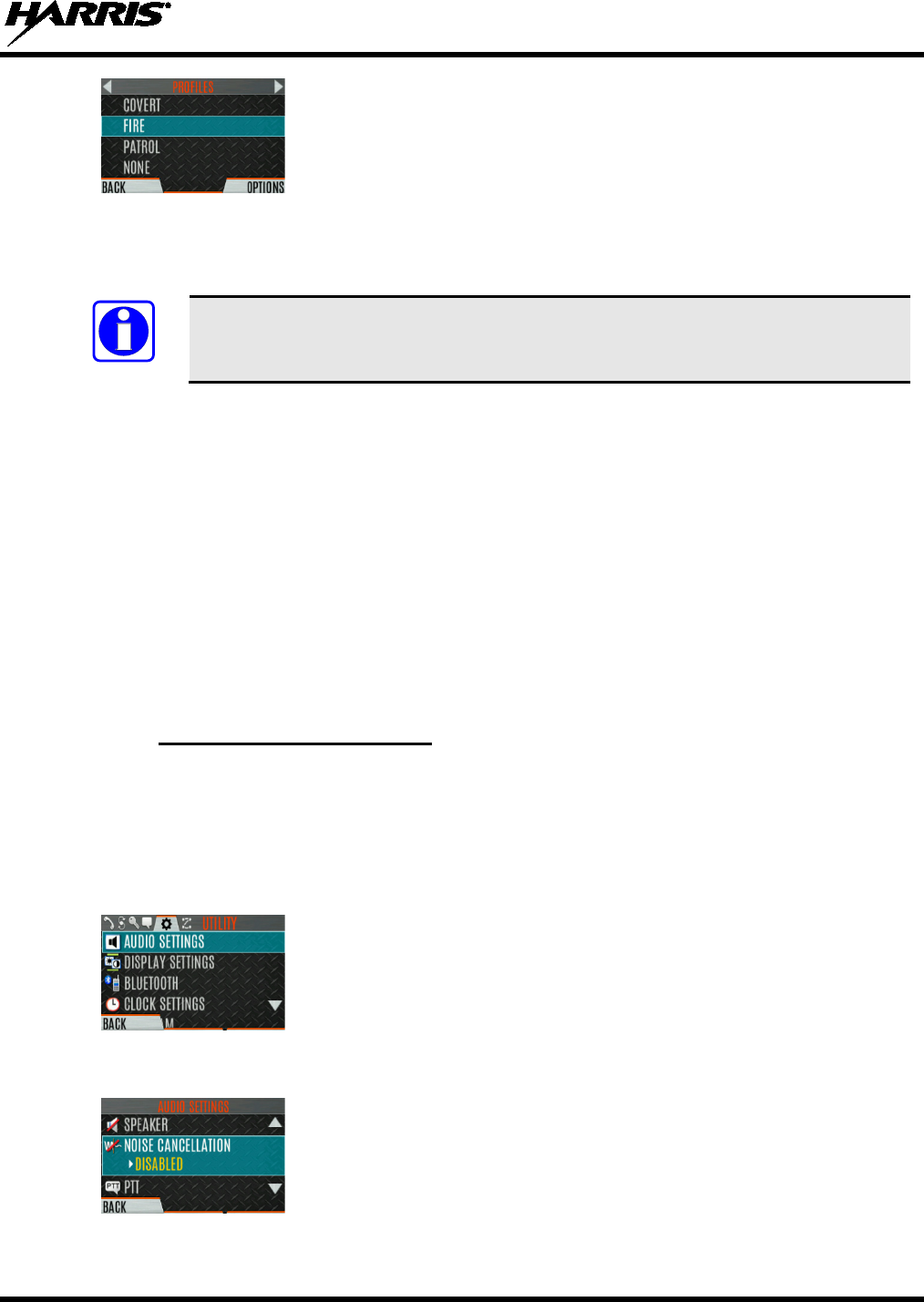
14221-1800-2000, Rev. G
51
5. Press the up or down navigation buttons to select the desired Profile and press the Menu/Select
button.
A profile change persists across system/channel changes and power cycles.
A button on the radio keypad can be used to toggle profiles. See Section 7.4.1.
5.17 NOISE CANCELLATION
The XL-Portable features Harris’ proprietary noise suppression capability to provide clear and crisp voice
quality in high-noise environments. This can be used in any mode, including analog and digital
communications.
The radio has three microphones; two located at the top of the radio (primary) and one on the bottom
(secondary). When noise cancellation is enabled, voice is picked up by the upper left microphone, and
noise is picked up from the bottom microphone.
In the case where noise cancellation is enabled and a speaker microphone is attached to the radio, talk into
the speaker microphone. In this mode, the radio’s top left microphone is used to pick up the surrounding
noise, and the other microphones are unused. See Section 5.17.4 for more information. If the bottom
(secondary) microphone is blocked, the radio operates as though noise cancellation is turned off.
5.17.1 Enable Noise Cancellation
To enable Noise Cancellation:
1. Press the Menu/Select button to access the menu.
2. Press the left or right navigation buttons until the UTILITY menu is displayed.
3. Press the up or down navigation buttons to highlight AUDIO SETTINGS and press the Menu/Select
button.
4. Press the up or down navigation buttons to highlight NOISE CANCELLATION. Toggle Noise
Cancellation ENABLED/DISABLED using the Menu/Select button.
Refer to Section 6.5 for more information on the Audio Settings menu.
NOTE
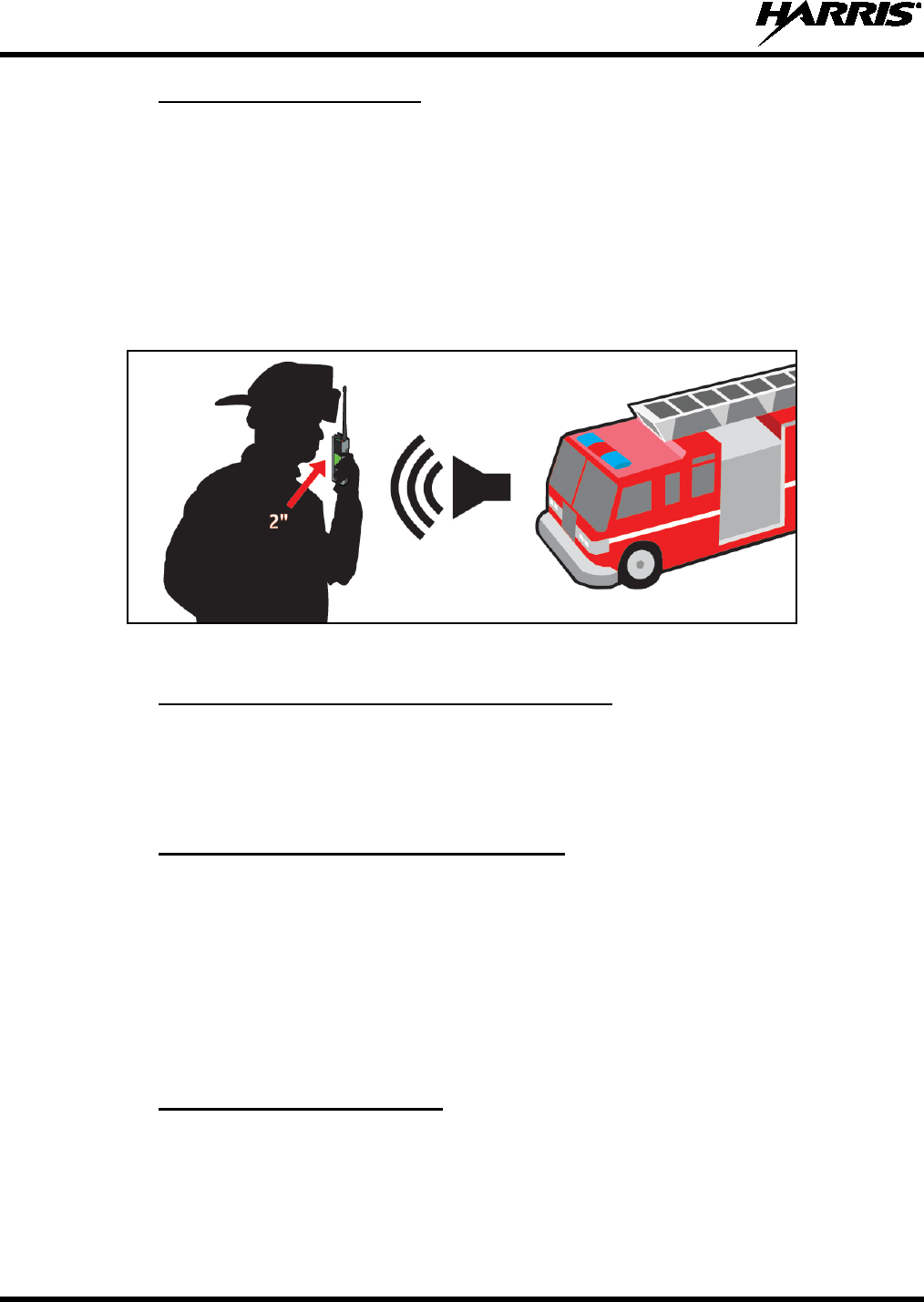
14221-1800-2000, Rev. G
52
5.17.2 Using Noise Cancellation
When using the noise cancellation feature, observe the following:
• Verify NOISE CANCELLATION is enabled (see Section 5.17.1).
• Talk within two (2) inches of the primary microphone (see Figure 5-5).
• Ensure the primary and secondary microphones are not covered. See Section 5.17.4 for more
information on the primary and secondary microphones.
• Speak clearly, loudly, and with authority.
• In very noisy environments, it is o.k. to yell into the radio. The radio can handle loud input levels.
Figure 5-5: Using Noise Cancellation
5.17.3 The Effect of Distance from the Microphone
Unlike a normal microphone system, noise cancellation makes the level of your voice diminish quickly as
you move away from the radio. The radio starts to see your voice as surrounding noise. Whereas, you
may be comfortable speaking up to a foot away under normal operation, noise cancellation requires that
you hold the radio close.
5.17.4 Primary versus Secondary Microphone
5.17.4.1 Without a Speaker Microphone Attached
The primary microphone is located on top of the radio and the secondary is on the bottom of the radio
(refer to Figure 5-1 for microphone locations).
5.17.4.2 With a Speaker Microphone Attached
When a speaker microphone is attached, the radio electronically switches over to use the radio’s top left
microphone as secondary. The microphone on the attached speaker microphone becomes primary.
5.17.5 When using an SCBA Mask
When using an SCBA mask, the primary microphone can be held directly against the voice port. If the
SCBA has a voice amplifier, the same rule applies. Ensure that the secondary microphone is uncovered. If
possible, point the secondary microphone toward the noise source.
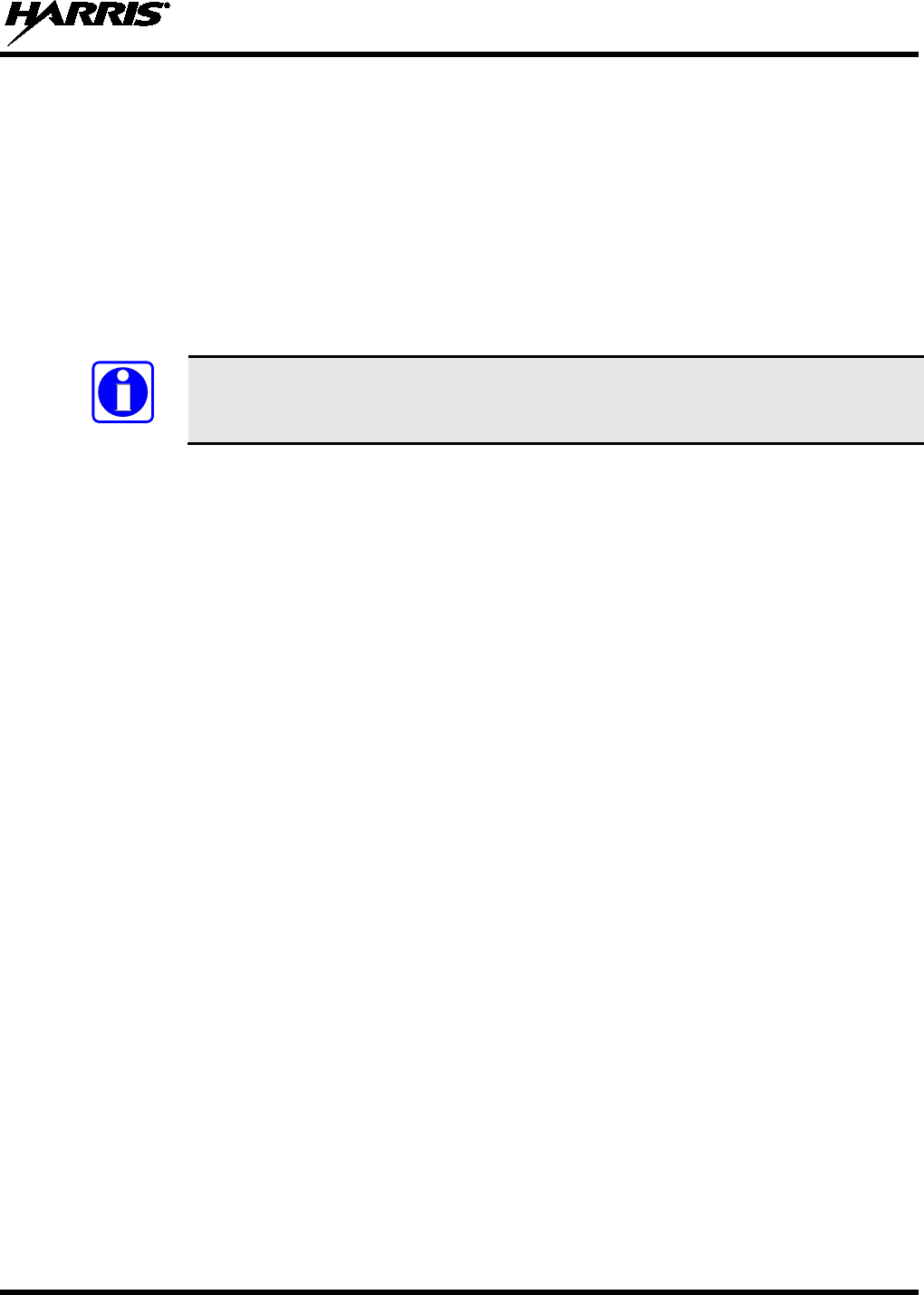
14221-1800-2000, Rev. G
53
5.18 PTT OPTIONS
The radio can be programmed via RPM2 with one of the following PTT options:
• Radio and Accessory - In this mode, when the radio is PTT’d the audio source will correspond with
the PTT source.
If the source of PTT is radio, the audio is routed via the radio microphone.
If the source of PTT is an external microphone accessory, the audio is routed via the external
microphone accessory.
• Accessory Only - Any PTT input will have the audio routed through the external microphone
accessory.
The Bluetooth Speaker Mic is unaffected by this setting. PTTing the Bluetooth Speaker
Mic always results in audio being routed via the Bluetooth Speaker Mic.
5.19 VOICE ANNUNCIATION
When enabled via programming, Voice Annunciation provides audible feedback for various radio
operations. The radio can be programmed to play an audio message for any or all the following. This
message can be a pre-recorded (canned) message or a user-recorded message.
• Zone changes
• Channel changes
• System changes
• Encryption On/Off
• Noise Cancellation On/Off
• Scan On/Off
• Talkaround On/Off
• Monitor Mode On/Off
• 2 or 4 Position switch change
For more information on configuring the radio for Voice Annunciation, refer to the Voice Annunciation
Feature manual 14221-7200-6110.
NOTE
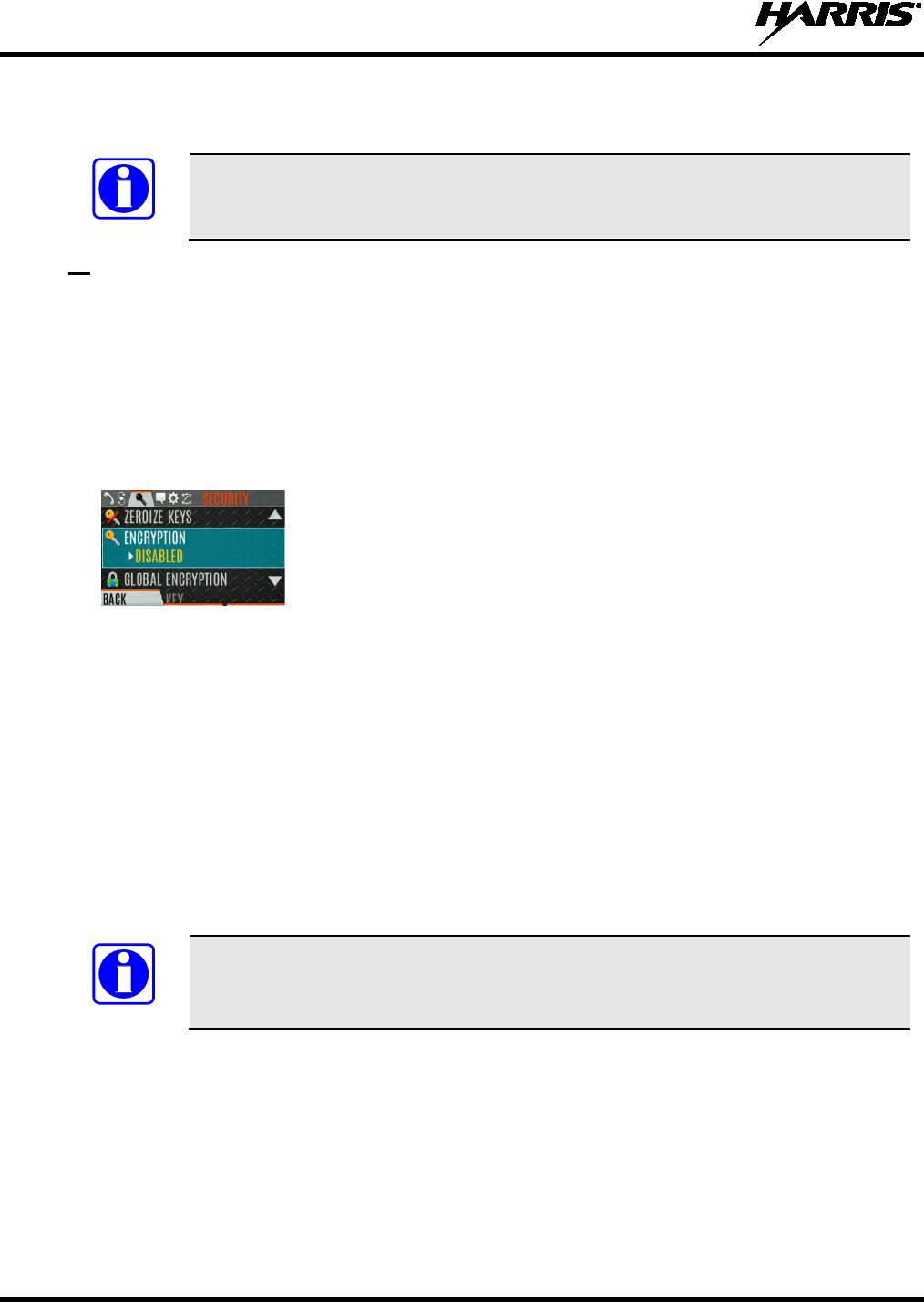
14221-1800-2000, Rev. G
54
5.20 ENABLE/DISABLE ENCRYPTION
A switch or a button on the radio can be programmed to enable/disable encryption.
See Section 7.4
for the various options that can be programmed to the radio buttons
and switches.
Or
Turn encryption on or off via the Security Menu:
1. Press the Menu/Select button to access the menus.
2. Use the left or right navigation buttons button to highlight and select the SECURITY menu.
3. Use the up or down navigation buttons button to highlight ENCRYPTION. Toggle encryption
enabled/disabled using the Menu/Select button. This option is grayed out if any switch is
programmed for encryption, or if Encryption Mode in the radio’s personality is programmed “Forced
On.”
• If a channel is programmed to be encrypted, an optional key icon appears on the main display when
encryption is enabled. The system must also be programmed for encryption.
• When encryption is enabled and you use any channel not configured for encryption, the radio allows
PTT. The signal is transmitted unencrypted.
• Systems configured for Global Encryption (enabled in the Security menu) can display an optional
Global Encryption icon in addition to or instead of a key icon (Section 6.20.3).
5.21 TRANSMIT ENABLE/DISABLE
When transmit is disabled, all forms of transmission from the radio are disabled, including Bluetooth.
This is designed for use in explosive atmospheres.
If enabled via programming, use the A/B switch to enable or disable transmit.
See Section 7.4
for the various options that can be programmed to the radio buttons
and switches.
NOTE
NOTE
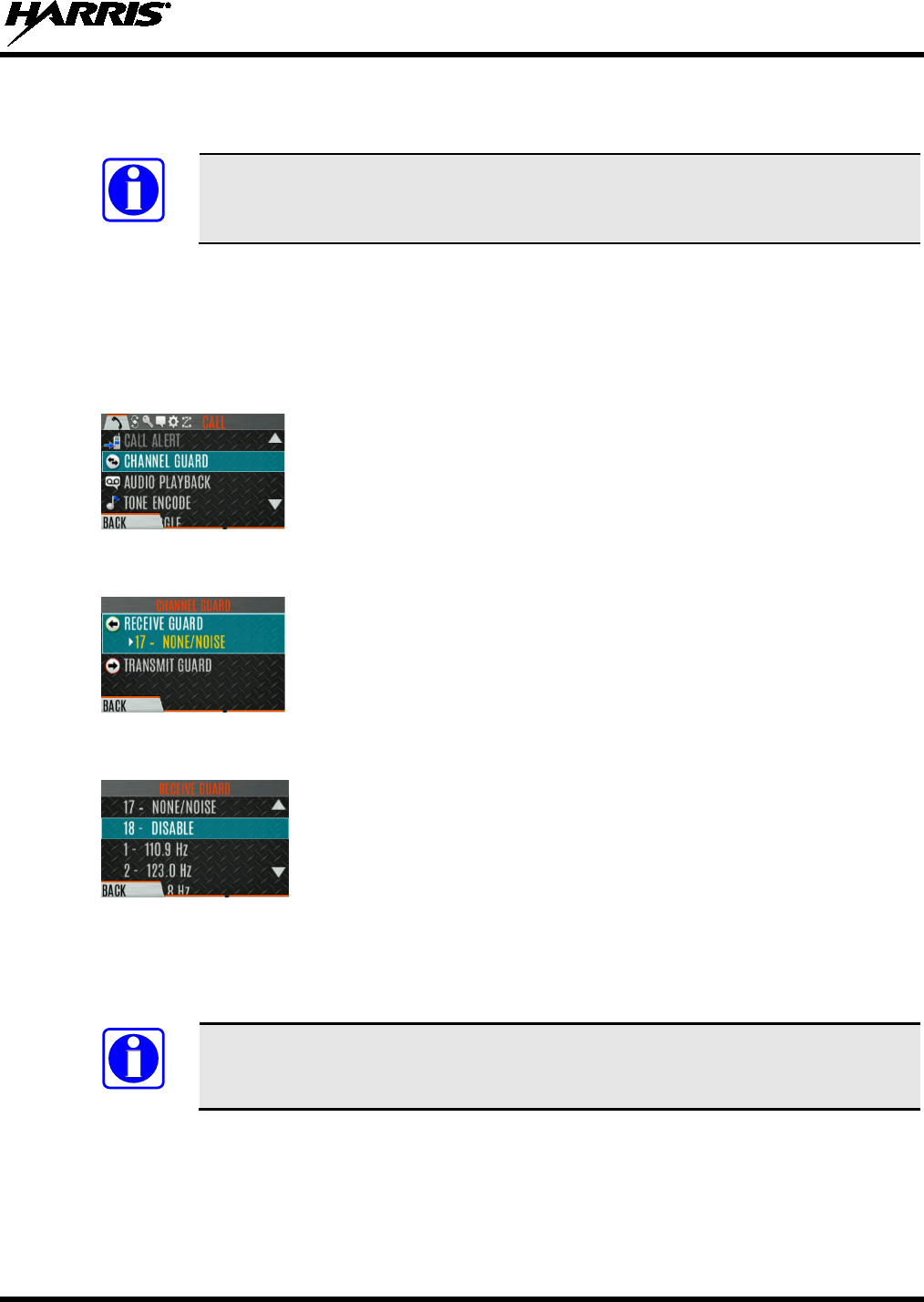
14221-1800-2000, Rev. G
55
5.22 CHANNEL GUARD (ANALOG CONVENTIONAL ONLY)
Channel Guard is Harris’s trademark for CTCSS (tone squelch) and CDCSS (digital tone squelch).
The Channel Guard menu is only accessible if the System is setup for CG SEL in the
radio’s personality.
To select the Channel Guard tone:
1. Press Menu/Select button to access the main menu.
2. Use the left or right navigation buttons to display the CALL menu.
3. Use the up or down navigation buttons to highlight CHANNEL GUARD and press the Menu/Select
button.
4. Use the up or down navigation buttons to highlight RECEIVE GUARD or TRANSMIT GUARD
and press the Menu/Select button.
5. Use the up or down navigation buttons to highlight the desired option from the list and select using
the Menu/Select button.
6. The Channel Guard frequency is displayed on the main display.
The Channel Info screen and Channel Edit screen will change depending on this selection. See Sections
6.4 and 7.2 for more information.
A button on the radio ca
n be programmed for Channel Guard Override (see Section
7.4).
NOTE
NOTE
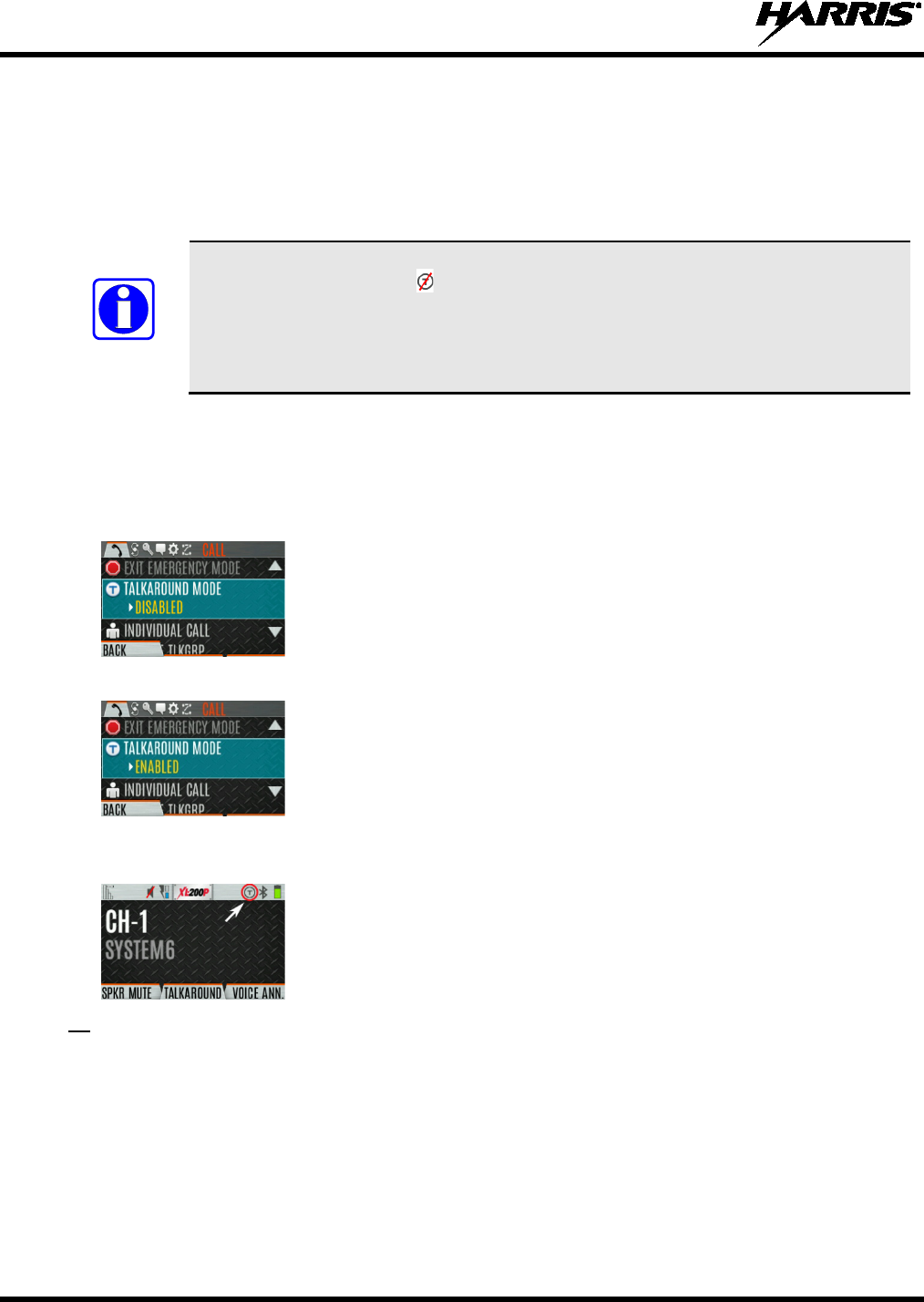
14221-1800-2000, Rev. G
56
5.23 USE TALKAROUND TO BYPASS REPEATER (ANALOG AND P25
CONVENTIONAL ONLY)
You can bypass the repeater system to communicate directly with other radios on your current channel’s
receive frequency. This is useful if you are out of range of a repeater or if a repeater is busy. You will
need to be in range of the other radio.
In XLP R4A and later, talkaround can be enabled/disabled on a per-channel basis.
When T/A is disabled, the icon is shown on the front and top display. If Talkaround
is disabled for a channel (via the RPM2 personality), and the user tries to enable
Talkaround via the menus or knobs while on that channel, the radio emits a “boop”
deny tone. Additionally, if T/A is disabled on a channel, the Talkaround programmable
button becomes inoperable and the radio boops.
To enable talkaround:
1. Press Menu/Select button to access the main menu.
2. Press the left or right navigation buttons to display the CALL menu.
3. Press the up or down navigation buttons to highlight TALKAROUND MODE.
4. Press the Menu/Select button to toggle TALKAROUND MODE to ENABLED.
5. The optional Talkaround icon appears. Calls are now made on the receive frequency until you disable
talkaround mode via the CALL menu. Power cycling the radio does not disable talkaround.
Or
A button or switch can be programmed to toggle talkaround enable/disabled. See Section 7.4 for the
various options that can be programmed to the radio buttons and switches.
If the Talk-Around Indication feature is enabled using RPM2, the radio will play a unique grant tone
when a call is placed on a simplex channel or when Talk-Around has been enabled on a duplex
channel. This feature applies to both Analog and P25 Conventional systems. It optionally allows the
radio to also play the same tone when it receives a call while operating in simplex or Talk-Around. If
configured, the radio plays the tone at the selected volume level.
NOTE
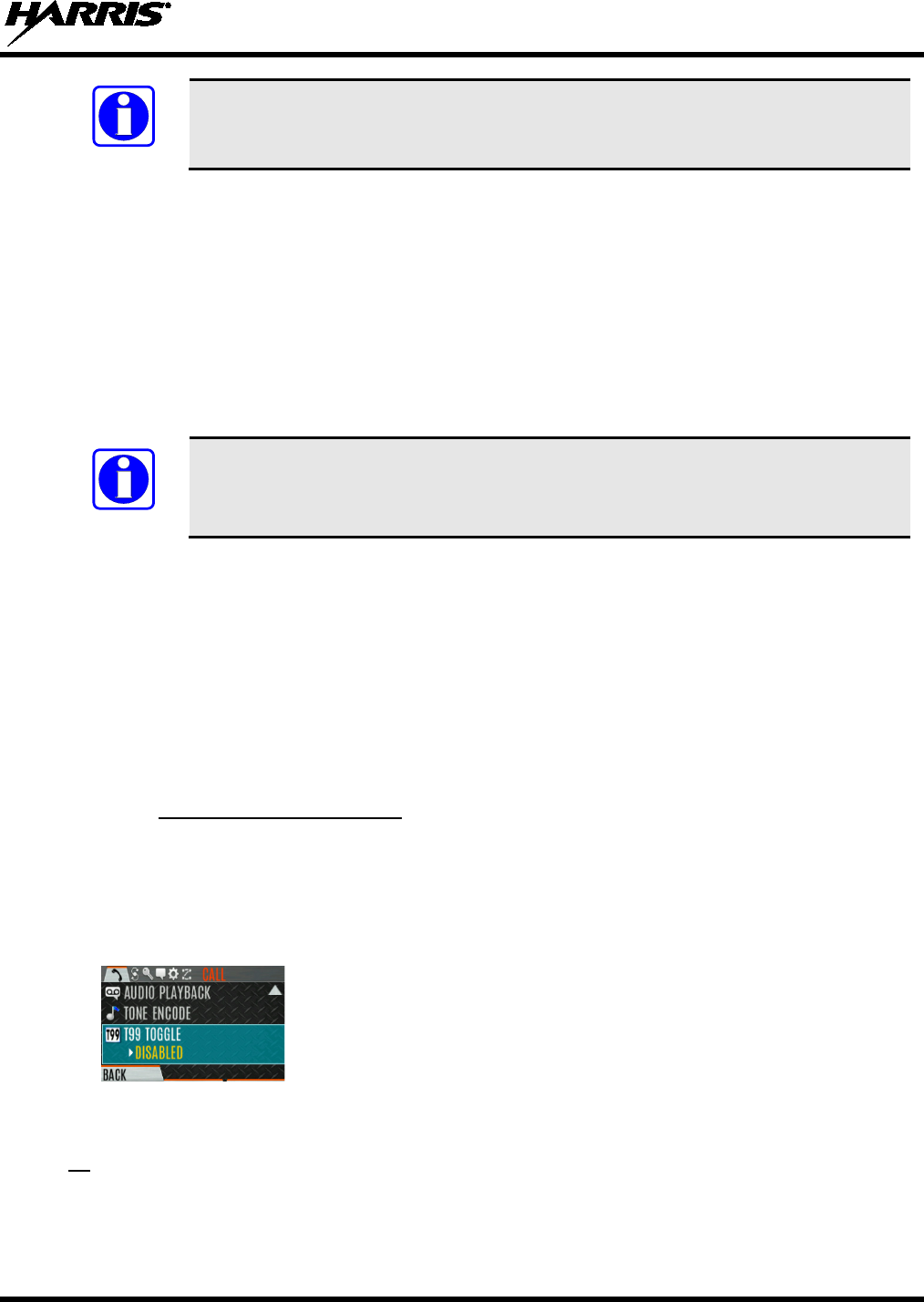
14221-1800-2000, Rev. G
57
The tone will not play on systems configured with MDC.
Talk-Around Indication can be specified for each individual Analog and P25 Conventional system
configured in personality. The following options can be selected, and apply only when the radio is on a
simplex channel or when Talk-Around has been enabled by the user:
• Disabled: (This is the default option.) When this option is selected, the radio plays the standard grant
tone when a call is placed. The radio does not play a tone when a call is received.
• Transmit Only: When this option is selected, the radio plays a different “Talk-Around” grant tone
when a call is placed. The radio does not play a tone when a call is received.
• Transmit & Receive: When this option is selected, the radio plays a different “Talk-Around” grant
tone when a call is placed, and at the beginning of a received call.
In the radio personality, the “Alert Tone” parameter needs to be enabled for each
channel on the Conventional Frequency Set. The “Ready to Talk Tone” parameter
must also be enabled for the Talk Around Indication tone to be played when the radio
is keyed.
5.24 TYPE 99 OPERATION
Type 99 is Harris' name for in-band, two-tone sequential signaling. It is a conventional signaling protocol
used to control the muting and unmuting of a radio. This signaling is commonly used for selective calling
of individual units or groups of units in a conventional system.
In Type 99 tone systems, calls are not heard until the radio detects the proper two-tone sequence. This, in
conjunction with squelch, prevents the user from hearing noise or undesired conversations. When the
radio detects the second tone, it sounds the appropriate Type 99 alert tone. After the second tone stops,
the receiver audio path is opened for the user to receive messages.
5.24.1 Enable/Disable Type 99
To enable Type 99:
1. Press Menu/Select button to access the main menu.
2. Press the left or right navigation buttons to display the CALL menu.
3. Press the up or down navigation buttons to highlight T99 TOGGLE.
4. Press the Menu/Select button to change T99 TOGGLE between ENABLED and DISABLED. T99
is displayed in the top of the radio display when Type 99 is enabled.
Or
A button or switch can be programmed to enable/disable Type 99 (see Section 7.4).
NOTE
NOTE
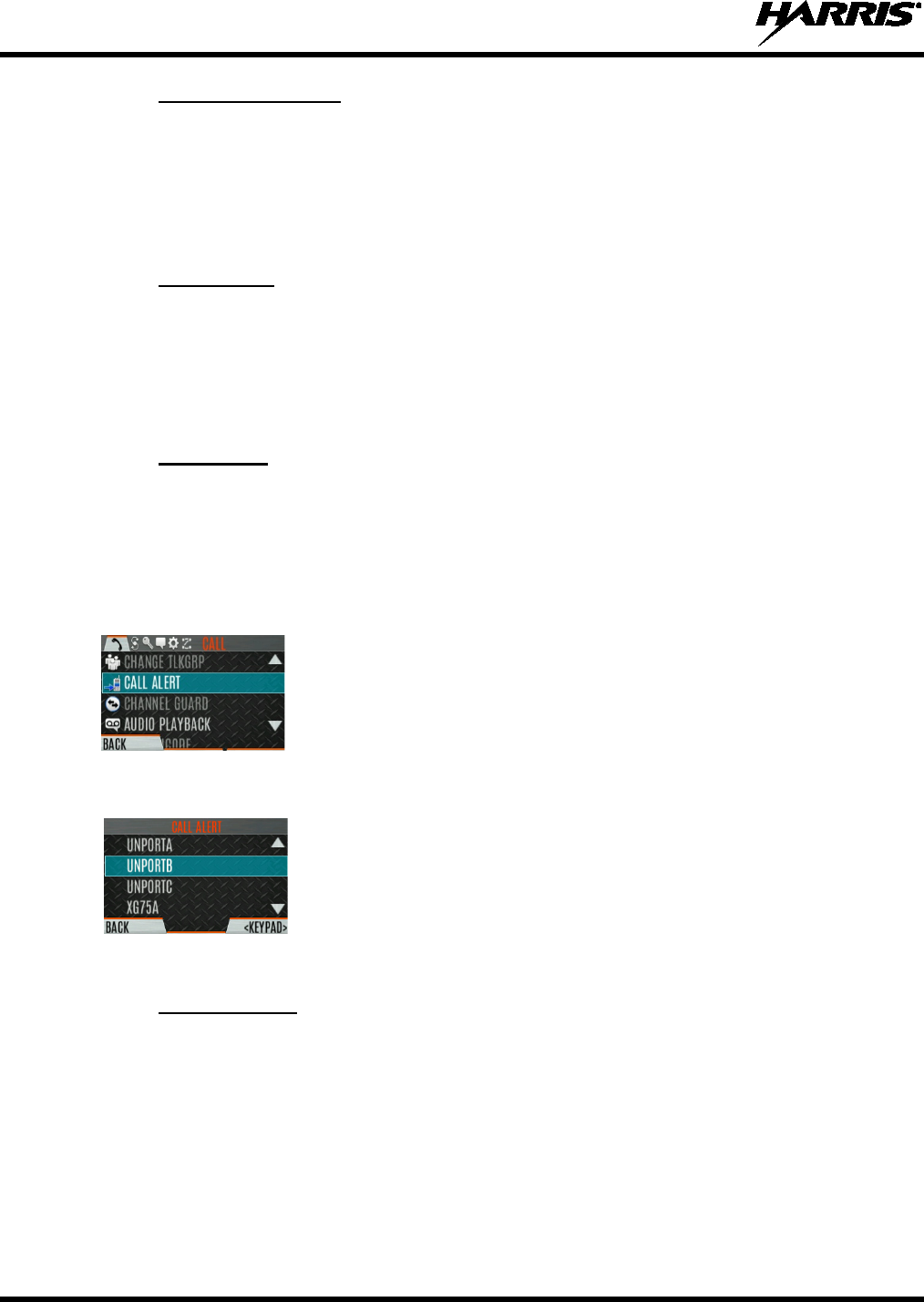
14221-1800-2000, Rev. G
58
5.24.2 Disable After PTT
If this option is programmed using RPM2, Type 99 is disabled after the radio user activates the PTT. This
allows the radio user to monitor traffic on the channel (after a PTT action) without pressing the monitor
button.
Can be used in conjunction with the “Auto Reset” option (see Section 5.24.3) to disable Type 99 after a
PTT and automatically reset, or enable, Type 99 after 30 seconds.
5.24.3 Auto Reset
If this option is programmed using RPM2, Type 99 is automatically reset, or turned back on, after 30
seconds. Can be used in conjunction with the “Disable After PTT” option (see Section 5.24.2) to disable
Type 99 after a PTT and automatically reset, or enable, Type 99 after 30 seconds.
5.25 CALL ALERT (PAGE)
5.25.1 Send Alert
To send an alert:
1. Press the Menu/Select button to access the main menu.
2. Press the left or right navigation buttons to display the CALL menu.
3. Press the up or down navigation buttons to highlight CALL ALERT and press the Menu/Select
button.
4. Press the up or down navigation buttons to highlight the desired unit from the list and press the
Menu/Select button, or select KEYPAD to enter the Unit ID.
5. Press PTT to send the page.
5.25.2 Receive Alert
1. When receiving a Call Alert, the radio displays the calling radio’s name or Unit ID.
2. The radio rings and indicates a missed call. The ring sounds continuously until you press PTT, press
the CLR MISSED softkey, change group/system, or power cycle the radio.
5.26 DTMF
The XL-Portable supports the transmission of DTMF tones corresponding to the numbers/characters on
the keypad. To overdial numbers/characters, press and hold the PTT button, and then press the
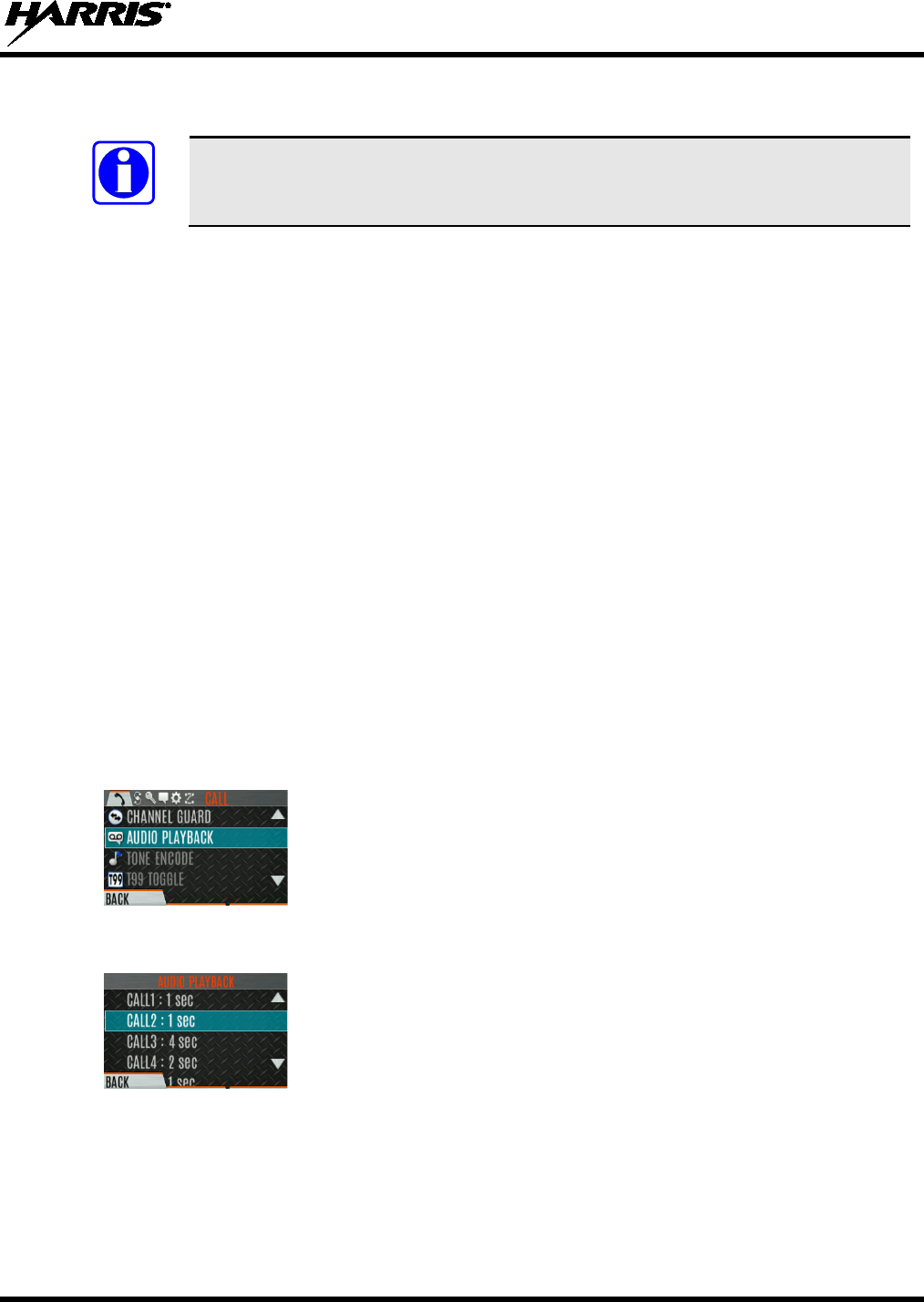
14221-1800-2000, Rev. G
59
corresponding keys one at a time on the keypad. Valid keys for DTMF tones are: 1, 2, 3, 4, 5, 6, 7, 8, 9, *,
0, and #.
For conven
tional or P25 Conventional systems, DTMF tones only play if the current
system is programmed for DTMF (part of general System configuration). DTMF tones
are always enabled for P25 Trunking systems.
5.27 AUDIO PLAYBACK
The Audio Playback feature allows the user to playback a previously received call. Recordings are stored
in the radio’s RAM and are not persistent across power cycles. The radio stores the last five (5) recorded
calls up to 1 minute each.
A button on the radio can be programmed to replay the last recorded call. To playback the last received
call from a button:
1. Press the button programmed for audio playback. The last call received before the button was pressed
is played each time the button is pressed.
2. Additional incoming calls will be recorded in the background, but pressing the button continues to
replay the captured call until reset.
3. To reset the feature and allow a new call to be captured, press and hold the button until you hear a 2-
tone chirp. At this point, the button can be used to capture a new incoming call.
You can also playback one of the last five calls received via the menu.
To playback a previously received call from the menu:
1. Press the Menu/Select button.
2. Press the left or right navigation buttons to display the CALL menu.
3. Press the up or down navigation buttons to highlight AUDIO PLAYBACK and press the
Menu/Select button.
4. Select the desired call from the list (the most recent call is at the top of the list) and press the select
button. The selected call will be played.
• If a button is also programmed for Audio Playback, pressing the button replays the call that
selected in the menu. The feature must be reset as above to use the button to capture a new call.
• If a button is not programmed for Audio Playback, then you must navigate back to the menu to
play the call again.
NOTE
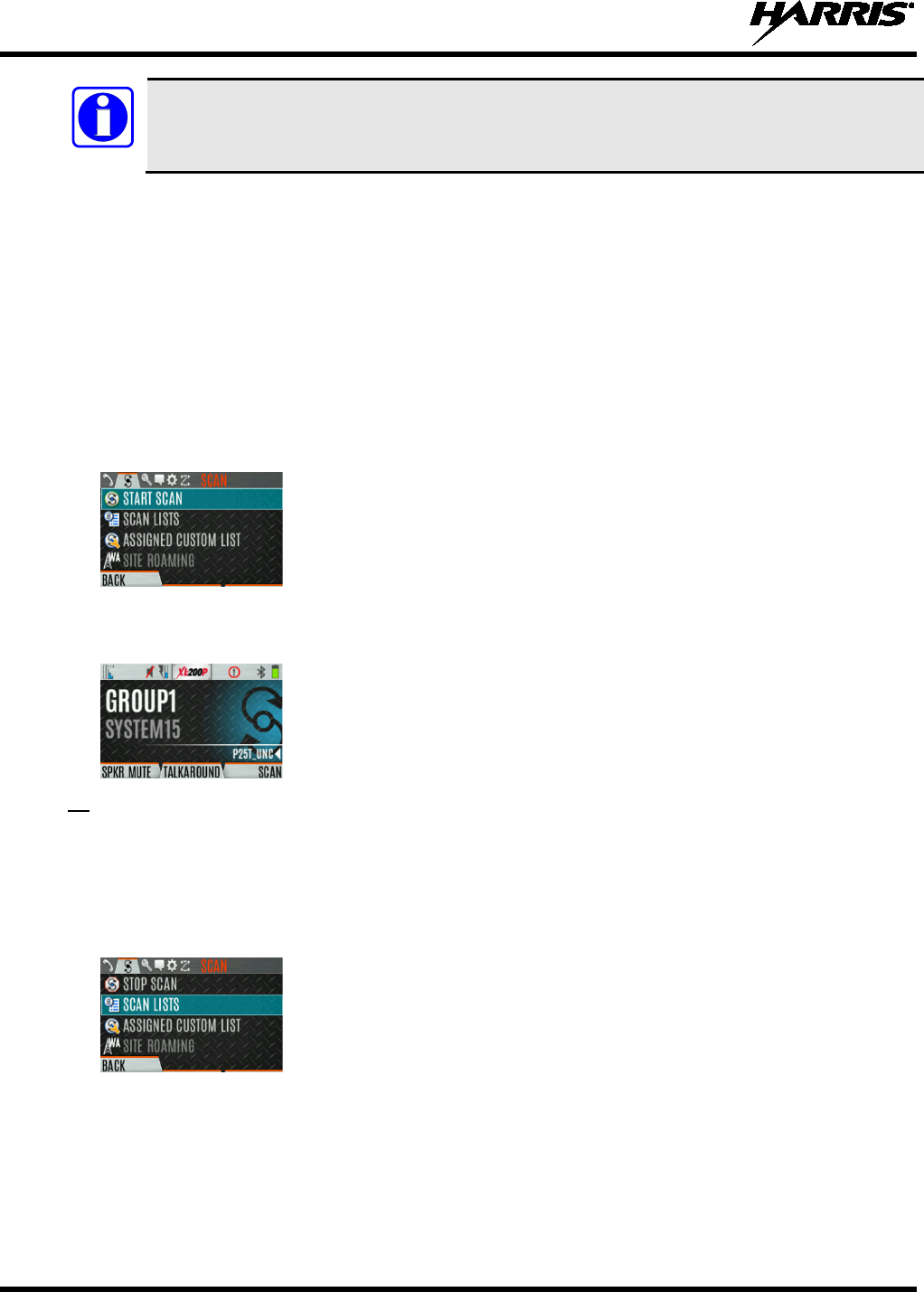
14221-1800-2000, Rev. G
60
Any incoming call that occurs during playback preempts the playback.
5.28 START SCAN
This procedure assumes that the scan list has been added and the radio is not in active scan. Refer to
Section 6.13 for scan setup or Section 5.29 for stopping scan. Refer to Section 6.14.1.1, Section 6.14.1.2,
and Section 6.14.1.3 for home and priority channel descriptions.
To start scan:
1. Press the Menu/Select button to access the main menu.
2. Press the left or right navigation buttons to display the SCAN menu.
3. Press the up or down navigation buttons to highlight START SCAN and press the Menu/Select
button. START SCAN text changes to STOP SCAN.
4. Press the BACK soft key to exit the scan menu.
5. The scan icon is displayed on the idle display when scanning is enabled.
Or
To start scan:
1. Press the Menu/Select button to access the main menu.
2. Press the left or right navigation buttons to display the SCAN menu.
3. Press the up or down navigation buttons to highlight SCAN LISTS and press the Menu/Select button.
4. Press the up or down navigation buttons to highlight the desired SCAN LIST and press the START
SCAN soft key.
NOTE
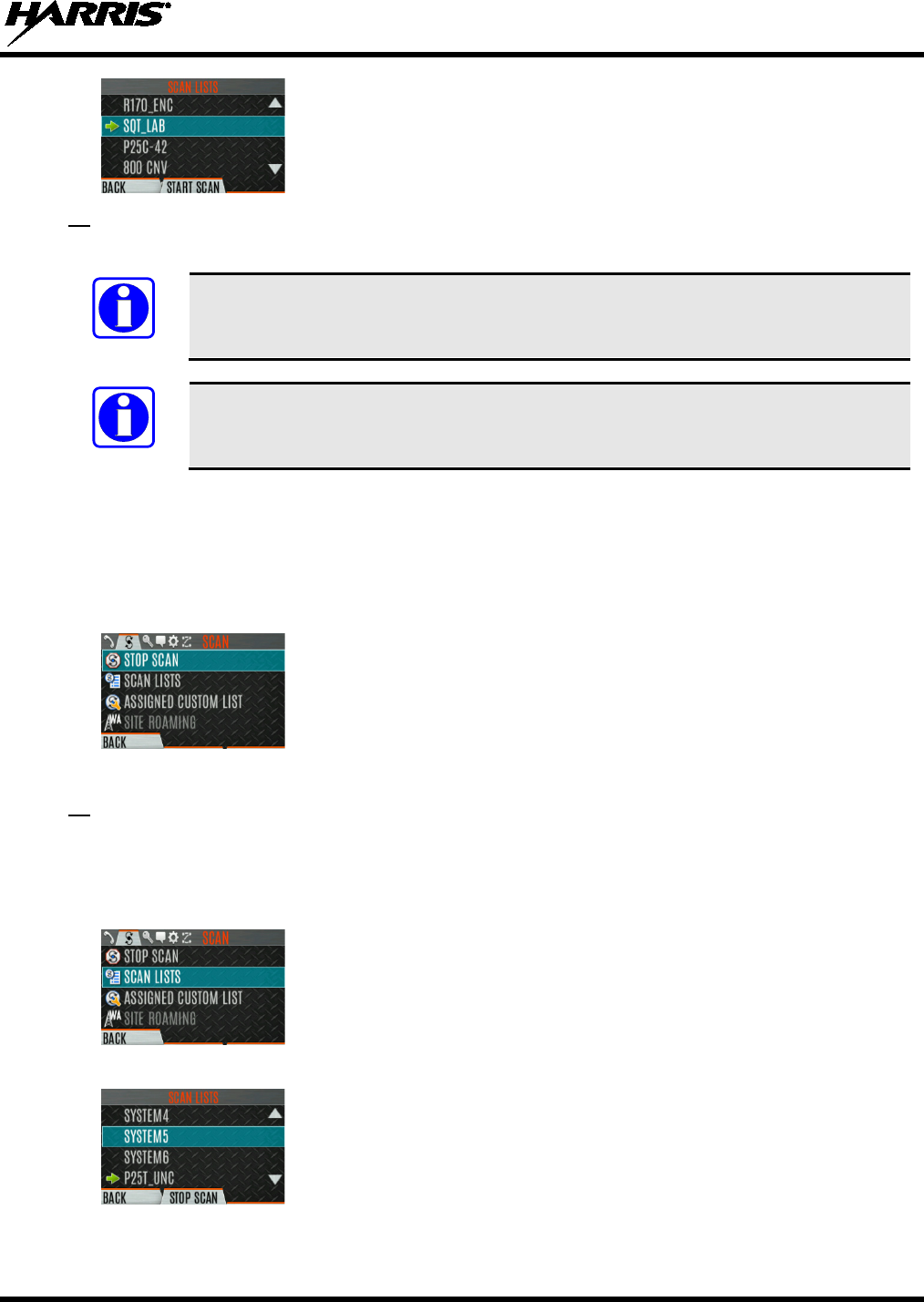
14221-1800-2000, Rev. G
61
Or
A switch or button on the radio can be programmed to start/stop scan.
If a switch is programmed for start/stop scan, the menu for starting and stopping scan
is disabled.
See Section 7.4
for the various options that can be programmed to the radio buttons
and switches.
5.29 STOP SCAN
1. Press the Menu/Select button to access the main menu.
2. Press the left or right navigation buttons to display the SCAN menu.
3. Press the up or down navigation buttons to highlight STOP SCAN and press the Menu/Select button.
4. Press the BACK soft key to exit the scan menu.
Or
1. Press the Menu/Select button to access the main menu.
2. Press the left or right navigation buttons to display the SCAN menu.
3. Press the up or down navigation buttons to highlight SCAN LISTS and press the Menu/Select button.
4. Press the STOP SCAN soft key.
NOTE
NOTE
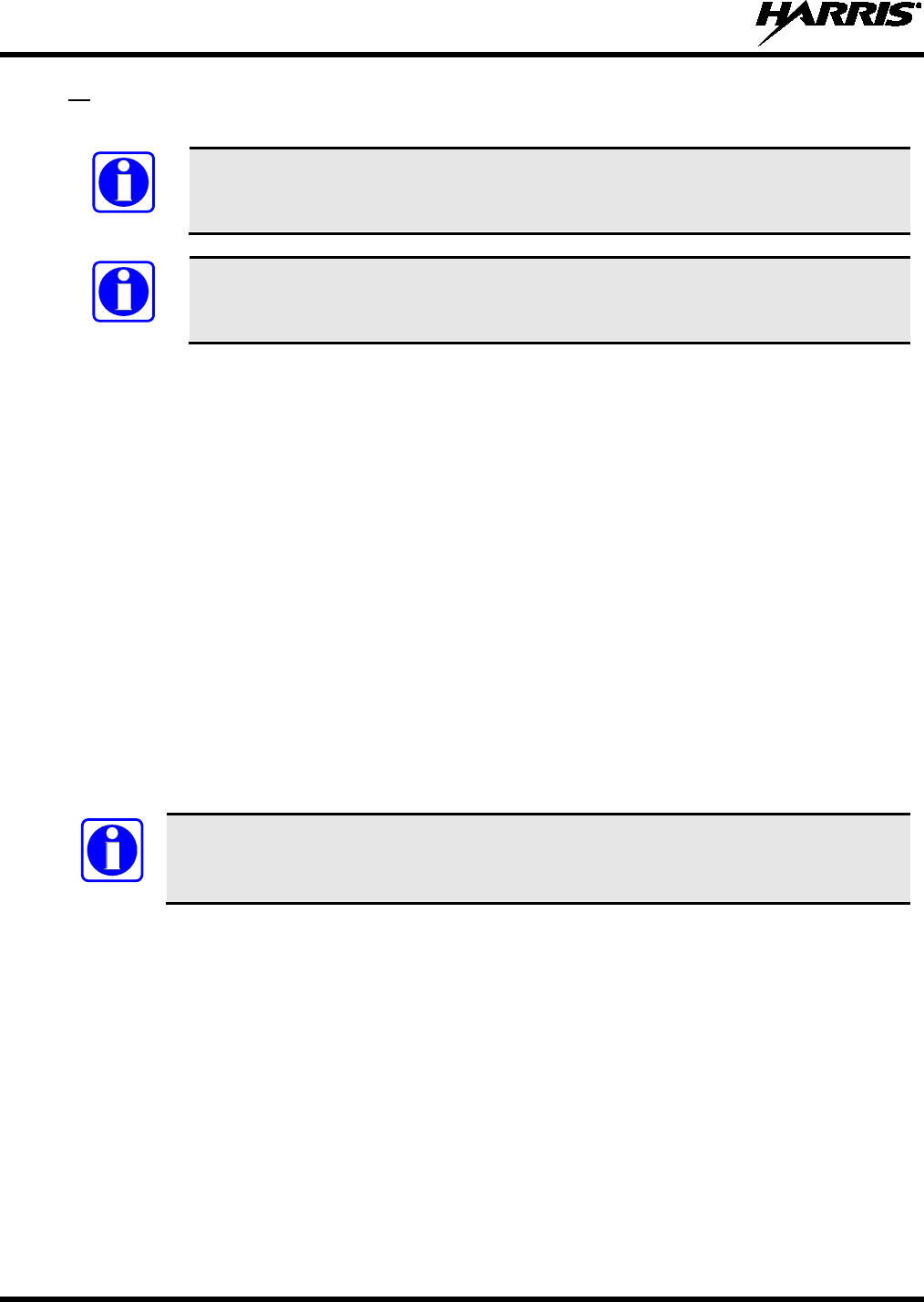
14221-1800-2000, Rev. G
62
Or
A switch or button on the radio can be programmed to start/stop scan.
If a switch or button is programmed for start/stop scan, the menu for
starting and
stopping scan are disabled.
See Section 7.4
for the various options that can be programmed to the radio buttons
and switches.
5.30 MONITOR AND SQUELCH TYPES (CONVENTIONAL ONLY)
The monitor function allows you to temporarily turn off selected squelch to monitor for traffic that may
not normally break squelch. The type of squelch used depends on an analog or digital channel. A button
or switch on the radio can be programmed to start or stop Monitor (see Section 7.4 for the various options
that can be programmed to the radio buttons and switches.).
For analog channels, there is:
• Noise squelch - any received signal breaks squelch.
• Continuous Tone Coded Squelch (CTCSS) - squelch is selective based on tone code.
• Continuous Digital Coded Squelch (CDCSS) - squelch is selective based on digital code.
For digital channels, there is:
• Monitor squelch - any received digital signal breaks squelch.
• Normal squelch - Received Network Access Code (NAC) must be correct to break squelch.
• Selective squelch - Received NAC and talkgroup Identification (ID) or unit ID must be correct to
break squelch.
During encrypted operations, the radio only unmutes when receiving with the same key.
NOTE
NOTE
NOTE
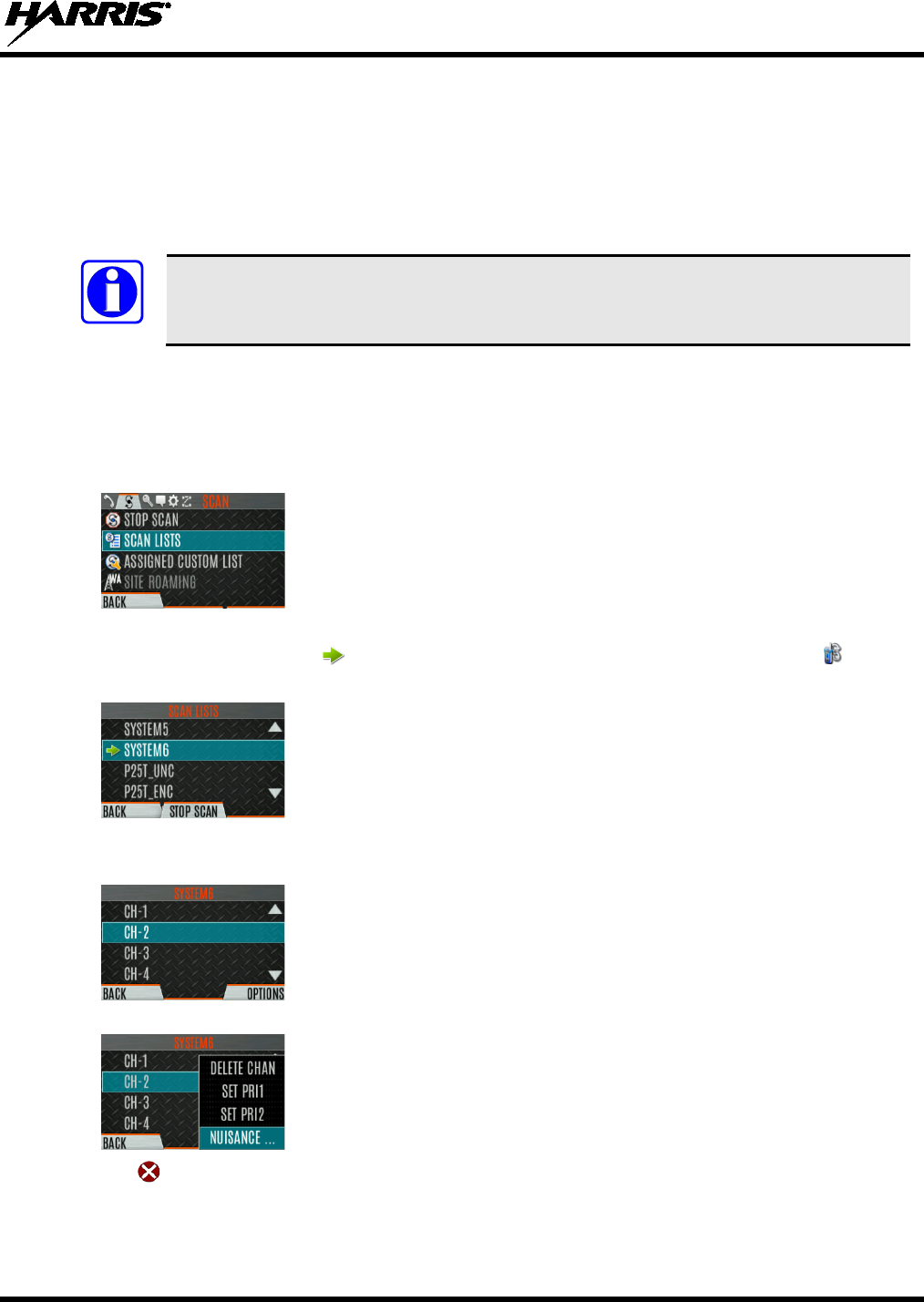
14221-1800-2000, Rev. G
63
5.31 NUISANCE DELETE
A channel can temporarily be deleted from the scan list. The selected channel, priority 1, and priority 2
channels cannot be nuisance deleted.
A button or switch on the radio can be programmed for nuisance delete (see Section 7.4 for the various
options that can be programmed to the radio buttons and switches).
Nuisance delete can only be performed on the active scan list.
To perform nuisance delete from the menu:
1. Press the Menu/Select button to access the main menu.
2. Press the left or right navigation buttons to display the SCAN menu.
3. Press the up or down navigation buttons to highlight SCAN LISTS and press the Menu/Select button.
4. Press the up or down navigation buttons to highlight the scan list and press the Menu/Select button.
When scanning is started, indicates the active scan list; when scanning is stopped, indicates
the active scan list.
5. Press the up or down navigation buttons to highlight the desired channel.
6. Press the OPTIONS soft key.
7. Press the up or down navigation buttons to highlight NUISANCE and press the Menu/Select button.
8. The icon appears next to the channel and it will not be scanned.
NOTE
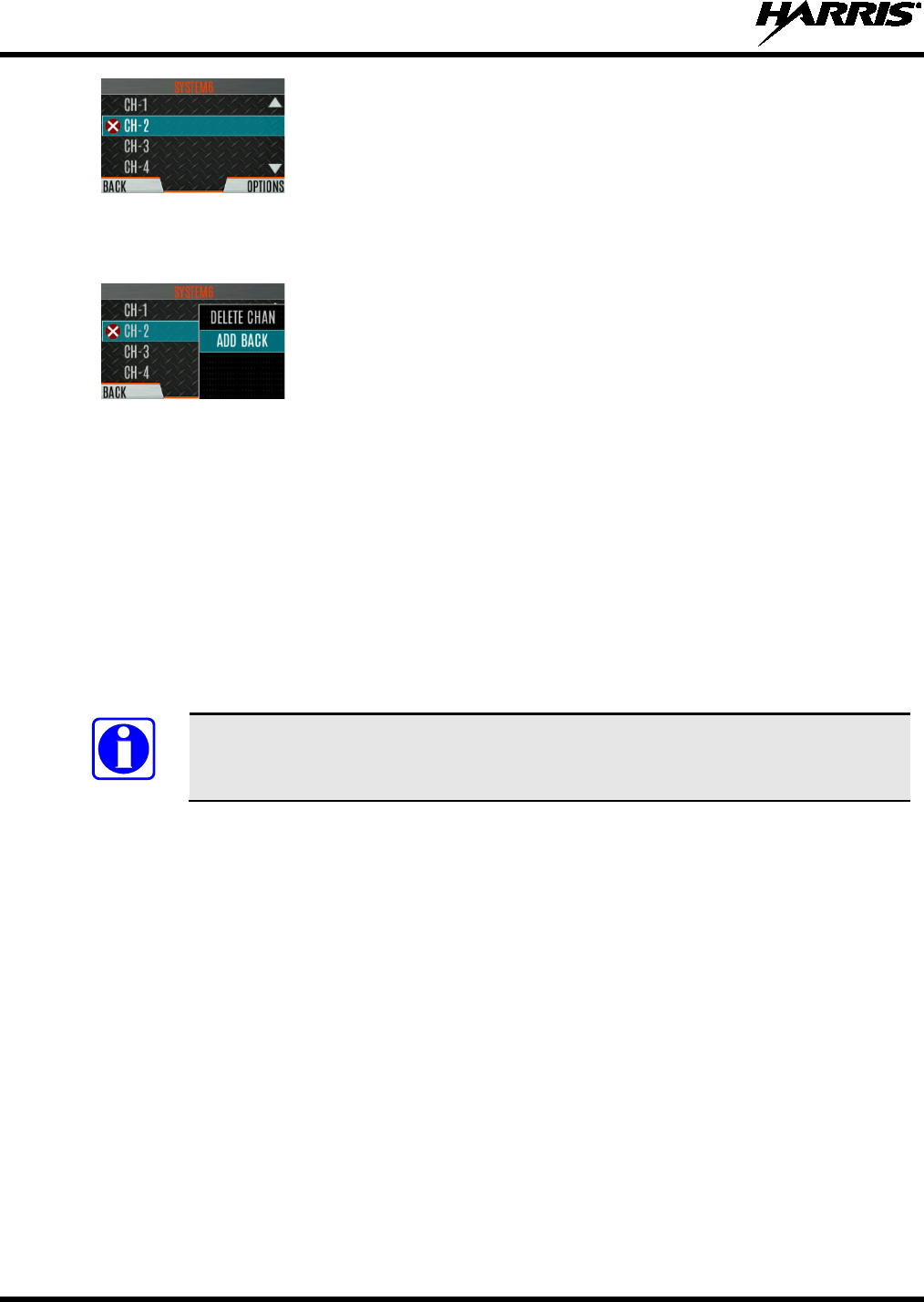
14221-1800-2000, Rev. G
64
9. Highlight the channel, press the OPTIONS soft key, and select ADD BACK to add channel back to
scan list. If you do not add the channel back to the list, the channel will return to the scan list when
you cycle radio power or activate a personality.
10. Press the BACK soft key to exit the channel list.
11. Press the BACK soft key to exit the scan list display.
5.32 CONVENTIONAL FAILSOFT (EDACS ONLY)
In the unlikely event of an EDACS system failure, communications can take place in Conventional
Failsoft mode. The radio is automatically directed to a communications channel set up for this purpose.
An increase in activity on the channel during Conventional Failsoft operation may be noticed, so be
careful not to transmit until the channel is clear.
Operation during Conventional Failsoft is the same as operation on a conventional system, except that it
is not possible to select a communications channel, or use emergency and special call. When trunking is
restored, the radio automatically returns to normal operation.
Emergency and special calls are not operational during Conventional Failsoft.
NOTE
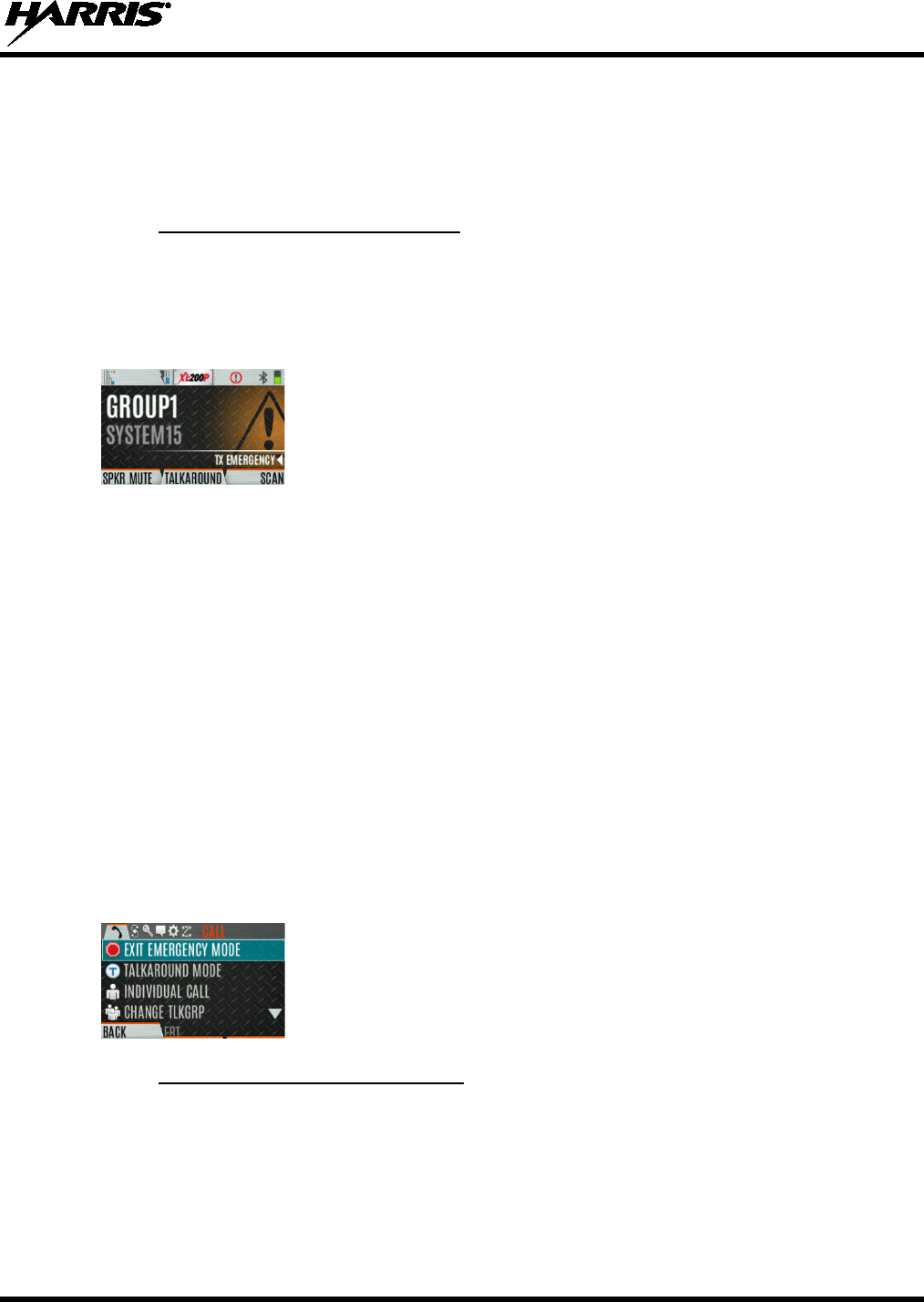
14221-1800-2000, Rev. G
65
5.33 EMERGENCY OPERATION
The radio can be programmed to enable emergency mode. Unit name displays on dispatcher console if an
emergency signal is received from another radio on a digital channel.
5.33.1 Declaring an Emergency Call
To declare an emergency:
1. Press and hold the emergency button on the radio or the speaker microphone. The length of time you
need to hold the button is configured using RPM2.
2. The emergency icon is displayed on the idle display.
• For digital channels, the radio transmits the talkgroup or radio ID to the dispatch console and
receiving radio.
• The radio can be programmed to have a dedicated emergency channel, which can be activated
from analog or digital channels.
• The radio can also be programmed to send an Emergency Alarm in addition to or in place of the
emergency call (P25 modes).
• If enabled via programming, the declaring radio sounds a recurring tone until the battery drains or
the radio is powered off. Alert tone continues to play even after clearing the emergency. This
tone stops during PTT and resumes when PTT is released. This tone is played at max volume and
cannot be controlled with the volume knob.
The radio goes through transmit and receive cycles if so configured. Speak into the microphone while
the radio is transmitting or press PTT to talk.
3. To exit emergency, power cycle the radio or select EXIT EMERGENCY from the CALL menu.
If enabled via programming, you can clear an emergency by pressing the button programmed for the
Monitor/Clear function and then the emergency button.
5.33.2 Receiving an Emergency Call
When receiving an Emergency Call, an alert beep sounds (if tones are enabled) and an emergency
indication is displayed. The unit ID and/or unit name of the unit in emergency is displayed. While the
emergency display is active, press PTT to respond to the emergency caller.

14221-1800-2000, Rev. G
66
5.33.3 Stealth Emergency
The radio can be programmed with the following emergency behavior:
• No audio indications when declaring an emergency.
Or
• No visual indications when declaring an emergency.
Or
• No audio and no visual indications when declaring an emergency.
During stealth mode, the radio will not receive any type of call. Once the user presses the PTT button, the
radio display and audio return to normal.
5.34 MDC-1200 (ANALOG CONVENTIONAL ONLY)
MDC-1200 is a legacy in-band signaling protocol that provides the radio with the ability to transmit and
receive a unique PTT ID. This PTT ID can be decoded by receiving radios and displayed as a
hexadecimal number or an alias string. In addition, MDC-1200 provides radios with the ability to transmit
emergency status to a console. Refer to the MDC-1200 Feature Manual, 14221-7200-6000, for complete
instructions on configuring and using this feature.
5.34.1 Normal PTT Operation
If MDC signaling on PTT press is enabled using RPM2, the radio transmits an MDC PTT ID message
when PTT is pressed. If the Sidetone option is enabled using RPM2, the radio plays a Ready-to-Talk
(RTT) tone after the MDC pre-signaling has been transmitted.
If MDC signaling on PTT release is enabled (using RPM2), the radio transmits post-call MDC signaling
when PTT is released.
• IF STE is enabled (using RPM2), the MDC post-call signaling is transmitted after STE is sent on PTT
release only.
• MDC post-call signaling is also sent when there is a radio unkey due to Carrier Control Timeout
(CCT). Normal CCT alert tones occur prior to unkey.
5.34.2 MDC PTT ID Receive Handling
When the radio receives an MDC PTT ID, it searches the MDC ID Alias List for an alias associated with
the ID. If one is found, it displays the alias. If none is found, the radio displays the ID in hexadecimal.
5.34.3 Emergency Declaration
Emergency declaration is accomplished by the radio generating an MDC Emergency PTT message. An
Emergency is considered acknowledged when the radio receives an “Ack To Emergency” PTT message
with an ID which matches its own ID. If Emergency Audio is enabled and the PTT Sidetone option is
enabled, the radio plays the Ready-to-Talk tone after the MDC Emergency PTT signaling is transmitted.
• If an MDC Alert on ACK is enabled, the radio plays an ACK tone when the MDC emergency is
acknowledged.
• If audio tones are enabled, the radio plays an ACK tone if the emergency is not acknowledged within
the programmed number of retries.
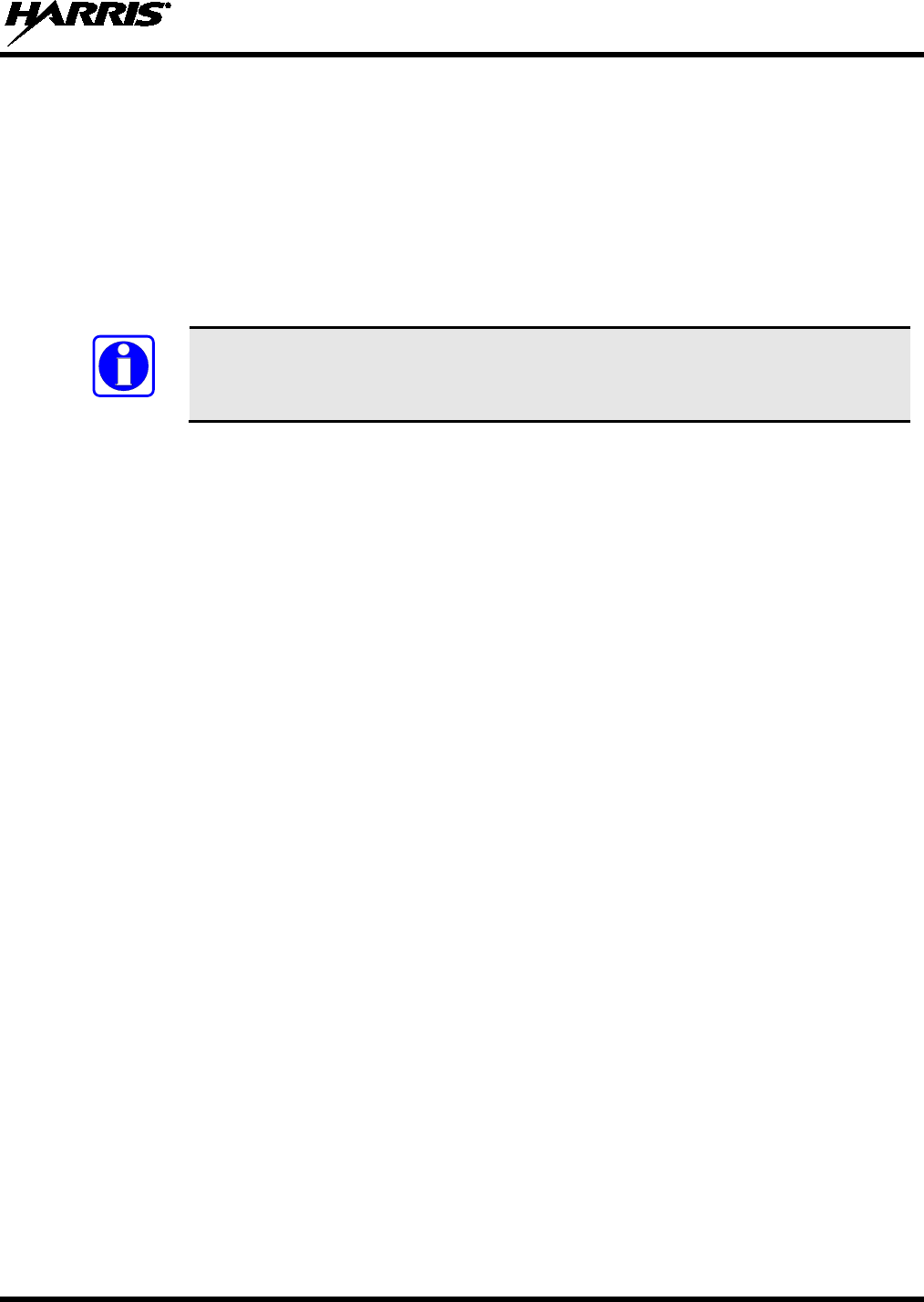
14221-1800-2000, Rev. G
67
5.35 BEON OPERATION
The BeOn solution is a Voice over IP (VoIP) based, Push-to-Talk (PTT) communications system
operating over public or private wireless networks. The solution extends traditional Land Mobile Radio
(LMR) services onto the broadband capable third generation (3G) and 4G/LTE cellular networks. This
includes the ability to provide highly integrated interoperability services between BeOn users on the
cellular network and users of traditional LMR networks. Harris’ VIDA® IP core network switching
technology is the foundation for the BeOn application infrastructure. Thus, the application and product
suite provide many advanced features not found in competing technologies, and provide internetworking
of those services between public and private communications networks.
The XL-Portable supports BeOn operation on Wi-Fi or LTE.
It may be necessary to consult one or more of the following when configuring and using BeOn:
• BeOn Configuration and Use Feature Manual: 14221-7200-6130
• BeOn LAS/LAP Installation and Configuration Manual: 14221-710-3010
• Unified Administration System User’s Manual: MM24374
• RPM2 online help
NOTE
